#boxer's profile boxing stance
Explore tagged Tumblr posts
Text

0929-2008 A Boxer* (Penn State) and his GLOVES! Comments later. 05/21/2024
#collegiate boxer#penn state boxer#raw punching excitement!#nose punching desire#black and white photo#boxer's profile boxing stance
22 notes
·
View notes
Text
Women`s World Boxing: 4 Women Boxers Reached Semi Finals 2024
To understand the new politics stance and other pro nationals of recent times, we should look to Silicon Valley and the quantified movement of the latest generation. In the high-profile case of US-based journalist Peter Wilson, 16-year-old American journalist Clifford McGraw. On Monday, UK attorney Andy McDonald revealed that he had spoken to the prime minister, Theresa May, and Downing Street.…
0 notes
Text
The Right-Wing Campaign to Purge Women From Women’s Sports
New Post has been published on https://sa7ab.info/2024/08/06/the-right-wing-campaign-to-purge-women-from-womens-sports/
The Right-Wing Campaign to Purge Women From Women’s Sports


Algeria’s Imane Khelif, left, in red, and Italy’s Angela Carini after their match at the 2024 Paris Olympics in Villepinte, France, on Aug. 1, 2024. Photo: Eliot Blondet/Abaca/Sipa USA via AP Images
The far right and its fellow gender fascists typically focus their attacks on trans people. When it comes to women’s and girls’ sports — a terrain cherished by anti-trans crusaders — the exclusion of trans women has been a Republican legislative priority, leading even to proposals for abusive genital testing requirements on girls whose assigned sex at birth is questioned. The fact that the latest high-profile case of gender policing is aimed at athletes who were indeed assigned female at birth should, however, come as no surprise.
Right-wing extremists — including Donald Trump, J.D. Vance, Elon Musk — alongside gender-binary zealots like J.K. Rowling are currently hurling vitriol at a cis woman boxer, Imane Khelif of Algeria, following the athlete’s swift defeat of her Italian opponent in an Olympic match in Paris on Thursday. Khelif is a female athlete who was deemed by the International Olympic Committee to be eligible to compete. She is only the latest woman of color in sports to be deemed insufficiently female by a right-wing commentariat obsessed with forging the strictest gender binaries, contrary to social, biological, and medical realities.
Attacks on Khelif — like previous discriminatory treatment of other female athletes like South African middle-distance runner Caster Semenya — reveal the right’s gender ideology for what it is: intellectually untenable and racist. Pointing this out will not stop their vile gender policing; it should, however, give pause to anyone who might entertain Republican and trans-exclusionary positions on gender as worthy even of debate.
On the New York Post’s homepage yesterday, a story by Douglas Murray decried Khelif’s fair win as the “tragic result of letting biological men compete in women’s sports.” (The tabloid published at least five articles about the controversy Thursday, showing the eagerness with which far-right media latches onto anti-trans sentiment.) Across social media, thousands of posts echoed, calling Khelif a “male” or a “biological man” and thus unfairly advantaged. Bigots were swift to glom onto the fact that Khelif, along with another female Olympics competitor from Taiwan now facing attacks, had previously been found ineligible to compete by the International Boxing Association — an organization that has been broadly discredited and officially unrecognized by the IOC.
Khelif was assigned female at birth. The controversy stems from biochemical tests by the IBA that resulted in her removal from their competition, likely because either high testosterone levels or some chromosomal variation was found. We don’t know the details about the IBA’s testing, and Khelif is entirely eligible to compete in the Olympics per its rules. More to the point, high testosterone levels and the presence of XY or XXY chromosomes do not make a person male, or biologically a man. This is a right-wing fantasy, aided in these cases by the practice of so-called sex-testing in sports. I say “so called” because these tests in no way actually test for something so dependent on multiple characteristics and determinations as a person’s sex.
This is worth clarifying only to emphasize the incoherence of the right’s allegedly biology-based sex-gender ideologies, laid bare in the attacks on athletes like Khelif. Firstly, for a political stance so insistent on the capacity to “define woman” in order to distinguish readily, in everyday life, who is and is not a woman, it should be troubling to these gender authoritarians that only the vagaries of sports testing revealed chromosomal or hormonal variations in these adults who had previously lived unchallenged in their assigned sex-gender categories. “In many cases, these athletes had no idea they had chromosomal variations until the Olympic gender-verification authorities gave them their results, right before their events, and found them ineligible to compete,” noted Slate’s Christina Cauterucci.
Were such “sex testing” more widespread, Republicans and their anti-trans fellow travelers would perhaps be disturbed to learn that biology is not on their side: People with chromosomal variations outside the XX, XY binary are not extremely rare — around 1 in 100 people, more common than identical twins.
As New York Times Magazine writer Ruth Padawer noted in an extensive feature on “sex-testing” in sports, endocrinologists and geneticists have for decades challenged the delineations and exclusions such practices purport to draw: “Relying on science to arbitrate the male-female divide in sports is fruitless, they said, because science could not draw a line that nature itself refused to draw.”
Not that this has mattered to numerous regulating bodies and gender conformity zealots. Nor has it mattered that their application of this flawed methodology has a foul legacy of excluding athletes of color.
In what Human Rights Watch calls “practices that violate fundamental rights to privacy and dignity,” sports governing bodies have overwhelmingly selected successful Black athletes for invasive chromosomal, hormone, and genital testing, in order to potentially exclude them from competing. Human Rights Watch reported that the athletes targeted for sex testing are “overwhelmingly women of color from the Global South.”
Strict gender conformity requires expansive authoritarian enforcement far beyond the policing of trans and queer communities and individuals.
The fact that cis women are the victims of this discrimination gives no pause to those committed to trans elimination. In the same vein, women both cis and trans have been attacked in the street by extremists obsessed with identifying and eradicating anyone they feel should not count as women. Strict gender conformity requires expansive authoritarian enforcement far beyond the policing of trans and queer communities and individuals. That it is so often Black and other women of color — the women long excluded from the protections bestowed on white womanhood — who are consistently victims of violent gender policing is not merely a happy accident for the racist far right. Sex-gender exclusions cannot be disentangled from the historically colonialist, white supremacist project of strict sex categorization and gender enforcement.
It would be foolish to suggest that the far right has ever been interested in either biological sciences or, of course, protecting women and women’s sports. If questions of fair competition were really at stake, the fact that Khelif has lost nine previous career fights against other women, including losing to Irish gold medalist Kellie Harrington in the delayed 2020 Tokyo Olympics, would surely give lie to claims of her indefeasibly unfair advantage. The outcry exposes the illogic and intellectual failures of fascistic gender ideology. This does not mean, however, that such reactionary campaigns are best defeated with better arguments based in science and reason, in the form of political debate. The misogynistic, racist policing of bodies deserves only our contempt and fierce opposition. The post The Right-Wing Campaign to Purge Women From Women’s Sports .
0 notes
Text
Muhammad ALI: 15 Career Defining Rounds
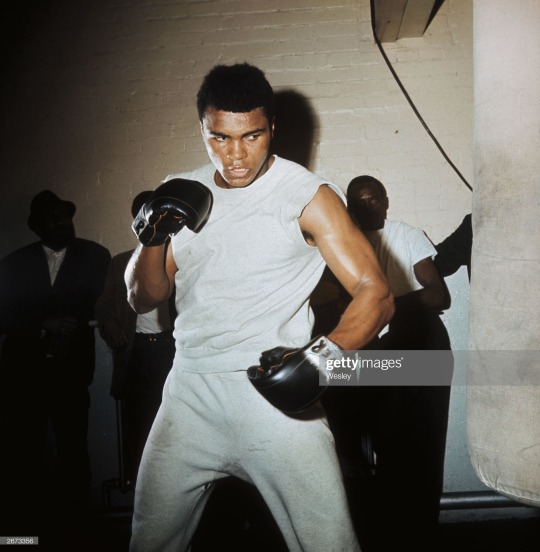
Muhammad Ali fought 548 Professional Rounds against 50 different men across a span of 61 fights, 13 countries, four continents and 21 years. 27 of Muhammad’s fights were scheduled for the 15 round Championship distance, so in this blog I will cover the 15 defining rounds of The Greatest’s career.
Muhammad Ali and Joe Louis are the only fighters in history to win The Ring Magazine Fighter of the Year on more than three occasions, Louis picking up the historic award four times, Ali on a surely never to be matched- six occasions.
He is the only 3-time Lineal Heavyweight Champion in history and he won 5 out of 6 fights against Sonny Liston, Joe Frazier and George Foreman, who most would consider to be 3 of the top dozen fighters to ever fight in the Heavyweight division, the most historically stacked division of all.
In the 1960′s Ali’s in-ring greatness was down to his speed, agility, footwork and athleticism. In these departments Ali was at a level which had never been seen before at Heavyweight, he was a Heavyweight who could move like a Lightweight. His ability to dance and fight up on his toes for entire fights whilst weighing over 200 pounds was something the world had never before witnessed. His unorthodox, original fighting style was so reflective of the man in his individualism and rejection of norms. He also had unmatched psychological strength, which he showed in the first part of his career with a level of self-belief that led him to beat Sonny Liston after six rounds and declare himself to the world as the Greatest who ever lived, aged just 22 years old.
The best examples of Ali’s greatness in the first part of his career came against Cleveland Williams where Ali was perfect, against Sonny Liston where Ali was fighting a champion so dangerous and menacing, he had to be at the top of his game mentally aswell as physically and versus Floyd Patterson, who Ali dominated so emphatically to make look almost second-rate, despite Patterson having a 43-4 record and it being his 12th World Heavyweight title fight.
In the 1970′s Ali’s greatness came from his heart, chin, strategy and in-ring adaptability and intelligence. His psychological strength would play an even greater part in this second half of his career. Ali’s heart would push him through the exhaustion and pain barrier when other men would have said no more, his ability to take a punch to both the head and body showed him to be one of the toughest fighters ever with one of, if not the, best chin ever (quite a turn-up for people who thought his defence was only so good because he was so scared of what would happen if he got hit). His strategies, adaptability and in-ring intelligence showed him to be one of the smartest fighters ever. His psychological strength which came from his powering belief in his God Allah and the causes for which he fought willed him on to triumph on occasions when defeat looked to clasp him in its clutches.
The best examples of Ali’s greatness in the second part of his career came against George Foreman in Zaire (in my opinion the greatest night and fight of Ali- for in this fight he showed everything which made him great) and against Joe Frazier in The Thrilla in Manila.
Ali is not the youngest ever World Heavyweight Champion (Tyson), nor is he the oldest ever (Foreman), his record of 3 time champion has been surpassed (Holyfield), Ali was beaten, Rocky Marciano never lost, Joe Louis reigned longer and made more defences. Yet when I think of the ‘World Heavyweight Champion’ I think of Muhammad Ali. I see him as the true possessor of the Heavyweight crown and everyone since a mere borrower of the title ‘World Heavyweight Champion’. If there could only ever be One True Champion, One King of The Division it would be Ali.
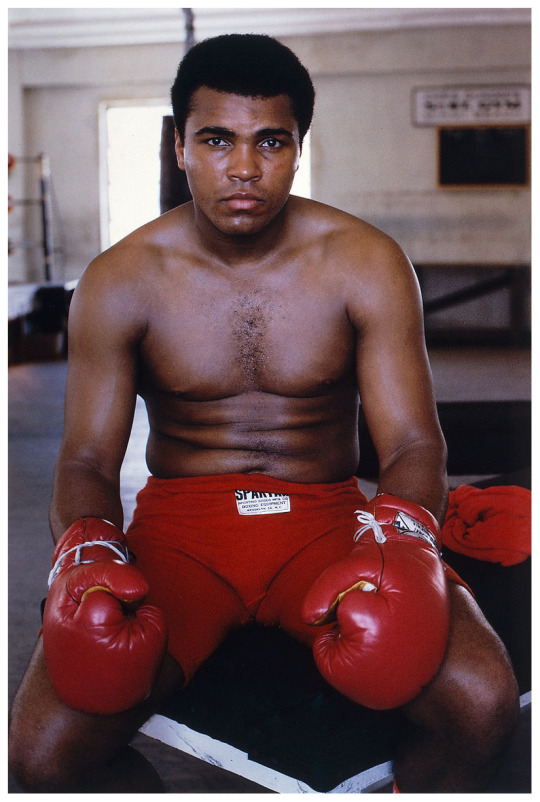
People would dispute that and put forward Ali’s idol Louis. It would be a great fantasy match-up for many reasons, one being it would put Ali in the position of a Holmes or a Spinks when they faced him. Having to try and beat up the man he grew up idolising. If you could remove that mental block by making both men the same age at the same time, well I don’t believe anyone in the history of boxing could beat 64-74 Ali two times out of three and that includes Joe Louis, Mike Tyson or anyone else.
Whereas his status as Greatest of All Time inside the ring is disputed by some who give names such as Sugar Ray Robinson and Joe Louis, outside it Ali’s greatness will remain unmatched. A long book could be written about Ali without even mentioning the fact he was a boxer. His stance against the Vietnam War cost him 3 years of his career at a time when he scarcely looked capable of losing a round let alone a fight. Imagine Lionel Messi after the 2011 Champions League final being banned from football for 3 and a half years for being against a war, it’s unthinkable. But such great injustice was done to Ali and he took it with strength, no self-pity, no hint of regret. If his sacrifice was what his religion taught to be right and if by rejecting Vietnam he was getting millions of Americans who looked up to him to think about whether the war was something they thought was right and wanted to be apart of- then it was worth it.
Ali had an extraordinary love of people. He would sign every autograph, shake every hand, speak to anyone who spoke to him. He wasn’t a presidential candidate, there was nothing to gain from meeting people like this everywhere he went, but for Ali meeting people was reward in itself. He was the most famous person on earth, travelling around with one bodyguard and refusing to leave a place until everyone was satisfied they’d had their own individual fix of The Greatest. His patience for people was limitless as was his time that he would offer to others so willingly. Ali needed the press in the early days, but he certainly didn’t need them after becoming the Champ and one of the most famous men on the earth. But still he chatted with the press more than any other sportsperson, giving them a chance to get to know him and develop a personal relationship with him.

Ali was as generous with his money as he was with his time. It would be impossible to add up all Ali’s charitable contributions as he did not publicise them, all we know is from stories that we’ve heard from his friends. And from what they’ve shared we can gather he was a man who recognised and truly understood the importance of being a high profile person and he valued and made use of his position.
This piece is dedicated to the rounds of Ali’s career which defined Ali the boxer but I couldn’t pass up the chance to briefly mention the man outside the ring. For inside it, he was my favourite boxer ever, outside it, he was my favourite person ever.
Round One- vs Sonny Liston II May 25 1965

37 of Muhammad’s 56 Professional wins were inside the distance, of which 2 came in the opening round. Ali rarely threw anything significant in the opening round of fights, preferring to move around the ring, whilst he assessed his opponent’s strength. One time he did though was in his fourth professional fight against Jim Robinson in what was the shortest fight of his career, ‘Sweet Jimmy’ was gone in 94 seconds.
The second and final 1st Round KO of Ali’s career was significantly more memorable and came in the first of the 19 successful World Heavyweight title defences he would make.
After he shook up the world by dethroning Sonny Liston, a rematch was immediately ordered due to the controversial nature of the first fight’s ending. If what the boxing committee's were after was a more clear cut ending this time out, they most certainly didn’t get it.
The fight was scheduled to take place on November 16th 1964. Finding a venue to take the fight was extremely challenging, controversy was following these two men everywhere and finding a place willing to have them was hard.
The day following the first fight, Cassius Clay announced he was to no longer be known by that name anymore, he was now to be known as Cassius X. Clay was in his words, a slave name, a white name given to his ancestors by their slave-masters. A month later the leader of the Nation of Islam, Elijah Muhammad, renamed Cassius X as Muhammad Ali. Muhammad meaning “worthy of all praise” and Ali meaning “most high”. Ali was given this new name by the Nation to ensure he remained loyal to them and didn’t leave. Malcolm X had left the Nation disillusioned with Elijah Muhammad’s hypocrisy and wanted to take his close friend with him. This ensured that wouldn’t happen.
Before Ali was stripped of his titles altogether in 1967, the WBA stripped him of his title before this rematch meaning that only the WBC and The Ring Titles would be on the line this time. Due to the controversial natures of both fighters the WBA refused to recognise Ali as its Champion and Liston as its number 1 contender, dropping him from their rankings. The WBA also used their power to pressure Boxing state commission's across the country to not give the fight a license to fight in their state. In the end the state of Massachusetts took the fight to be shown at the Boston Garden and their boxing council was therefore suspended by the WBA.
Liston as he did for their first meeting, would go into the fight as favourite. Ali, though given a better chance as champion than he had been as challenger, was still a bigger underdog with the bookmakers than Floyd Patterson had been in either of his two fights with Sonny.
This was because many of Ali’s doubters still remained, he had not silenced them all by becoming the Champion. Sonny fought injured, he threw the fight, the fight was fixed, he’d took Clay too lightly, he hadn’t trained hard, he’d gone in too angry. The list of reasons for Clay’s triumph were endless.
But this time we’d see the real Liston, he’d be determined to erase the humiliation he’d suffered, he’d be better prepared to deal with Ali’s trash talking and mind games, having had the experience of the first fight and he’d train hard this time.
And at first he did, reportedly Sonny had worked his way back to career best shape for their November date. But then 3 days before the bout Ali was rushed to hospital for an emergency hernia operation. He was operated on for 70 minutes and the bout was pushed back six months.
Liston’s motivation left him and never returned. He began to drink heavily, had yet more problems with the law due to driving offences (upon his arrest bottles of vodka were discovered in his car) and as the fight drew closer he seemed to get worse and worse in sparring to the point he looked totally unrecognisable from the fighter he’d been.
The new fight date was set for May 25th but the pre-fight drama wasn’t yet over as 2 and a half weeks before the fight, Boston was no longer to be the fight destination. The search resumed and Lewinston, Maine was decided on (a mill town with a population of 41,000). This was the smallest town to hold a World Heavyweight title fight for 42 years and is to date the only World Heavyweight title fight to take place in Maine.
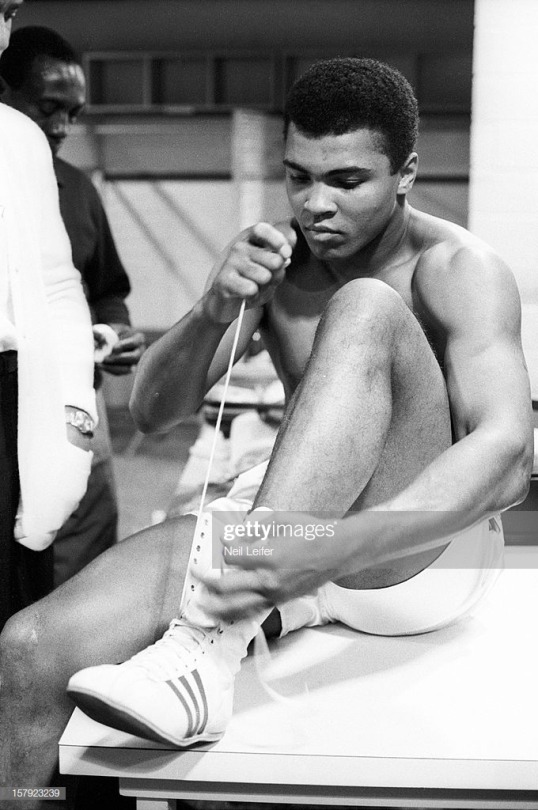
In the exactly 15 months between the 1st and 2nd bout, a lot had changed. Ali had changed his own name from Cassius Clay to Cassius X, had his name changed by The Nation of Islam to Muhammad Ali, he’d met Sonji Roi, he’d married her (and twenty-nine days after this fight he’d divorce her due to her unwillingness to adhere to the rules of Islam, the religion she’d converted to, to be with Ali), he’d fallen out with his once great friend Malcolm X over the latter’s decision to leave the Nation and convert to Sunni Islam (a switch Ali would later also make), and a few months before the fight Malcolm X was killed, assassinated by three members of the Nation of Islam, who put 21 bullets into the 39-year old.
If the build-up before the first meeting had been unpleasant, this time around it was 50 times worse. The arena which held just 4,900 seats was under half-filled. There was tangible fear in the air that night. That the Nation of Islam would assassinate Liston, that the mob or a Malcolm X follower would assassinate Ali. There were even reports of a bomb threat, and security for an event of that time was unlike anything before it.
The belief among the media was that the Nation of Islam was going to attempt to muscle in on boxing and control fighters in the way the mob had done for many years. The Nation of Islam had no interest in boxing beyond Ali. They thought it degrading to black people to fight each other in order to make profit for the white man. But they recognised the importance and value in having the Heavyweight Champion of the World as an outspoken member of their cause, knowing how far afield his words would be reported and therefore what an effective recruiter he could be.
Liston landed just one punch on Ali in the entire fight, he threw several but all but one were a long way short. He stalked forwards but just as in the first fight he couldn’t get close to Ali, who bounced and moved around the ring on his toes. The infamous punch that dropped Liston was the sixth of the fight Ali threw and the fifth he landed. These weren’t flurried taps either, these were hard shots.
The punch that caused the knockdown and subsequent knockout is to this day one of the most debated over and controversial moments in the history of Boxing.
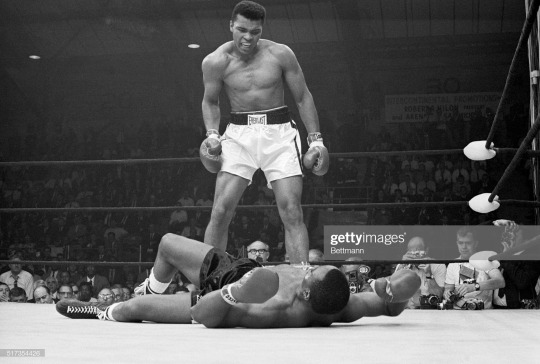
Liston threw a left hand, Ali pulled back to avoid it and in a flash before Liston could bring back his left to protect himself, Ali landed a right bang on Liston’s cheek. Liston fell forwards, landing on his gloves and with his knees still off the canvas he tries to scramble away from Ali who has his fist cocked ready to land another blow, Liston rolls over onto his back and lies completely flat for a few seconds whilst referee Jersey Joe Walcott tries without success to get Ali to go to a neutral corner. Ali is shouting and gesturing at Liston to get up, Ali is eventually moved away from Liston but he is now jumping around the ring wildly. Liston tries to get back to his feet with sudden quick movements but then slowly collapses back to the floor, he eventually gets back on his feet and the referee goes to check on him, he then leaves the fighters to go over to the timekeeper who he could not hear as he did not have a microphone.
The fighters resume for a few seconds before the referee rushes over to separate them, the timekeeper had counted Liston out unbeknownst to the ref, the fighters or anyone else. Ali is declared winner by knockout.
So what the hell happened here? well the mood of the time led people to conclude it was a fix. Liston had took a dive. There were several possible reasons why he would do this, none particularly far-fetched. Maybe the mob had insisted he throw the fight so they could clean up with the bookies by betting on Ali, it wouldn’t exactly be the first time a mob-owned fighter had been instructed to throw a fight, or maybe Liston bet on himself to lose as he owed the mob money and this was a way he could get their money, maybe the Nation of Islam had paid Liston to lose or made a threat against his life should he win the fight.
Why the Nation would doubt Ali’s ability to win the rematch when he’d already beaten Liston is a little unclear, though as they were still new to Boxing and Ali perhaps they were still unaware of how good he was and still believed as the bookmakers did that Liston was the big favourite.
It’s also possible the knockdown was legit. Ali was not a devastating knockout puncher ala a Tyson or a Foreman but he was a big, strong guy who had punching power that deceived opponents who bought into the press’s shtick that he couldn’t hit hard. If you think the same look at fights v Alex Miteff, Bonavena and Richard Dunn and you will see Ali drop guys with single shots.
That said none of those guys were Sonny Liston, a man who’d never been dropped before, who’d gone toe to toe with Big Cat Cleveland Williams the man who throws bombs over 5 rounds across 2 fights and come out victorious on both occasions, walking through Williams’ best shots.
But then again that was prime Sonny Liston of five years earlier and it wasn’t the same Liston. The birth certificate Liston used had him born in 1932, though reports into his birth find it more likely he was born in 1930 which would have put him in his 35th year by the time of the Ali rematch.
It’s also unlikely to be the power that dropped Liston, but the speed of the shot which was blink and you’ll miss it fast. Also the fact that it caught him unsuspecting as he didn’t see the punch. He was on the attack and though used to Ali making him miss, he was not used to Ali making him miss and then countering with a great shot.
From there the problem was Ali wouldn’t go to a neutral corner, he was too hyped up and seemingly angry with Liston, the referee therefore couldn’t begin his count and the timekeeper couldn’t be heard without a mic. The timekeeper had counted Liston out before the ref even got a chance to begin counting. It’s possible Liston was knocked out thanks to the lack of control the ref and timekeeper had over this moment, and if he’d been aware of the count he would’ve got up on time.
Everyone will have their own take on the events that unfolded. In my opinion, the knockdown was legit, Ali caught Liston with a fast, hard shot he didn’t see and it knocked him off balance and to the floor. From there everyone assumes Ali was furiously yelling at Liston to get up because he felt he was deliberately throwing the fight. What’s often overlooked is Ali was the greatest showman, an entertainer and he would often act up like this for the crowd, when he wasn’t really as angry as he was making out to be. Here, everyone believes he was truly angry as it suits the narrative of Liston deliberately throwing the fight.
So the knockdown was I believe legit, but was the knockout? I believe Liston could’ve got up inside 10 seconds if he wanted to. His second fall after trying to get to his feet looked comically fake (that said boxers have ofttimes looked rather ridiculous in the act of trying to get to their feet after a knockdown). But would he have got up in time had he been able to hear a count if referee Jersey Joe Walcott been able to get his started? possibly, I doubt it.
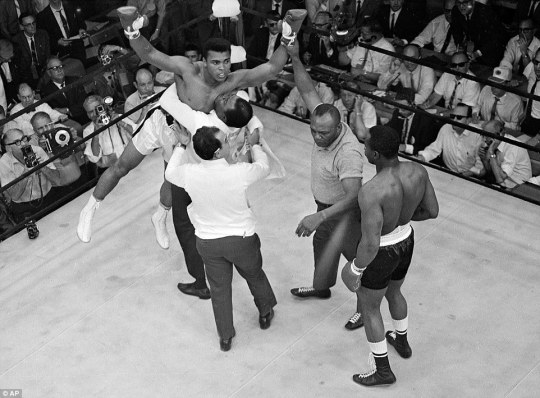
I don’t think Liston wanted to be in there with Ali. He thought Ali was a crazy man and that was the only type of man that scared him. He knew he hadn’t trained well and that Ali was much younger and much quicker. I think he wanted to take his pay check and get out of there. Away from Ali, away from the Black Muslims and away from anyone else who may want to kill him or accidentally kill him in a bid to kill Ali.
This was Liston’s last ever fight for the title. After over a year out he returned and won 14 in a row, he was thought to be just one fight away from a fight with the winner of the Joe Frazier-Jimmy Ellis unification bout but in that last fight he was knocked out in the 9th by a former sparring partner. He fought only once more after that and died in mysterious circumstances six months later.
It was a sad but fitting ending to the career of Sonny Liston. And whilst Jack Johnson is acknowledged as the black man who destroyed the myth of white superiority in the ring by beating up any great white hope they put infront of him, whilst Joe Louis is acknowledged as the first black man who was a hero and even an idol to white youngsters, the third great black Heavyweight Champion, Sonny Liston is mostly remembered for his 2 disastrous fights which gave birth to Muhammad Ali.
If the White Media had any idea what the next Heavyweight Champion of the World was to be like, they’d no doubt have been a bit kinder about Sonny. Who as an illiterate and a man of very few words could have been a champion tolerated by the White media if they’d allowed him to tidy his act up and change.
Round Two- vs Cleveland Williams November 14 1966
Muhammad Ali on the other hand, was certainly not a man of very few words. Nicknamed ‘The Louisville Lip’ Clay was calling out Patterson and Liston just 9 fights into his pro career. He wrote poetry which he shared at every opportunity, he nicknamed his opponents and even declared which round he would knock ‘em out. Amazingly he was very often right. Taking inspiration from the Wrestler Gorgeous George, Clay quickly realised the value of trash talking and self-promotion. An early example of Clay’s ability to sell tickets came in 1963 when he fought fellow contender Doug Jones at Madison Square Garden. It was the first sell-out there for 12 years when Rocky Marciano fought Joe Louis.
He called himself the prettiest, the greatest, said his opponent was a bum, didn’t belong in the same ring as himself, that he would kiss his opponent’s feet in the ring and leave the country for good if he was made to eat his words. And people tuned into see his fights, or they bought tickets for the fight. Ali would win and the act would start out all over again for the next fight. He was a reporter’s dream, he talked and talked and talked.
But then Clay became Ali and started to talk about other things. Things that made the media more uncomfortable. He spoke at length about religion and his leader Elijah Muhammad. And when asked about his religions views on segregation and white people, he didn’t tiptoe around the issue. He tackled the questions head on. Black people had built America through slavery, and now was the time for America to pay black people back by giving them their own land, If America was 10% black people, give them 10% of the land. On segregation he said integration doesn’t work. Slavery, lynchings, castrations, torture of Black people by whites proved integration doesn’t work. On white people he said all his life he had been whitewashed to believe everything and everyone good was white. Jesus, the apostles, angels and Santa Clause to name a few. He also agreed with the Nation’s opinion of the American White man as a blue eyed devil, citing four hundred years of ill treatment from whites to people of darker colours.
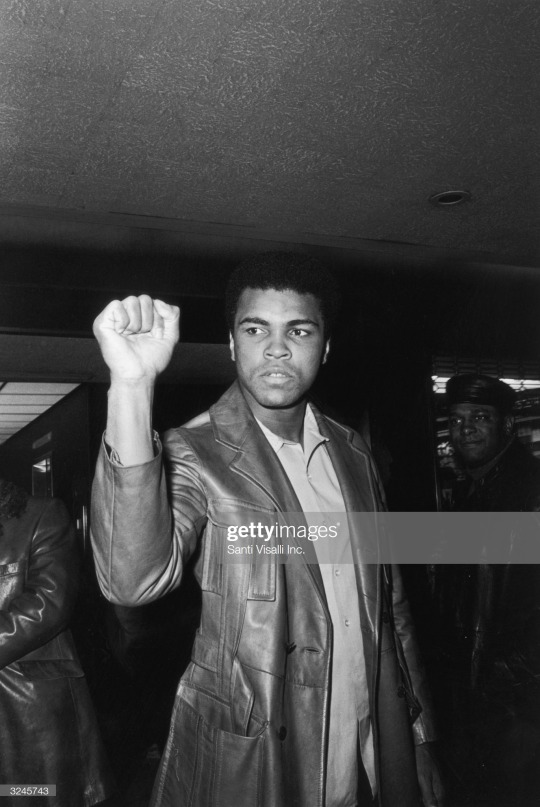
As time has moved on, Ali’s views at the time can be quite shocking and disappointing to his fans who were not around at the time, even though Ali certainly did not hold the same views long into his life.
But it was rather hypocritical of the media at the time to criticise Ali’s want for segregation when they already lived in a country with segregated buses, toilets and water fountains. Ali’s wish for segregation is I think understandable given how bad life was for most black people living in America at the time, and with slavery only officially ended 100 years earlier, most living blacks had parents, grandparents or great grandparents who had been slaves in America.
Ali saw great injustice done to blacks by whites, he saw the hatred whites had for blacks and he couldn’t see a way they could live side by side in peace. He saw that Germans were made to feel more welcome and at home in America after 2 World Wars and Japanese after Pearl Harbour than blacks were who’d lived in America their whole lives. It’s easy to understand how he couldn’t envision an America like today at that time. America ofcourse is not free of racism or white privilege but it is still an enormously better place to live for Black People now than it was in the ‘60s. But at the time Ali’s views on this- completely understandable and supported by facts. But the media expected any Black figure of prominence to support MLK’s civil rights movement rather than The Nation of Islam’s views which Malcolm X popularised.
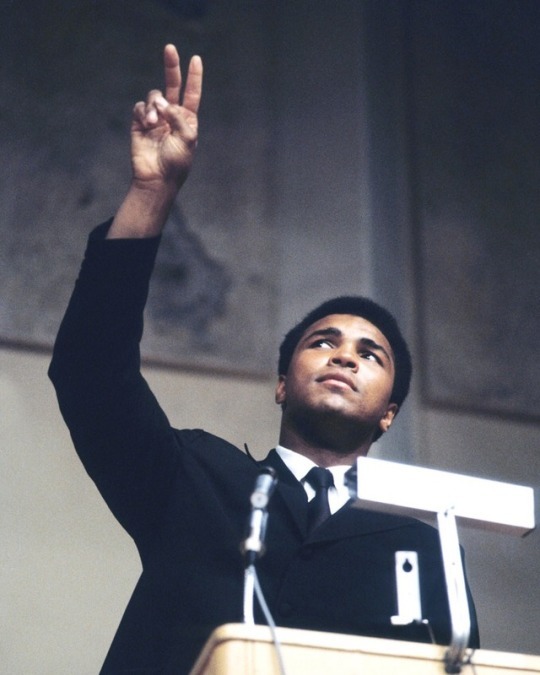
As for the white man being described as the devil, it seemed the media only accepted a race of people being compared to something inhumane when it was them doing it to black people- calling them beasts and monsters etc. They took great offence at being called devils. But again there is four hundred years of evidence to back up why a Black person could feel in his or her right to feel that way about white people. But though easy to do so in that position, you cannot judge a whole race of people from the evil actions of some, even if many, and Ali never hated white people as a whole, or hated anyone because they were white, he hated the actions of many of them towards blacks.
For me the most disappointing and inexcusable viewpoint of Ali in his lifetime were his views on interracial marriage which he opposed. This view seems so out of sync with a man so full of love and care for all people. I am unsure if he held this view for his entire life or if at some point it changed like his other extreme viewpoints, I hope it did though it’s possible it didn’t.
Two years after joining the Nation of Islam and changing his name to Muhammad Ali, he dropped an even bigger bombshell which would ensure he was a topic of conversation across every living room in America.
One month before the first Liston fight Ali then Clay took a military qualifying examination, the passing grade was 30%, Ali scored 16. But by 1966 with the war in Vietnam growing, the passing grade for the mental aptitude test was lowered to 15%, making Ali eligible to go to war.
“Man, I ain’t got no quarrel with them Vietcong.”
-ALI to the press the day he was informed his draft status had changed and he was now eligible to join the U.S Army in Vietnam.
Ali’s remarks about having no quarrel with the Vietcong, enraged America like nothing he’d said or done before. He had a bout scheduled for Chicago with WBA Champion Ernie Terrell for the chance to win back the belt he’d been stripped of, but following his remark pressure was put on the state of Illinois to withdraw hosting of the bout. After Ali refused to apologise for his remark, that’s what they did so Ali instead went to Canada to fight their champion.
For over 5 decades, there had been just two World Heavyweight titles fights outside of America, that was until Ali had 3 fights on European Soil, two in England, one in Germany, making for four consecutive Heavyweight title fights outside of America. Ali was known for his love of travelling the world but this was done mostly due to the difficulty of getting him a fight in the States.
Ali’s first fight back on home shores since he hit Floyd Patterson in the face with about one thousand jabs was to be against Cleveland Williams. Before Ali was exiled from Boxing and making his comeback, another 6 Foot 3 Black American Heavyweight was making a comeback of his own. Cleveland ‘Big Cat’ Williams was just shy of 500 days out the ring after he was shot in an altercation with a highway patrolman, the bullet hitting his stomach before lodging in his right hip. Four operations in seven months ensued, with Williams in the end having his right kidney removed. Doctors were unable to extract the bullet so Williams fought with the bullet inside him for the remainder of his career.
Aswell as a kidney and 17 months of his career, Williams also lost 60 pounds in weight due to injury and surgeries and over 10 feet of his small intestine. To add further insult to injury, he also had to spend some time in prison during this time after pleading no contest to charges from that incident.
Despite the long absence through injury, the vastly experienced Big Cat’s first and only attempt at the World Heavyweight crown was his 72nd Bout in the ring, he entered with a record of 65 wins, 5 losses (including 2 in a combined 5 rounds against Sonny Liston) and one draw.
The Ali fight was the Fifth of his comeback, he’d won all four leading up to the fight (including one on points against Sonny “Policeman” Moore, which may have felt bitter sweet) but it was already crystal clear the 33-year old was no longer the fighter he’d been before the shooting.
In his prime, Williams was considered a legitimate contender, his power was no joke (George Foreman, who sparred with him, called him one of the top 3 punchers he’d shared a ring with) but by the time of this fight he was given no more than a punchers chance up against Muhammad Ali, a world class Heavyweight at the very top of his game.
Ali knew he was facing a quite literally, shot fighter and was very aware of the huge gulf between himself and his opponent and in a regular moment of in-ring compassion (though these are acknowledged a lot less than his dragged out beatings of Patterson and Terrell) seemed determined to end the fight quickly rather than prolong Williams’ suffering over many rounds and really hurting him.
In the first round Ali danced and moved, shooting and landing mostly single shots but given the ease with which he was hitting Williams and evading his punches, he even at times stood in close with Williams landing some hard blows, which is unlike Ali for a first round.
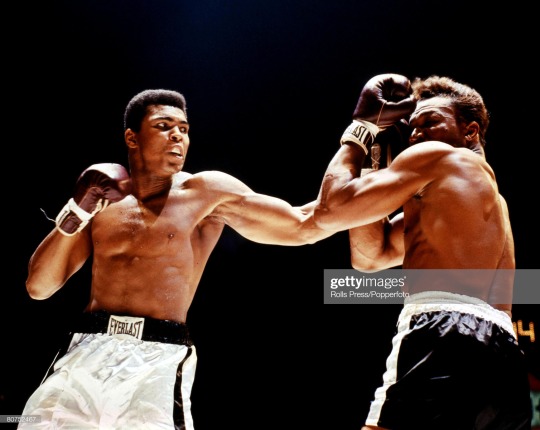
In the second round, Ali hit Williams at will like he did with many fighters at this time in his career. But this time he was hitting with such force his opponent couldn’t cope with it. Williams was dropped three times by Ali in the second including twice right at the end of the round. The bout should have ended there, Williams was flat on his back and would never have got up in time but he was ‘saved’ by the bell and referee’s were a lot more willing to just let fights go on in those days.
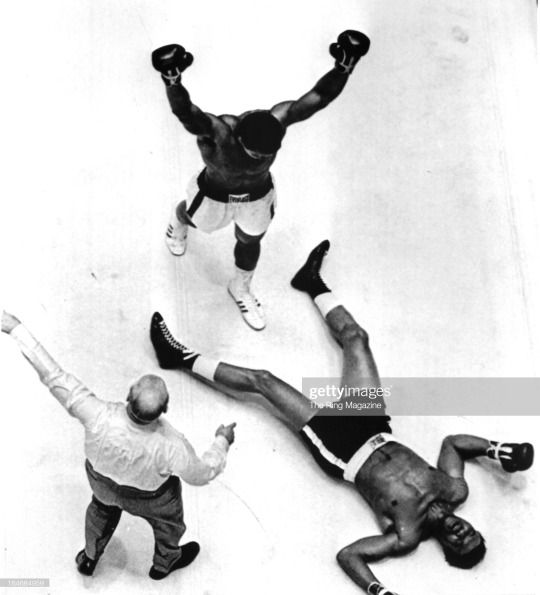

Ali then dropped Williams again 25 seconds into the 3rd round with the referee for some reason again allowing the fight to go on. Ali continued his assault until after 1 minute and 8 seconds of round 3 the ref finally decided Williams had had enough.
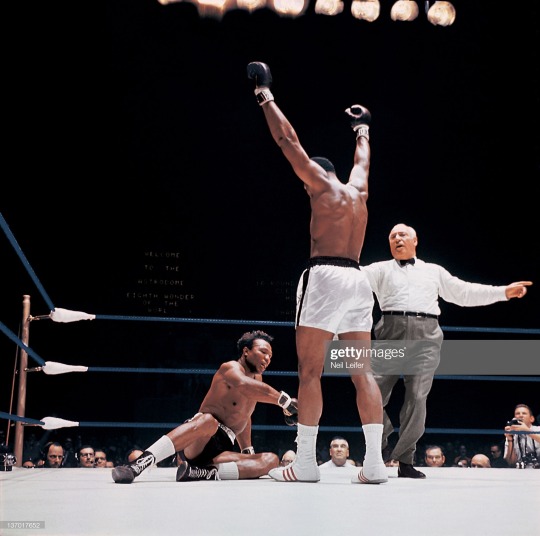
The Cleveland Williams performance is considered one of if not the best of Ali’s career. Aesthetically and artistically it surely is, it was an absolute masterclass in the sweet science, the act of hitting without being hit, inflicting damage without taking any back. Ali himself has called it ‘the night I was at my best’ and you’d struggle to find anyone who disagrees with him on that. Just to complete this Ali performance and make it true vintage Ali, this was also the night he brought out ‘The Ali Shuffle’ for the first time as a pro, it hadn’t been seen since the Olympics.
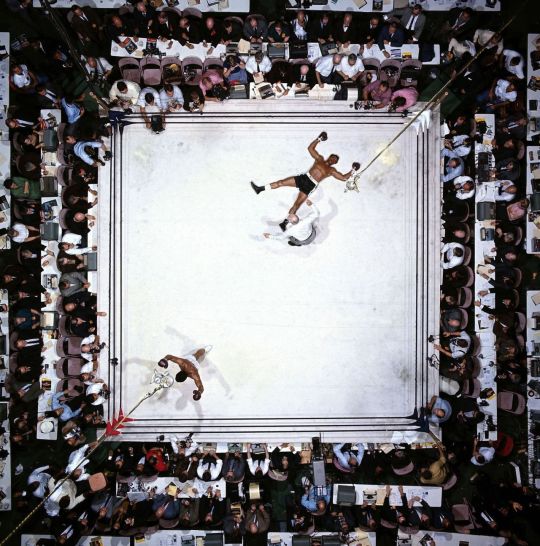
Round Three- vs Jerry Quarry October 26 1970

“Why should they ask me to put on a uniform and go ten thousand miles from home and drop bombs and bullets on brown people in Vietnam when so-called Negro people in Louisville are treated like dogs? If I thought going to war would bring freedom and equality to twenty-two million of my people, they wouldn’t have to draft me, I’d join tomorrow. I have nothing to lose by standing up and following my beliefs. So I’ll go to jail. We’ve been in jail for four hundred years.”
-Muhammad Ali
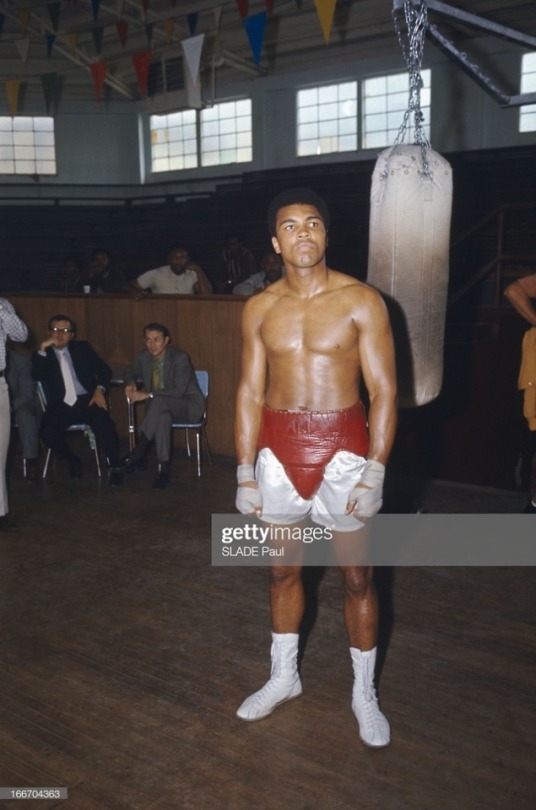
Muhammad Ali’s scheduled induction into the US Army was set for April 28th 1967. Before this date the Champ had three options. He could flee the country, move to Canada like a lot of men who resisted the draft or in fact he could move to any country on earth. He had the wealth to move anywhere and the popularity outside of America to be welcomed as a hero anywhere. Though the boxing organisations would still have stripped him of his titles and prevented him from fighting for them, he would still have been free to continue boxing and earning a good living through his skill.
“The United States is my birth country. People can’t chase me out of my birth country. I believe what I believe. If I have to go jail, I’ll do it, but I’m not leaving my country.”
-Muhammad Ali on fleeing America to escape The Draft.
Option 2 he could accept the draft and with negotiation from his management team, he would have gone to Vietnam to fight exhibitions for the troops just like Joe Louis did during WW2. He wouldn’t even have to wear the US Army uniform. With Ali’s wealth and status as one of the most famous men in the country, there’s no doubt he could have avoided seeing and participating in the warfare in the jungles and villages of Vietnam.
“It would be no trouble for me to go into the Armed Services boxing exhibitions in Vietnam or travelling the country at the expense of the Government or living the life not having to get out in the mud and fight and shoot. If it weren’t against my conscience I’d do it. I wouldn’t lose the millions that I gave up and my image with the American public. I wouldn’t jeopardise my life walking the streets of the South and all of America with no bodyguard If I wasn’t sincere in every bit of what the Holy Qur’an and the teachings of the Honourable Elijah Mihammad tells us, which is that we are not to participate in wars on the side of nonbelievers and this is not a Muslim country.”
-Muhammad Ali on refusing the draft.
Or option 3, he could remain in America, refuse the draft, be stripped of his titles, his boxing license, his passport and face up to five years in jail.
“I refuse to be inducted into the armed forces of the United States because I claim to be exempt as a minister of the religion of Islam”
-Muhammad Ali, written statement to the Lieutenant of the US Navy, the day of his induction.
On April 28th he chose Option 3. 26 young men were called for induction that morning, but only 25 would be soldiers by the days end. “Cassius Marcellus Clay” was called but Ali remained motionless. The consequences were at this point made clear to Ali which he acknowledged he understood. When his birth name was called a second time, Ali again did not step forward.
“I am proud of the title ‘World Heavyweight Champion’ which I won on February 25,1964. The holder of it should at all times have the courage of his convictions and carry out those convictions not only in the ring but throughout all phases of his life. It is in light of my own personal convictions that I take my stand in rejecting the call to be inducted into the armed services. I have searched my conscience, and find I cannot be true to my belief in my religion by accepting such a call. I strongly object to the fact that so many newspapers have given the American public and the world the impression that I have only two alternatives in taking this stand- either I go to jail or go to the Army. There is another alternative, and that alternative is justice. In the end I am confident that justice will come my way, for the truth must eventually prevail.”
-Muhammad Ali in a written statement to the press after refusing induction.
One hour after Ali refused induction, The New York State Athletic Commission suspended his license and withdrew recognition of him as Champion. Soon after, the rest all followed suit.
On June 20 1967 Ali was tried for refusing induction into the United States Army and found guilty twenty minutes later, he was sentenced to the maximum allowable- Five years imprisonment. Following Ali’s convictions and sentencing, the judge confiscated Ali’s passport terminating his boxing career.
With boxing no longer an option, Ali did other things to keep himself busy whilst he waited for the outcome of his appeals. He continued to attend Nation of Islam meetings across the country, he began touring college campuses giving speeches on the war and the teachings of the Nation. He also married his second wife Belinda Boyd.
Whilst Ali’s case continued to go through appeals, Government surveillance on him continued and he actually went to prison for the first and only time in his life, sentenced to 10 days for driving without a license. Ali hated prison but was still willing to go for the considerably longer time of 5 years if necessary.
“Jail is a bad place. I was there for about a week and it was terrible. The food is bad and there’s nothing good to do. You look out the window and everyone else seems so free. Things you take for granted like walking down the street or sleeping good you can’t do. A man’s got to be real serious about what he believes to say he’ll do that for five years but I was ready if I had to go.”
-Muhammad Ali.
Ali was temporarily suspended from the Nation, after telling Elijah Muhammad he would not return to boxing, he then told a television programme he would if the money was right which Elijah Muhammad saw as betraying religion for the white man’s money, but he was soon allowed back with the discrepancy forgiven.
Ali also tried his hand at theatre, appearing in a musical on Broadway. Praise flew in for his role, with words and phrases such as ‘does himself proud’, ‘innate dignity’, ‘likeable actor with humour and appealing sincerity’ used. Drama critic Richard Cook called it ‘a strangely dignified and impressive appearance. Ali sings distinctively and musically, and is much better at it than many other non-singing leading men who have taken top musical roles.’
Ali never gave up on the dream of regaining the Heavyweight championship he had never lost inside the ring, and behind the scenes people worked frantically to get him a license to fight. He came close to being allowed one in California, Nevada, Montana and Tijuana, Mexico but each time it fell through.
All the while, public opinion towards the Vietnam war was changing. At first it had just been Ali and a load of long haired unwashed white hippies calling it wrong. But as the war continued, the body count continued to rise and the end of war still wasn’t in sight, a lot of people began to see the war and Ali differently. At the very least lots came to understand and respect his decision. No longer a draft dodging unpatriotic coward, he was a principled man who stood up for his beliefs and maybe he’d been right about that Vietnam War after all..

The unlikely destination for Ali’s triumphant return to boxing was Atlanta, Georgia. There was no state athletic commission in Georgia, just a mayor who went along with it for the black votes which were controlled by the black state senator who had cut himself a piece of the promotion. Georgia’s governor and several members in congress tried to get the bout stopped but it was in vain, after a 8 round exhibition went off without any hitches, Muhammad Ali was back.
Muhammad Ali was out the ring for 3 years, 7 months and 4 days. He’d been 25 for a couple months when his licence was taken and he was a few months shy of 29 when he could fight again.
1,314 days in which the greatest boxer in the world wasn’t able to box, the world and history deprived of the chance to see Ali at the peak of his powers. Ali was not like the world champions of today who box maximum 2 times a year, he was extremely active. In 1966 he fought five times as defending champion, the following year he fought a 15 rounder with Terrell then six weeks later he was back in action.
During Ali’s exile, we missed out on atleast 10 fights. When the ban came into force Ali was just getting into his prime, just turned 25, the gulf between him and the rest of the field was growing. Ali in his early years had been more prone to showboating at the wrong moment and getting caught and dropped. But since winning the title, those errors had completely gone. His experience was growing, aswell as his strength and his size and fighters just could not tag him clean.
To have a chance in a fight, you have to be able to hit your opponent. Ali as champion before his exile, would not give his opponents that chance, he was simply too fast.
Ali on his return would be a different Ali, not the same fighter. Over 3 and a half years of inactivity meant that Ali’s legs were never the same, he could not bounce and move on them for 15 rounds like before. Though still fast, he was not as elusive, fighters would now get that chance to tag him. Only what they found was that Ali had replaced his ability to avoid punches with an ability to take punches. And in place of unmatched legs that would dance him away from punches for 15 rounds, was a chin and a heart that were also unmatchable.
Ali in his time in exile had transcended the sport, he was more than Boxing, more than Sport. He was a figure who stood for believing in something and standing up for what you think is right no matter the consequences. His popularity which went outside of the usual boxing crowd due to his college tours, religion and anti-war views meant he had more earning power than ever before. And Ali earned more for the comeback fight than he did in any of his previous World title fights.
The opponent for the comeback fight was Jerry Quarry who the year before had been in the Ring Magazine fight of the year when he challenged Joe Frazier for his world title, being stopped after the 7th round on cuts. He was considered the best White Heavyweight in the world, a tough fighter with very good punching power.
“I’m not just fighting one man. I’m fighting a lot of men, showing them here is one man they couldn’t conquer. Lose this one and it won’t just be a loss to me. So many millions throughout the world will feel sad, they’ll feel like they’ve been defeated. If I lose, for the rest of my life I won’t be free. I’ll have to listen to how was I bum and how I joined the wrong movement. I’m fighting for my freedom.”
-Muhammad Ali before his comeback fight.
For the first time in his career, Ali was facing a fighter younger than himself, a top bracket fighter who Joe Frazier said would have been World Champion if he didn’t cut so easily. And it was a cut that would decide this fight.
Ali dominated the first round in front of a buoyant mostly black crowd including some of the biggest names in Black America at the time. But in the 2nd round his pace had slowed and Quarry hit him with a big hook to the body. In round 3 Ali was standing and trading with Quarry, no longer on his toes, which gave Quarry a great cause for optimism. But that round was the final round of the fight, Ali had opened a huge cut over Quarry’s eye and the referee ruled it was too bad to continue.
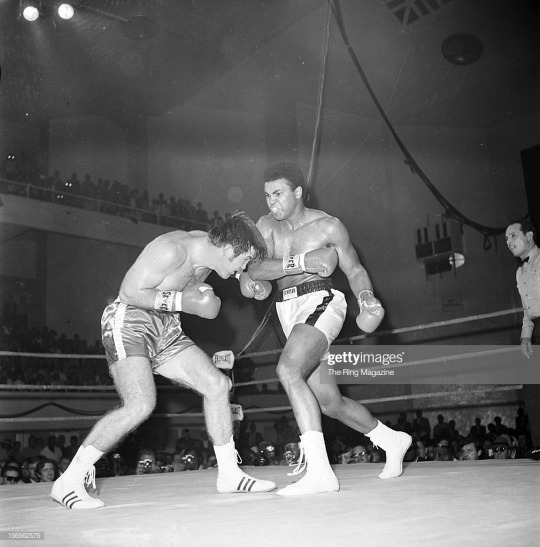
Ali had taken a solid first step to recapturing his crown, but his doctor Ferdie Pacheco observes the changes that occurred in Ali as a fighter pre and post exile: “When Ali was young he was the best physical specimen I’ve ever seen. If God sat down to create the perfect body for a fighter, anatomically and physiologically, he’d have created Ali. Every test I did on him was a fine line of perfect. His blood pressure and pulse were like a snake. His speed and reflexes were unbelievable. His face was rounded, with no sharp edges to cut, and on top of that his skin was rough. In those days I was Ali’s doctor in case something happened but it never did. After the layoff it was a different story. After the layoff his hands went soft. When Ali threw punches in fights he was in pain so before each fight we’d numb his hands with shots. His legs were a more serious problem. The legs are the first thing to go in a fighter. And when Ali went into exile, he lost his legs. Before that he’d been so fast, you couldn’t catch him, he’d never take punches. He’d been knocked down but he’d never been hurt or taken a beating. In the gym he’d work with Luis Rodriguez, the fastest welterweight in the world, and Luis couldn’t hit him. When he lost his legs, he lost his first line of defence.”
What he lost in speed he would gain in experience and in-ring intelligence. Referee Arthur Mercante said of the second coming of Ali: “Ali knew all the tricks. He was the best fighter I ever saw in terms of clinching. Not only did he use it to rest, but he was big and strong and knew how to lean on opponents and push and shove and pull to tire them out. Ali was so smart. Most guys are just in there fighting, but Ali had a sense of everything that was happening, almost as though he was sitting at ringside analysing the fight while he fought it.”
Round Four- vs Henry Cooper I June 18 1963
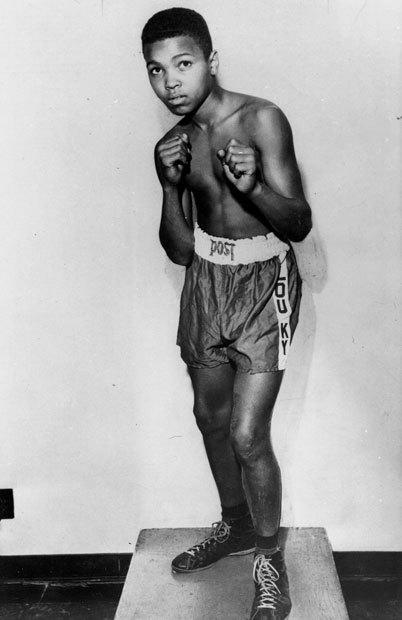
A 12 year old Cassius Clay's first introduction to boxing came when his bike was stolen and he was advised by Joe E. Martin, a Police Officer and boxing coach, that he better learn how to fight if he wanted to ‘whup whoever took it’. From there he went on to have an outstanding Amateur career, winning six Kentucky Golden Gloves titles, two national Golden Gloves titles (fitting for a kid nicknamed GG by his mother, due to that being the sound he would always make in his crib) and an AAU National Title before his Amateur Career culminated at the 1960 Olympic Games in Rome, where an 18 year old Clay won Gold for America in the Light Heavyweight Category (”To make America the greatest is my goal, so I beat the Russian and I beat the Pole”).
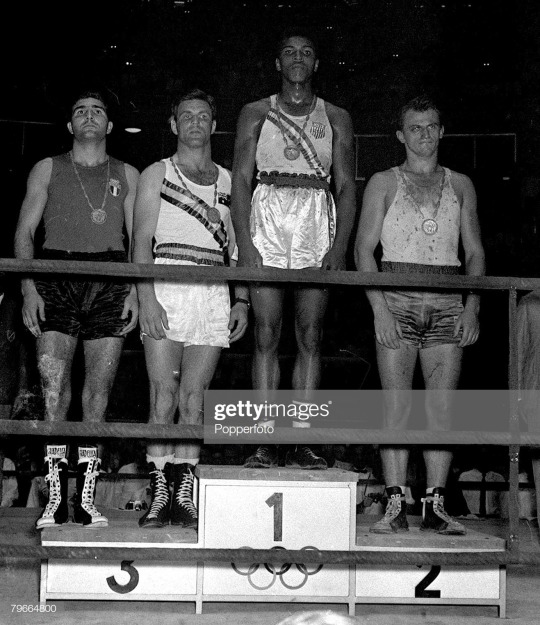
Reports of his complete Amateur record vary from 100-5 to 137-7, there are even claims he had in the region of 175 amateur bouts. Due to less than stellar record keeping at the time, we’ll never know the exact figure, but what we can be sure of is- he won a lot and he lost rarely.
“I’m the double Greatest. Not only do I knock ‘em out, I pick the round.”
-Cassius Clay.
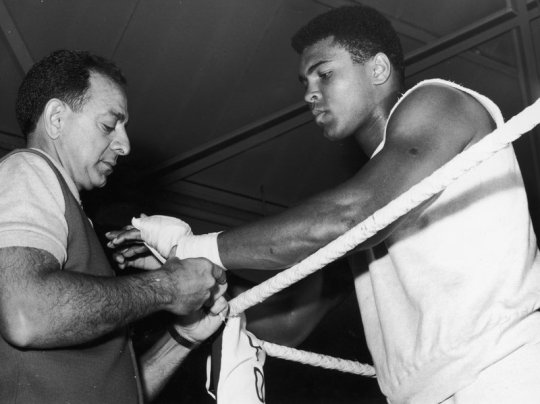
Ali then Clay first met Angelo Dundee in 1957, when the 15-year old Clay set out to him his plan for future Olympic gold and the World Heavyweight Championship. At the end of 1960 he became Clay’s trainer and was in his corner from his 2nd fight to his last (missing only the Ellis fight when he was in the opponent’s corner). The partnership was one of the greatest in the sport’s history. Dundee is renowned as one of the greatest trainers ever working with 16 World Champions and he knew exactly how to treat Ali never dictating to him as Archie Moore had previously tried which only caused him to rebel.
Ali said of Dundee: “Angelo Dundee was with me from my 2nd pro fight. And no matter what happened after that, he was always my friend. He never interfered with my personal life. There was no bossing, no telling me what to do and not do, in or out the ring. He was there when I needed him, and he always treated me with respect. There just wasn’t any problem ever between us.” Dundee knew what a great fighter he had on his hands when Clay sparred with Ingemar Johansson. Clay was 19 with just four fights under his belt, Johansson was preparing for a third fight with Floyd Patterson looking to become 2-time World Champion.
“When he sparred with Johansson, it was the greatest defensive boxing exhibition I’ve ever seen. Here was a boy who’d had four professional fights, and he made a monkey out of Johansson. I’d never seen anything like it before, and I’ve never seen anything like it since.”
-Gil Rogin, writer for Sports Illustrated.
In his early years after turning professional, the 4th round was a good one for Ali then Clay. His first ever stoppage came in the 4th in his 2nd pro fight against Herb Siler. After being dropped for the first time in his 11th fight against Sonny Banks he came off the canvas to stop his man in the 4th. He stopped his next two opponents also in that round and then did the same against his former trainer Archie Moore. Former World Light Heavyweight Champion Moore was the only man to fight both the great Rocky Marciano and the great Muhammad Ali. He was the second of only 2 men to put The Rock on the floor but by the time he fought Clay he was a month shy of his 46th Birthday and fighting his 218th pro fight. He would fight only once more with the Clay fight being his 23rd and final loss. Clay predicted “Moore must fall in Four” and just like against Banks, his fourth round prediction proved accurate.
Ali fought sixteen times outside the US, the first being against Henry Cooper at Wembley Stadium, London. Cooper was Ali’s final preparation fight before he’d fight for the World Title eight months later against Sonny Liston. Cooper was an experienced 33 year old with 27 wins in 36 fights. The Commonwealth Champion was matched against the 21-year old Clay by Clay’s management to give him new experience against a tough opponent.
Clay predicted Cooper would take him 5 rounds to knock out. That prediction didn’t look likely when right at the end of the 4th round he was hit by ‘Enry’s Hammer’ a left hook which landed flush on Clay’s jaw, lifting him off the canvas and down into the ropes where he fell from the middle rope all the way down to the floor. The bell to end the round sounded and he stumbled back to his corner.
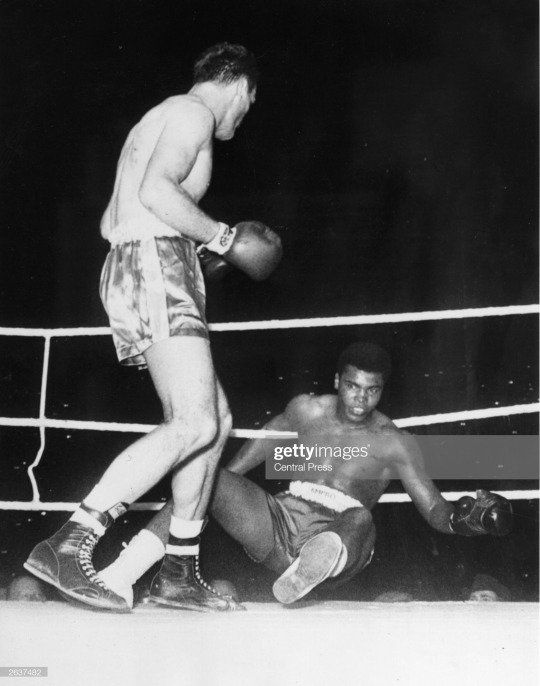
Clay had given Cooper a very bad cut after 2 rounds but seemed to be in no rush to try and get the fight stopped, perhaps wanting to make good on his 5th round prediction. In the 3rd and 4th he threw very little instead clowning with his hands down, taunting and dancing. The big punch looked as though it would turn the tide of the fight giving the Englishman a shock upset but the ropes prevented Clay from having a heavy fall and the bell sounded to end the round just after the punch was landed.
Clay’s head was still scrambled when he was sat on his stool so Dundee put some smelling salts under his nose which would have resulted in a DQ had he been caught. He also noticed a small tear in Clay’s gloves so he tugged at the tear trying to buy his fighter more time by needing the gloves replaced. This bought him only an extra six seconds as the gloves were ultimately not replaced but nonetheless Clay was fully recovered for the start of the 5th round.
He boxed aggressively and busted Cooper’s nasty cut wide open, spreading blood all over his face and the referee had no choice but to stop the bout. Clay promised Cooper a rematch if he was to beat Liston and become World Champion and he did, fighting him again in London this time at Highbury Stadium. Now Ali, he boxed much more carefully this time, not letting Cooper hit him on the inside, keeping his man tied up and staying concentrated throughout the bout which he won in 7.
Round Five- vs Sonny Liston I February 25 1964
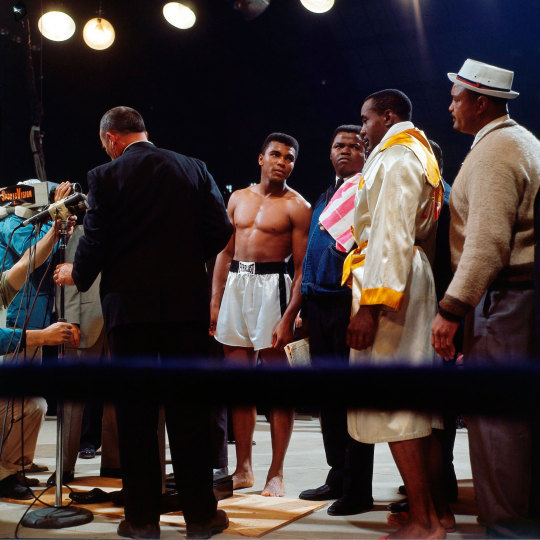
“When the referee was giving us instructions, Liston was giving me that stare. And I won’t lie I was scared. Sonny Liston was one of the greatest fighters of all time. He hit hard and he was fixing to kill me. It frightened me, knowing how hard he hit. But I was there; I didn’t have no choice but to go out and fight.”
-Muhammad ALI.
He was an Olympic Gold Medallist, with lots of amateur experience and a 19-0 (15KOs) boxing record. But still despite this, Cassius Clay couldn’t fight. That was the view of many Boxing writers. He was better at talking than he was at fighting. He didn’t hit hard. He didn't fight like any Heavyweight they’d ever seen before. He’d been dropped twice already in his short career by fighters who were way below the calibre of Sonny Liston, he’d won a close and unpopular unanimous decision against Doug Jones. It was unheard of for someone to fight for the World Heavyweight title after just 19 fights and when Liston got his hands on him it would surely be a short and vicious annihilation.
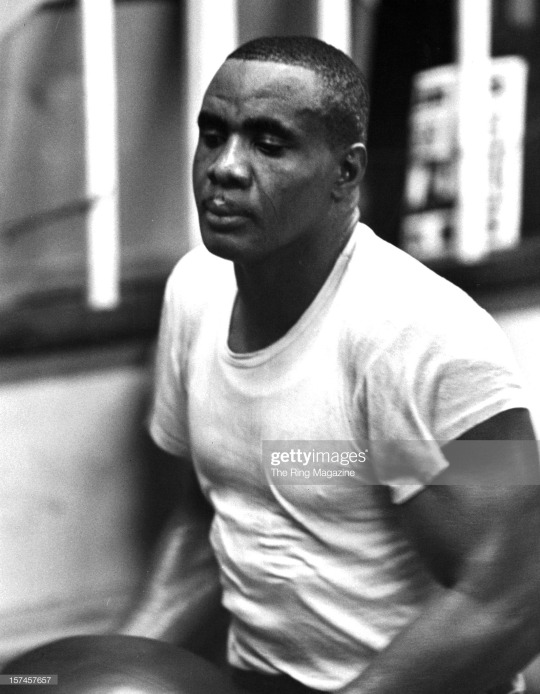
There’s no doubting Charles ‘Sonny’ Liston was one of the scariest men to ever step into the squared circle, he put fear in Clay like no one before or since had been able to do. Sonny was a gangster, a man moulded by violence, it was all he ever knew. “The only thing my old man ever gave me was a beating” and the beatings were so severe that Sonny’s childhood scars were forever visible. As a young man he would be known to Police as the “Yellow Shirt Bandit” who led a gang of thugs in muggings and armed robberies. The yellow shirt apparently being the only one Liston owned.
Sonny learned to box in the state penitentiary where he would often face 2 or 3 men in the ring at once. Throughout his life he had frequent run-ins with the law, in 1956 Liston broke an officer’s knee, gashed his face and took his gun. Violence also came with Liston’s management team (who controlled his career as soon as he turned pro) in the form of Organised Crime. Liston for a time worked for them as an intimidator/enforcer.
Liston intimidated professional Heavyweights let alone average joes who owed the Mafia money. Sonny would enter the ring with towels inside his dressing gown to serve as extra padding to make him look even bulkier, especially around his enormous shoulders. He made his way to the centre of the ring for the pre-fight instructions with a towel draped over his head for added intimidation and would then proceed to stare into his opponents eyes/soul. From there it was a brave fighter who could meet Sonny’s eyes for more than a couple of seconds and a good actor to convince ‘The Big Bear’ and indeed himself, that he wasn’t scared to death. That is of course assuming his opponent was willing to meet his stare, one man who wasn’t was World Champion Floyd Patterson who kept his eyes down towards Sonny’s midriff.
Great fighters often have one exceptional quality that gives them that edge over the rest of the field, be it speed, one punch KO power, reflexes etc. for Sonny it was his incredibly long reach. Sonny was six feet one inch tall with a 84 inch reach. Today’s WBC Heavyweight Champion Deontay ‘Bronze Bomber’ Wilder is six feet seven inches and his reach is 83 inches which shows how freakishly long Liston’s arms were. And at the end of his arm’s were 15 inch fists, the largest of any Heavyweight Champion.
Those huge fists were used to punishing effect, his left jab was so powerful people speculated whether he was actually left-handed fighting orthodox. Both his fists seemed equally potent and when he was finishing his opponent off he would switch- left hand, right hand, then back again. He landed hard, measured punches with extreme accuracy wasting no energy on wild, hurried punches and soon his opponent was on the floor.
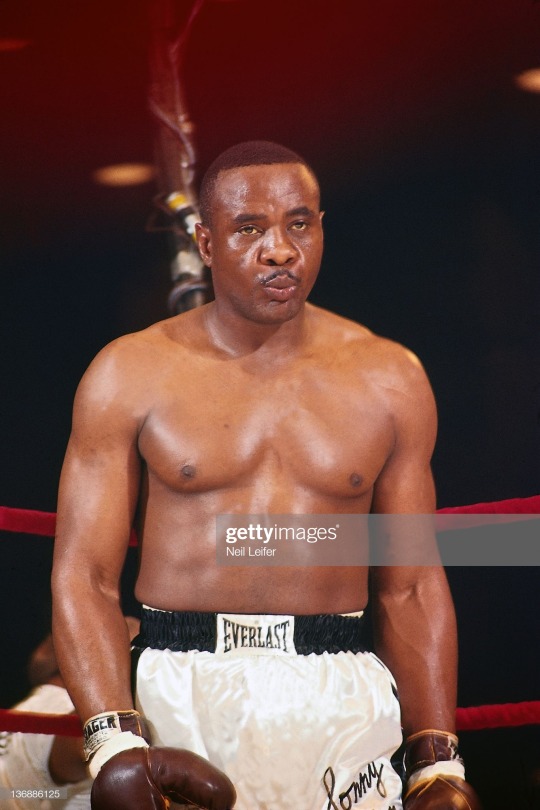
Against Clay, Liston was making just his 2nd title defence, but he would no doubt have been champion years earlier if Cus D’Amato hadn’t steadfastly refused to let him face his fighter, the Champion Floyd Patterson. D’Amato stated this was due to Liston’s mob connections but mostly it was done to protect Floyd. Despite figures as high up as President John F Kennedy wanting to keep the belt away from Liston, eventually Liston was given his shot and he made short work of Patterson first to take the title (this took Sonny 126 seconds) and then to retain it in the rematch (130 seconds). Patterson would later be nicknamed ‘the Rabbit’ by Ali and he was certainly a rabbit caught in headlights here.
Liston was never allowed to escape his past, and there is the heartbreaking story of Liston arriving back at Philadelphia Airport as champion with a speech prepared, expecting to be greeted by a throng of supporters. No such welcome was waiting. Sonny found that nothing had changed and he wouldn’t be allowed to change, he would not be free of ‘The Big Bad Negro‘ label that had been cast on him. He was still hated by the media, by the White House, and by the American public (both white and black, the civil rights groups finding his image damaging to their cause). The Champion no one wanted was now even more unpopular than before.
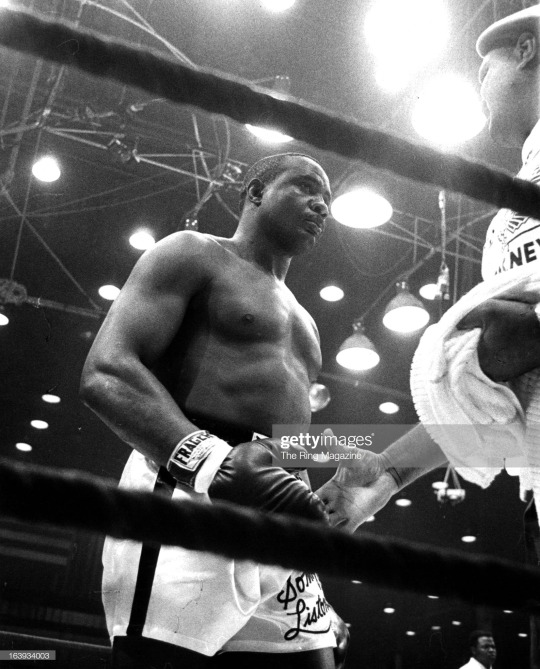
Despite this, there was still a lot of people looking forward to watching him beat up that brash young black kid who wouldn’t shut up about how Great and pretty he was. More concerning for White America was who he now classed as a close friend, Malcolm X, a preacher for the Nation of Islam, known as the Black Muslims. Clay had been instantly receptive to the Nations teachings of self-respect and dignity for the Black Man (meaning no alcohol, drugs or white women) and Black Pride. What made them more unpopular with white people and some black people though was their being in favour of Black and White segregation (which was also supported by the Ku Klux Klan) and their definition of The White American as a Blue-eyed Devil.

Clay’s association with the Nation of Islam was known, but it hadn’t yet been officially announced to the world that he had become a full member (and the Nation were perfectly happy about this, they like many others thought Liston would destroy Clay which would have been humiliating for them).
The always unpopular Sonny Liston fighting Cassius Clay (who once divided opinion with his braggadocious statements but was now held in complete contempt by most due to his alignment with the Black Muslims) meant that this fight was without the typical Good Guy v Bad Guy narrative that typified Heavyweight Title fights of the time. This caused an LA Times writer to observe it would be “the most popular fight since Hitler and Stalin—180 million Americans rooting for a double knockout.”
The fight was a foregone conclusion. It would be Liston. By Knockout. Early. One of many Ali haters in the boxing press wrote of Clay: “Only in this day of mediocrity could he be fighting for the World Heavyweight Championship. Only in this time of soap bubble promotion could anyone take him seriously when he steps into the ring with Sonny Liston.”
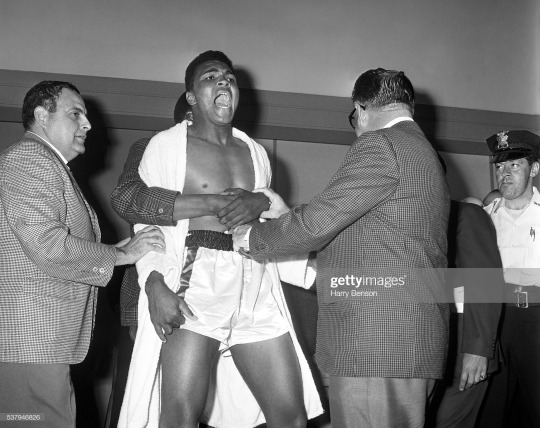
Clay was defiant; “If you want to lose your money, be a fool and bet on Sonny.” It seemed that's what everyone was doing, as Clay was a 7-1 underdog. Doctor Robbins (the Miami boxing commission’s physician) declared Clay “emotionally unbalanced, scared to death and liable to crack up at any moment.” after a wild performance at the weigh-in where a seemingly out of control Clay had his pulse measured at 110 beats per minute.
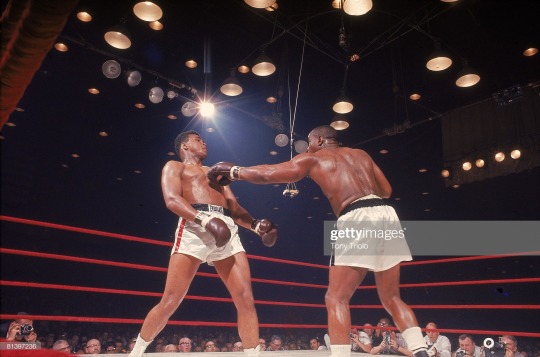
It’s the 5th Round now, the fight has gone further than anyone expected. Less surprisingly, Clay is in tremendous pain and he is being hit fairly regularly by Liston. This wasn't the case in the first 4 rounds as Clay danced around the ring, constantly moving, making Liston miss and landing lightning fast combinations of his own. In the 3rd Liston found himself cut for the first time in his career, a Clay combination forced a gash under both of Liston’s eyes, it’s been equivalated to the armour plate on a battleship being pierced.
But just when Clay looked in complete control, disaster struck. Clay had got on his forehead the solution Liston’s corner had applied to their man’s cuts and perspiration carried the substance down into both of Clay’s eyes (or atleast that’s one version of events. Another is that Liston’s handlers deliberately blinded Clay by rubbing illegal medication into Liston’s shoulders, which would then drip into his opponents eyes during a clinch. Two of Liston’s previous opponents Eddie Machen and Zora Folley complained of a burning sensation in their eyes when fighting Liston). And suddenly, just like that. He was in blinding pain, he couldn’t see and he was incredibly confused.
“This is the big one, daddy. Stay away from him, Run!”
-Angelo Dundee to his blinded fighter.
In a panic, Clay called on his trainer to cut his gloves off, he’d never experienced this before. His eyes were aflame and he suspected foul play (fuelled by Nation of Islam friends, he’d become increasingly paranoid Liston’s mob management would not allow him to win the fight).
Trainer Dundee kept his fighter's stinging, unseeing eyes on the prize. This was for the Championship of the World. Clay stepped off his stool for the fifth round. He was now going to fight one of the most fearsome, devastating punches in boxing history without the use of his eyes.
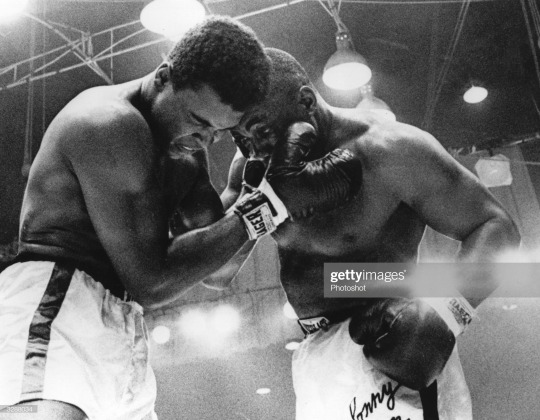
He took more punishment in this round than in the previous four, but despite this and despite Clay barely landing a blow of his own, it still goes down as one of the most legendary rounds of the most legendary career. Without his eyes (he could see only a faint shadow of The Big Bear) Clay circled and moved frantically around the ring, sticking out his long left arm, so he could feel the distance from Liston to stay out of range as best he could, he used that hand aswell to ruffle Liston and break his concentration. And he made it out the round. And now his eyes cleared. Going into the sixth, he had his sight back. And he was angry now.
“Here’s a fighter who’s supposed to be Godzilla, who will reign for maybe a thousand years. Nobody can stand up to him in the ring. Cassius can’t see, and still Liston couldn’t do anything with him. What can I say? Beethoven wrote some of his greatest symphonies when he was deaf. Why couldn’t Cassius Clay fight when he was blind?” Ferdie Pacheco- Ali’s Physician and cornerman.
Round Six- vs Sonny Liston I February 25 1964
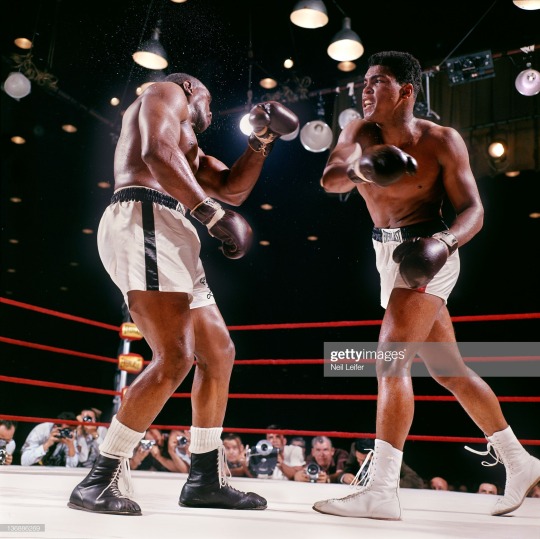
Clay hit Liston at will in the sixth, with blisteringly effective aggression he landed combination punches again and again. The champion was battered, beaten and bettered, unable to inflict any damage of his own. Liston was tired, he hadn’t been passed the 3rd round since 1960 and he’d trained for a short fight. The much younger man Clay was still fresh, still just as fast. As the round concluded, Liston sat on his stool for the final time that night.
“Wait a Minute, Wait a Minute, Sonny Liston is not coming out! Sonny Liston is not coming out! He’s out! The Winner and The New Heavyweight Champion of the world is CASSIUS CLAY”
Howard Cosell- on colour commentary.
Clay became the first challenger since Jack Dempsey 45 years earlier to make the Heavyweight Champion quit on his stool. A shoulder injury Liston had brought with him into the fight was cited as the reason. This reason has always been disputed but a team of eight doctors who inspected Liston’s arm at the hospital afterwards aswell as Florida State Attorney Richard Gerstein were all in agreement, Liston’s arm was too badly damaged to continue fighting. He had a torn tendon which had bled down into the mass of the biceps, causing swelling and numbing in the arm.
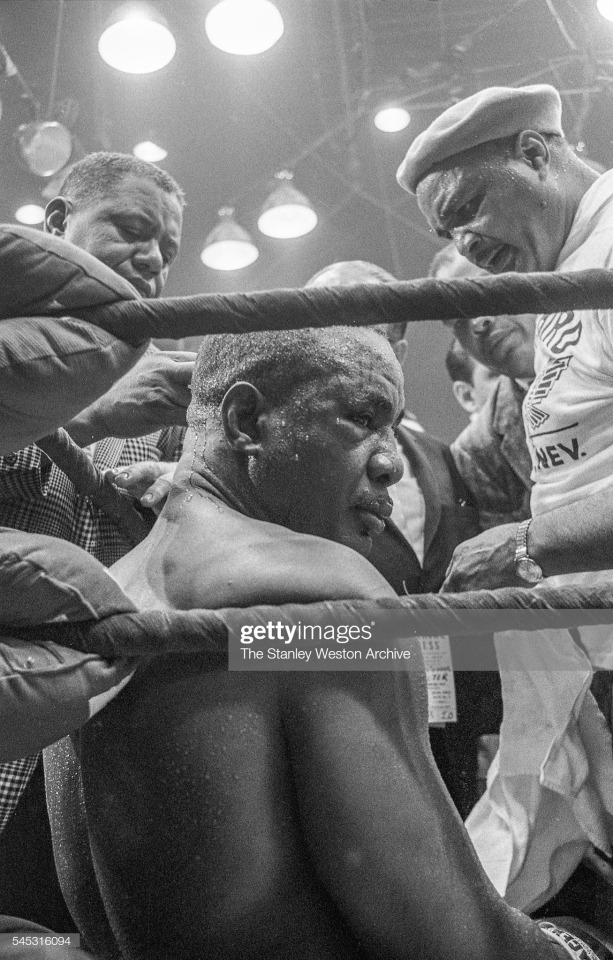
Liston’s bum shoulder was the last thing on Clay’s mind. 39 days after his 22nd Birthday, he’d become the youngest fighter ever to take the Heavyweight Championship of the World from the Champion (Patterson won it in an Elimination Tournament after Marciano relinquished through retirement). He’d done it against the most fearsome, indestructible Heavyweight there’d ever been and in just his 20th professional outing.
“I am The Greatest! I shook up the World! I’m the greatest thing that ever lived. I don’t have a mark on my face, and I upset Sonny Liston, and I just turned Twenty-Two years old. I must be the greatest. I showed the world, I talk to God every day. I shook up the World. I’m the King of The World! I’m Pretty! I’m a Bad Man! I shook up the World! I shook up the World! I am The Greatest! I can’t be beat!”
-A jubilant Cassius Clay in the ring following his shock Triumph over Liston.
This was his final fight as Cassius Clay and this night marked the transition from boy to man. Due to his respect for Liston’s fighting abilities, for the first time he put together a complete performance, knowing he needed to be at his absolute best.
Round Seven- vs Zora Folley March 22 1967
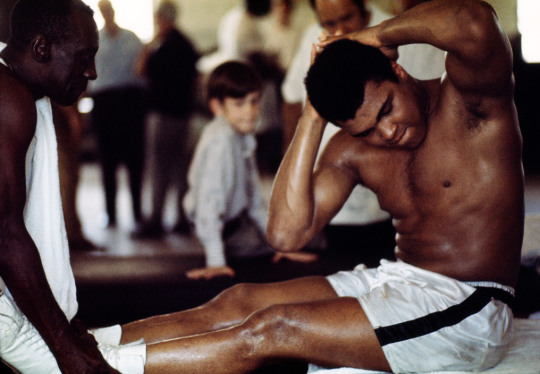
“This guy has a style all on his own. It’s far ahead of any fighter’s today. How could Dempsey, Tunney or any of them keep up? Louis wouldn’t have a chance, he was too slow, Marciano couldn’t get to him and would never get away from Ali’s jab. There’s just no way to train yourself for what he does. The moves, the speed, the punches, and the way he changes style every time you think you got him figured. The right hands Ali hit me with just had no business landing, but they did. They came from nowhere. Many times he was in the wrong position but he hit me anyway. I’ve never seen anyone who could do that. The knockdown punch was so fast that I never saw it. He has lots of snap, and when the punches land they dizzy your head; they fuzz up your mind. He’s smart. The trickiest fighter I’ve seen. He’s had 29 fights and acts like he’s had a hundred. He could write the book on boxing, and anyone that fights him should read it.”
-A conquered Zora Folley waxes lyrical on Muhammad Ali, who he describes as the greatest fighter of all time.
After the masterpiece against Williams, even the biggest Ali critics were forced to grudgingly acknowledge his talent but in his very next fight Ali had them all madder than ever again. Just shy of a year after it was originally scheduled to happen, Ali faced Terrell in the infamous ‘What’s My Name?’ fight.
Before the fight Ali took great offence to Terrell’s insistence on calling him Clay rather than Ali. Before their bout, Patterson had also called Ali ‘Clay’ and he responded by toying with the former World Champion and prolonging his beating rather than going for the knockout. He did the same thing here with Terrell only this time he shouted “What’s my name? What’s my name Uncle Tom” at him whilst beating him. The performance was Ali’s most maligned ever as critics lamented the way he had looked to humiliate his opponent by ensuring the one-sided fight went the distance rather than cutting short the beating by taking his man out or stepping on the gas so the referee could step in.
Instead Ali gave out as much punishment as he knew Terrell could take and there’s little doubt that if the bout had been scheduled for 30 rounds Ali would have carried his man so he could whup on him until the final bell. Sports writer Jerry Izenberg said of the bout: “If Ali was an evil person, that’s the kind of person he would have been all the time. It was a side to him that was so out of character that to this day I still find it hard to believe it was him. I was there and it was evil. He was trying to hurt Terrell and if you understand boxing you know that means something different to what the uninitiated think it means. Ali went out there to make it painful and humiliating for Terrell. It was a vicious, ugly, horrible fight.”
This time was the peak of Ali’s unpopularity, he ofcourse still had many loyal supporters but these were drowned out and dwarfed in number by those who now had him as America’s number 1 hate figure. A draft-dodging coward outside the ring and a bully inside it.
Ali was placed under surveillance by the US Government shortly after his “no quarrel with them Vietcong” remark. In August 1966 he had a special hearing in order to put forward his plea to be exempt to the draft as a conscientious objector to the Vietnam War on religious grounds.
The hearing officer ruled that Ali was of ‘good character, morals and integrity, and sincere in his objection on religious grounds to participation in War of any form’. He recommended that Ali’s conscientious objector claim be sustained. This recommendation was ignored, his conscientious objector status was rejected.
Coming into the fight with Zora Folley, Ali realised the noose was tightening and this may be the last time he’d be allowed to fight. Again Ali was far too good for his opponent, who was over matched just like everyone was against Muhammad at this time. Ali dropped Foley in the fourth before he finished it in the 7th with a beautiful knockdown which left Folley flat on his face. Folley tried bravely to get back to his face but his legs were not with him and he stumbled around before crashing into the ropes.
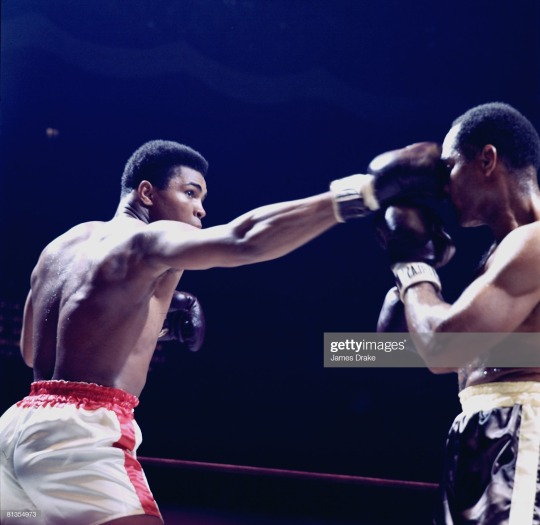
And this was the last we would see of prime Muhammad Ali, the fighter most believe to be the Greatest Heavyweight if not boxer of all time. Though Ali would not show his great heart or great chin in the ring until he returned from exile, he did show his great skill. And in his footwork, jab, defence, counters and combinations you had the most skillful and talented fighter of all time.
“Float Like A Butterfly, Sting Like A Bee! The Hands Can’t Hit What The Eyes Can’t See! Rumble Young Man Rumble AAH!”
-Muhammad Ali, often accompanied by Drew ‘Bundini’ Brown.
Ali’s footwork often worked in a circling pattern sequence which he had learned from his idol as a child, Sugar Ray Robinson. This footwork allowed him to cover lots of distance with minimum effort and each step gave him the chance to accelerate, pivot or change direction. Ali had one of, if not the best jab in history, he pushed off the back foot to close the distance and generate power then landed on his lead foot and pushed off it to pivot and dart back out of range.
Ali’s defence was even more unorthodox, he called it his lean back style. It relied on his extraordinary reflexes and creative movement. When his opponent attacked Ali would step back, slip the punch and drop his hands even further which encouraged them to get more aggressive. They would then overreach causing their shot to lose power and Ali would then take the weakened shots harmlessly on his shoulders or they would miss all together. Ali was such a good judge of distance he could make an opponent miss with one simple turn of his chin. With one simple movement he could take his head out of range whilst keeping himself in range to counter. Ali used footwork in conjunction with head movement to keep himself out of danger. His defensive footwork pattern was to step back, shift back, angle left, pivot, slip inside whilst changing his head position for each step taken. This often led to his opponents shot flying right past him whilst also putting Ali in a superior position with his opponent more open for Ali’s circling and jabbing. Whilst employing this footwork and movement he would also raise his right hand to block good hook punchers or raise his left hand to block boxers with a good cross. He preferred to parry or deflect his opponents punches rather than make them miss all together as it took more energy out of them.
Ali would also modify his defensive footwork so it enabled him to go on the attack. Stepping back kept his rear hand much closer to his opponent and he would step back then leap into a cross. His effective counter punching came from his opponent beginning to anticipate that Ali would always retreat from their attack. At this point he would stop short of fully retreating. Leaning back and slipping inside he would then wait until he got the perfect distance and throw his counter right. As he moved his head back to avoid the oncoming punch, his hand would come up from below his opponents line of vision. Ali’s glove would arch over their shoulder and snap down on their head. This scored him a stream of knockdowns with his opponents never seeing the punch coming.
Ali modified the footwork he took from Sugar Ray so that it enabled him to throw combinations whilst circling. His favourite was jab, jab, cross in which he used his footwork to generate momentum and increased speed which resulted in a surprising amount of power for a boxer up on his toes.
"He was just so damn fast. When he was young, he moved his legs and hands at the same time. He threw his punches when he was in motion. He'd be out of punching range, and as he moved into range he'd already begun to throw the punch. So if you waited until he got into range to punch back, he beat you every time."
-George Chuvalo, Ali opponent in 1966.
"It's very hard to hit a moving target, and Ali moved all the time, with such grace, three minutes of every round for fifteen rounds. He never stopped. It was extraordinary.”
-Floyd Patterson, Ali opponent in 1965.
“If you put the Muhammad Ali who fought Cleveland Williams and Zora Folley against the Muhammad Ali who fought Joe Frazier and George Foreman, the young Ali would win. When I was older I was more experienced, I was stronger. I had more belief in myself. Except for Liston the men I fought when I was young weren’t near the fighters that Frazier and Foreman were, Williams and Folley were light work. But I had my speed when I was young. I was faster on my legs, and my hands were faster. The young Ali would dance, move, get in and out. He’d beat the older Ali all around the ring. The older Ali wouldn’t quit. Against a young version of me, I’d use the rope-a-dope, make charges and try to knock him out. But I was better when I was young.”
-Muhammad Ali on two of the greatest fighters of all time, young Ali before Exile and old Ali after it.
“Ali before the layoff was a better fighter than Ali after. But what a lot of people don’t realise and it’s very sad is we never saw him at his peak. The Ali who fought Williams and Folley was the best he could be at that time, but he was still improving. He hadn’t lost any of his speed, but he was getting bigger and stronger and more experienced in the ring. He was 25 years old when they made him stop, those next 3 years would have been him at his peak. And if he’d continued getting better at the rate he was going, God only knows how great he would have been.”
-Trainer Angelo Dundee.
“Ali was an absolute Genius in the ring. He was the fastest fighter who ever lived. Not the fastest Heavyweight- the fastest fighter. People say that Sugar Ray Robinson was the greatest fighter who ever lived and at Welterweight he was close to perfection, but when he moved up to Middleweight he was beatable. I took some fight films and measured Ray’s punches through a synchroniser. Sugar Ray threw his jab in eight and a half frames, Ali threw his in six and a half. If you made Sugar Ray Robinson a 200-pound fighter with no loss of speed or coordination, I still think Ali in his prime would have beaten him.”
-Jim Jacobs, co-manager and close friend of Mike Tyson, once owned the largest fight film collection in the world.
“I honestly believe that Mike Tyson at his best was the second-greatest Heavyweight of all time, but he wasn’t Muhammad Ali. Mike is quick, but Ali was quicker. Mike has power, but Ali had the greatest chin ever. Mike is prone to frustration, which would be his achilles heel against Ali, because Ali was the greatest fighter in history at playing mind-games with his opponent. If Ali in his prime fought Mike at his best, I see Ali winning a decision; say, eight rounds to four, or nine to three.”
-Bill Cayton, co-manager of Mike Tyson.
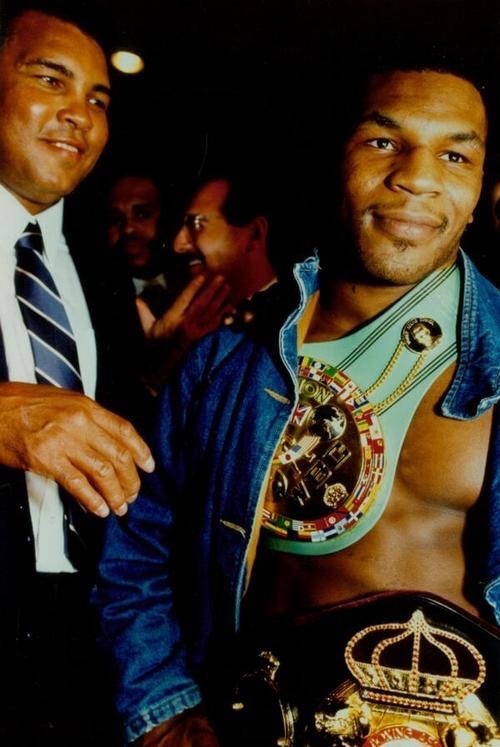
“Ali had that special belief in himself that allowed him to impose his will on other fighters. This is a guy who took on three of the toughest heavyweights in history- Liston, Frazier and Foreman- and he beat them five out of six. The young Ali would have frustrated Mike. I see Ali coming out, jabbing, moving, talking a lot. If Mike had me in his corner and his head was screwed on right, it would be close. I’d advise Mike to keep his hands high, be elusive, slip, move in, wherever possible work the body. Lots of feints, because Ali was a terrific counter-puncher. Believe it or not, I’d work the jab, even if it was only to Ali’s chest. It would have been an interesting fight, with both guys missing a lot. But even with Mike at his best, I’d give the edge to Ali.”
-Kevin Rooney, Mike Tyson’s Trainer from 1982-1988.
“Ali at his best beats Tyson at his best. At his core, Ali is a much stronger, more stable person. Probably, the way he’d have fought Mike was to rely on what he did best: jab, score from the outside, stay off the ropes, show a lot of side-to-side movement, neutralise the pressure, make Mike pay when he missed, tie him up when he got inside. After a while, Mike would get anxious and be throwing one punch at a time. Then I think he’d break down mentally, which is the area Ali was strongest. And when that happened, Ali would start putting punches together to punch Mike downhill even more. Finally, when the time was right, without it being too dangerous, Ali would give Mike a reason to fall. I think Ali would knock him out in the ninth or tenth round. But before that, Mike might get so discouraged and beaten mentally that he’d quit the way Liston did.”
-Teddy Atlas, trainer who worked with Mike Tyson at the beginning of his career.
“If fighters had a schedule like baseball teams and you could match the greatest Heavyweights of all time at their peak, so Ali was in a league with Jack Johnson, Joe Louis, Jack Dempsey, Rocky Marciano, Gene Tunney, you know who the best Heavyweights are, you can put them all on the list. Ali wouldn’t be undefeated; there are guys who would give him trouble on a given night. But I think when the season was over, Ali would be in First Place.”
-Mike Katz, Boxing Writer.
Round Eight- vs George Foreman October 30 1974

Muhammad Ali fought just 20 rounds in 1974, in comparison to 48 the year before and 60 the year before that. 20 rounds and 2 fights. There would be no filler fights this year, no fights Ali could coast to points wins in. This time the only fights were against the very best. First Joe Frazier and then George Foreman, Heavyweight Champion of The World.
Muhammad Ali would face George Foreman in Zaire, Africa for the unheard of sum of $5 Million dollars. Don King who was in prison whilst the Fight of The Century was taking place, and reportedly listened to the fight on a radio now had Ali and Foreman signed up to fight for him on the premise each man got 5 Million apiece.
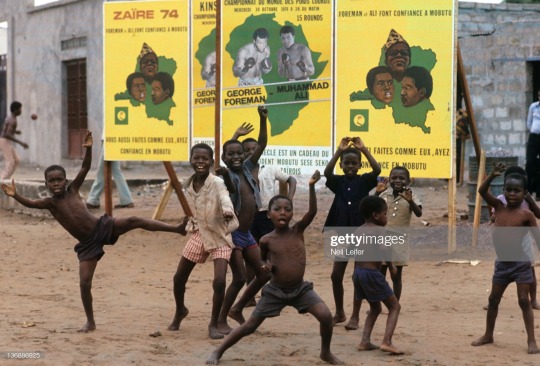
Don King had to shop around to find a country willing to put up such a sum but he found it in Zaire, a country run by President and Dictator Mobutu who was persuaded that hosting the bout in his nation would be high profile exposure for Zaire and would strengthen his regime. Though it was actually Colonel Gaddafi, dictator and leader of Libya who provided the purse money for the athletes and covered other major expenses.
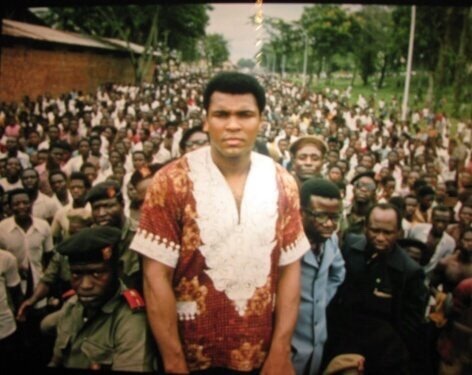
The fight held lots of parallels to Ali’s first fight with Sonny Liston. It was taking place exactly 10 years on. This would be Ali’s 18th fight since his comeback, a similar number to the number of pro fights Ali had had when facing Liston. Ali again was an enormous underdog given no chance against a vicious knockout puncher.
Foreman was 40-0 with a huge 37 knockouts, he was suspected to be maybe the hardest punching boxer, ever. The power he hit the punchbags with was frightening. He also seemed to come from the Sonny Liston school of intimidation. The stare. Words few but full of menace. He was even an old sparring partner of Sonny’s and clearly had picked up a few things as he was considered sneering, elusive and anti-social by the press.
But Foreman surely was not going to befall the same fate as his old mentor. Ali was young back when he beat Liston, fast as lightning, with the stamina to dance and move all night. Liston was an ageing fighter, an old man with question marks over how old, but atleast 32. This time it was Ali who was the 32-year old with his best days clearly behind him fighting Foreman the younger, better man.
Ali going into the Liston fight had won 15 of his 19 previous fights inside the distance. Coming into the Foreman fight he couldn’t punch anymore, his power had gone, his last five fights had gone the distance, and he’d lost one of them. Foreman on the other hand, he’d stopped 24 consecutive opponents. Of those 24 stoppages only 2 had come past the 4th round with 6 in the first round, 11 in the 2nd, 3 in the 3rd and 2 in the 4th.
Two of those incredible 11 2nd round finishes had come against Joe Frazier and Ken Norton, two men who had previously beaten Ali. Ali had fought 27 hard rounds against Frazier being dropped once and never knocking his man down, Foreman put Frazier down six times in 5 minutes. Ali had fought 24 hard rounds against Norton having his jaw broken and never knocking him down, Foreman put Norton down three times in 5 minutes. More evidence that Foreman and Ali would be another mismatch in favour of the champion who looked set to reign for a very long time.
But then styles make fights. Foreman could keep the shorter man Frazier from hitting him in a way that Ali couldn’t due to a difference in defensive approach. Whereas Ali relied on his reflexes to keep the shots from landing, Foreman preferred to not let his man throw atall. He blocked the opponent from throwing by pushing their arms and shoulders back so they couldn’t throw the punch. Frazier being under 6 foot and aswell fighting in a crouching style made him ideally suited for Foreman to push down on his shoulders and arms. Foreman would use his long, strong arms to physically shove Frazier back and stop him from getting inside.
Ken Norton was allowed to come forward against Ali, as Ali didn’t have the big punch of a Foreman or a Shavers to back him up. Norton was known to freeze against big punchers, they scared him but against Ali he was always able to be the best version of himself.
In the build-up to Ali v Foreman in Zaire, the fight billed as ‘The Rumble In The Jungle’ there was no acknowledgement of Ali’s ability to take a punch, only Foreman’s ability to administer one. It was not conceived as a possibility that Ali would be able to absorb many if any punches from George.
There was one major difference pre-fight between this fight and the Liston fight, before this fight just as before that one, the press knew Ali would lose, knew he would be knocked out, but after following his career for so long, unlike back then they now didn’t want it to happen, they no longer wanted to see him badly hurt which was surely the only outcome.
They weren’t the only ones concerned. Herbert Muhammad, Ali’s long-time manager and son of Nation of Islam leader Elijah Muhammad, gave money to someone in his entourage to give to the referee under the understanding that he would stop the fight if Ali was in danger of being seriously hurt, knowing he’d be too proud to quit. Whether this money ever reached the referee is unknown.
Ali on the other hand, didn’t seem concerned in the slightest, always utterly convinced he would win. He looked at a list of the men who’d been unable to stop the George wrecking machine and dismissed them as nobodies until he reached Vernon Clay. “Clay? he might have been good.”
You think the World was shocked when Nixon resigned? Wait ‘till I whup George Foreman’s behind.
-Ali with some pre-fight rhyming.
George Foreman had loved Ali as a teenager and when he got into boxing to positively channel his want to fight and bully, he originally wanted to dance like Ali and try to copy that style. His trainer however, had a different style in mind “push him off, hit him hard and knock him out” so that became the George Foreman way, and he did it more effectively than anyone.
Foreman was certain Ali would be another quick knockout, he had no reason in his own mind to think it would be any different to his recent fights and he was perfectly okay with knocking out his former hero. Foreman had at this time not yet found God and was clearly struggling to find the man he wanted to be. At the time he was mean, angry and seemed to enjoy intimidating people.
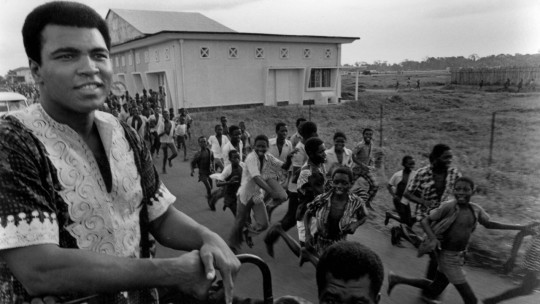
“Ali boma ye! Ali boma ye!”
-The chant Zaireans took up in the build-up to the fight and on fight night itself. It meant ‘Ali, kill him!’
The bout was originally scheduled for September 24 but had to be pushed back as Foreman took an accidental elbow in sparring, slicing open a cut above his right eye. The rescheduled fight would now take place on October 30 at 4 in the morning. October 30th would be Ali’s 55th day in Zaire, he had spent it surrounded by people, mixing with locals, giving impromptu press conferences every day. Foreman however spent much of his time in Zaire, secluded and away from the people.
Like many unusual destinations for sporting events, a murkiness did not lie too far down from the surface. J.J Grimond, The New York Times’ African correspondent at the time, an American living in Zaire tells this story of how President Mobutu dealt with crime in the build-up to the fight, with its swathes of white reporters and watching eyes it would bring on the nation. “It is an amazing structure (Stade du 20 mai, the venue of the fight), do not ignore the design. It is not just a place for receiving people but for processing them, and if necessary, disposing of them. Last spring the crime wave grew so intense, a nightmare for Mobutu if foreigners arriving for the fight should get mugged on masse. So he rounded up 300 of the worst criminals he could find, and locked them in the holding rooms under the stadium. 50 of the 300 were killed. Right there on the stone floor of the stadium. The executions took place at random, no listing them, they just eliminated the nearest 50. The randomness was more desirable. Fear among criminals would this way spread deeper. 250 were let go so they would tell their friends of the massacre. The crime rate is now down. Mobutuism. Africa is shaped like a pistol, say the people here, and Zaire is the trigger. Enjoy the stadium.”
The mood in Ali’s dressing room before the fight could be compared to that of a wake. Silent, glum expressions everywhere you looked. There was fear amongst those present which included Ali’s friends and reporters, in their mind Ali’s walk to the ring would be like walking to the gallows on death row. Ali however saw it differently as the minutes counted down: ”There’s nothing to be scared of. Getting into the ring with Liston beats anything I have had to do again. Except for living with threats against my life after the death of Malcolm X. Real death threats. No I have no fear of tonight.”
In Foreman’s dressing room, Foreman and his team joined hands and prayed. Archie Moore, a former trainer of Ali in the days of Cassius Clay, now a trainer for Foreman prayed Foreman wouldn’t kill Ali: “I really felt that was a possibility.”
30 seconds in Ali lands a clearly hard shot straight into the middle of Foreman’s face which causes the crowd to roar. It must be the hardest punch Foreman has took in years with most men not having the dare to crack Big George like that, let alone so early in the 1st round. The first round was a good one for Ali, he landed some good shots but he’d been concerned at how successful Foreman had been at cutting the ring on him. He’d been pressured back to the ropes a few times and without his guard in position to protect he’d been forced to take some punishment. After 1 round there was another, quite alarming concern for Ali.
“George was following me too close, cutting off the ring. In the first round I used more energy staying away from him than he used chasing me. I was tireder than I should have been with fourteen rounds to go. I knew I couldn’t keep dancing, because by the middle of the fight I’d be really tired and George would get me.”
-Ali.
So after one round Ali’s tactics of dancing and moving were out the window. The ring was too slow and he was aware he’d gas out. So from the 2nd round on, he tried a new tactic which he would use in sparring when he got tired. He leant on the ropes and Foreman, thinking he had his man right where he wanted him began throwing lots of leather. From the very beginning this struck everyone as a very bad tactic from Ali. Joe Frazier on commentary said Ali must get off the ropes or Foreman will walk him down and Ali’s own trainer Angelo Dundee had never discussed or considered this a viable option to win the fight, he screamed at his fighter to get off the ropes. But Ali continued his strategy.
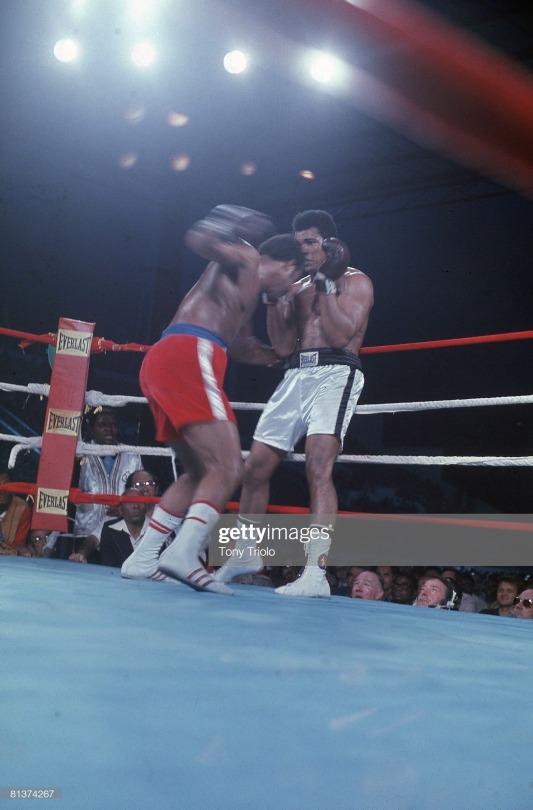
By entering the 3rd round it became Foreman’s longest fight for exactly 3 years. Ali continued to land many, fast clean punches. Foreman’s defence was none existent, he didn’t use head movement and Ali was bouncing fast combinations off his head, either countering or beating George to the punch. Foreman on the other hand was having little success. Ali was leaning way back into the ropes, giving himself room to pull his head back far enough so Foreman’s hooks would fly infront of his face.
“That all you got George? They told me you could punch. Show me something, sucker! you ain’t got nothing.”
-Ali to Foreman throughout the fight.
As Ali continued to talk to George anytime they were in close, taunting him Foreman started to get frustrated throwing big, wild punches that missed Ali comfortably. The first four rounds all went to Ali as Foreman already seemed to be visibly tiring. Ali would taunt Foreman whenever he missed as he continued to lean back on the ropes, covering up using his big, strong arms to block shots and protect his body and face. After 2 and half minutes on the ropes, throwing very little, Ali suddenly got onto the attack, punching hard at the tired Foreman, landing with ease. Ali was completely controlling the destiny of the fight.
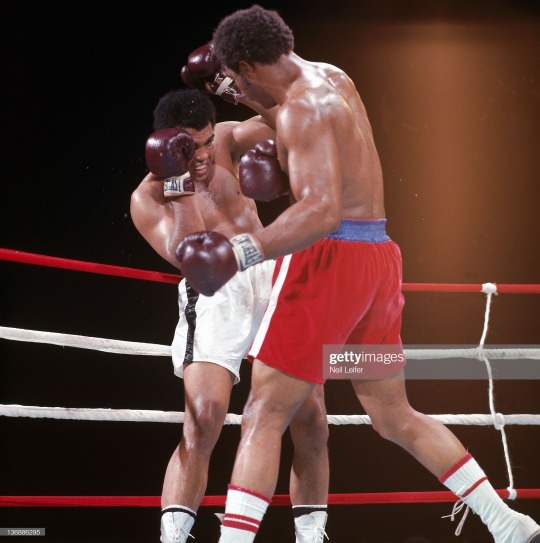
Ali’s speed was easily outlasting Foreman’s strength. Foreman’s punches were slow and Ali took them with ease as he continued to talk to Foreman. In the last minute of Round 8 Ali was backed up in a corner, very much on the defensive, Foreman was concentrating on headhunting and Ali’s gloves were up protecting his face. Foreman’s pawing, blocking motion was stopping Ali from throwing any punches at this point and there was a lot of pushing and holding. Then suddenly with 20 seconds of the round remaining Ali absolutely exploded into a life, cannoning a combination off Foreman’s face, Foreman came forward again only to be caught by a hard shot and then another, then circling round, the sudden use of movement confused Foreman and Ali then landed a 5-punch combination. Whilst Ali punches he dances away, circling as he throws keeping Foreman off balance. A powerful whipping hook that Ali threw from behind his back is the most effective punch of the lot and at this point Foreman is done. Ali finishes the job with a cross and Foreman is sent towards the canvas for the first time.
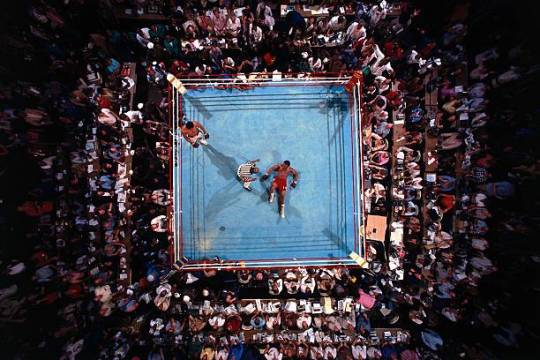
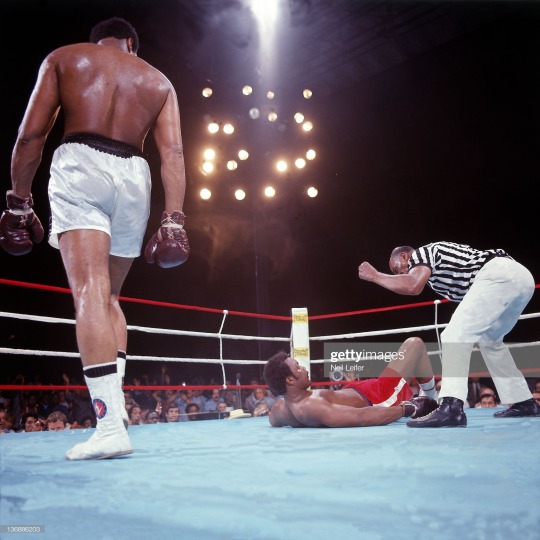
Foreman his arms flailing wildly seems to fall in slow motion as if gravity itself cannot quite comprehend what is happening and can’t yet accept it. Ali stands poised ready to land another blow, but knowing he doesn’t have to. He waits for the inevitable crash as Foreman hits the deck. The roar is deafening, Foreman looks stunned, bemused as if he himself didn’t believe he could ever find himself in this situation. He lies flat on his back with his head raised listening to the count. On 7 he makes his attempt to get up but the count beats him and after 2,619 days without the title he never lost in the ring, Muhammad Ali is the Heavyweight Champion of the World, again.
“Muhammad Ali has done it! Muhammad Ali has done it! The Great Man has done it! This is the most joyous scenes ever seen in the history of boxing! This is an incredible scene. The place is going wild! Muhammad Ali has won! Muhammad Ali has won! By a knockdown! By a knockdown! The thing they said was impossible is done!”
-David Frost on commentary.
It was surely the greatest night for Ali and his supporters and the finest fight and win of his career. The way in which he controlled the night from the outset confirmed his place as one of the greatest boxing tacticians of all time with his plan executed to perfection.
From the off he hit Foreman with right hand crosses, a punch Foreman hadn’t bargained for as noone in sparring dared try to land it on him, due to it being considered a somewhat disrespectful punch to land, owing to the amount of time it takes to travel the opponent can clearly see it coming. But due to Ali’s great speed Foreman still couldn’t stop it from landing.
Then Ali immediately sensed the danger of fatigue and set a trap for Foreman. The rope-a-dope as it would become known. What made this Foreman loss so remarkable is he lost in a way that should have guaranteed him a win, by getting to continuously hit Ali. Ali’s footwork, his dancing and movement, that was supposed to be the problem. Instead Ali danced and moved less than he ever had before, stayed against the ropes and let Foreman pound on him. Ali took a few shots that hurt, how could he not facing one of the greatest punchers of all time, but he was able to block, deflect or turn away from most of them. The ones that hit, Ali braced for, he had a sense for the shots that would really hurt, this was easier against Foreman who threw extremely wide shots. So Ali would brace for them and take them, or otherwise he would go with the punches, moving back into the ropes and letting the ropes absorb the force.
Aswell Ali never forgot about offence, he took every opportunity to throw straights at Foreman and this was highly effective, puffing Foreman’s eyes. And his taunting was also not without effect, it kept George angry and kept him coming forward without stopping to think whether this tactic was proving effective or not and whether he should look to try something else. The fight being held in Africa too, just added to the sense of magic and wonder at what Ali had been able to do. And made it really the definitive, perfect night in the career of the Greatest of All time and now 2-time Champion Muhammad Ali.
For Foreman, the night was ofcourse a complete and utter disaster. And it would leave scars that did not leave for a long time. Foreman’s self-belief and confidence had taken a huge hit, Ali had convinced him he couldn’t punch. Foreman went into a state of crazy delusion, claiming he was drugged or poisoned, refusing to accept reality- that he’d been beaten mentally and physically, out-thought and outfought by the older man.
In April 1975 Foreman announced his comeback from the Rumble In The Jungle in the most surreal of ways. He was going to fight 5 men in one night, one after the other, in 3-round bouts. Ali was present doing commentary. The night ended up being in a way even more embarrassing for George than that night in Zaire. Certainly more bizarre anyway.
The night began with Foreman throwing a fold-up chair at Ali before he’d even got into the ring, Ali had already bugged him and he was just getting started. His first opponent was Alonzo Johnson, a fighter with just one fight in the last 10 years. Foreman knocked him out in the 2nd but was shocked to find this didn’t make the crowd chant for him. They began to chant “Ali! Ali!” whilst Ali as I’m sure you can imagine conducted his orchestra, chanting along.
Next up was Jerry Judge a fighter with a 15-3-1 record. Foreman dropped him in the 2nd and the kid was counted out. Then in one of many bizarre moments that night, a few seconds after Foreman and Judge were going through the usual post fight routine of hugging they were suddenly pushing each other and then throwing punches at each other. They fell back into the ropes and then Judge lifted Foreman off his feet and threw him to the floor. With both men on the floor, the respective corners came into the ring to break it up and then began to push each other. The crowd booed Foreman and debris was thrown into the ring. Foreman raised his arms as if this was what he hoped to achieve, but his face said different. Up went the ‘Ali!’ chants again.
The third opponent was Terry Daniels, a fighter who’d won 28 of his first 33 fights up to fighting Frazier for the World title. After losing to Frazier in the 4th he then lost 13 of 19 fights going into this fight with Foreman. The referee stopped the bout in the 2nd at Foreman’s insistence as he felt Daniels was taking too much punishment. Daniels disagreed and wanted to fight on. His handlers poured into the ring angry with the stoppage and Daniels stood with his hands on his hips. As Foreman turned round to see Daniels stood infront of him, for the 2nd time Foreman continued fighting with his opponent after he’d won and again hell broke lose. With both entourages in the ring, this time punches were thrown between them with one of Foreman’s guys landing a punch on one of Daniels’. Foreman took exception to this, angrily pushing his own corner man across the ring, his cousin.
The fourth opponent was Charley Polite, a fighter with a 13-30-3 record. Polite mimicked kissing Foreman as the fighters received instructions. Foreman who’d once stared down Joe Frazier with an eery calm now just 2 years later was being mocked and shown a total lack of respect by a guy with 13 wins from 46 bouts. It was about to get worse. Polite lasted the 3 rounds with Foreman and the worst thing was he survived using Ali’s rope-a-dope tactics. He lay on the ropes whilst Ali in his commentator/cheerleader role shouted instructions to Polite. Instructions Polite followed. Ali would shout “Lay on the ropes! Lay on the ropes! Yeaaa!” during the bout and give a loud, enthusiastic “Wooo!” whenever Polite rallied with some shots.
The final opponent was Boone Kirkman, a man Foreman beat in 2 rounds in 1970. Kirkman also lasted the 3 rounds, but finally, this time when Foreman and his opponent embraced at the end, they didn’t start fighting again after. Foreman then looked to trash talk with Ali, only to find Ali had already left the arena, having to go catch a flight.
The night had been a total humiliation for Foreman, who behaved more bizarrely as the night went on. He was jumping around, dancing, throwing silly amateurish punches, walking around in between fights, staring out into the crowd, shaking his head, looking totally baffled as to how it had all come to this in such a short space of time.
I have chose to highlight this night as well as the Rumble In The Jungle, one because it was a highly amusing spectacle (though not for Foreman fans), highly bizarre and never to be repeated. Also because it shows Ali didn’t just beat Foreman for one night in Zaire, he continued to beat him mentally day after day, night after night for a long time.
Foreman was the perfect Ali opponent. Ali took the big, bad monster. A man who couldn’t be beat or hurt and he took all that strength and fear and turned it round on Foreman until he was made to look very foolish.
If the Ali defeat did serious damage to Foreman’s psyche it was nothing to the damage done in his next defeat against Jimmy Young in 1977. After losing a decision Foreman suffered exhaustion and heatstroke in the dressing room and left boxing aged 28. He found God and as a born-again Christian became a Reverend. 10 years later aged 38 he returned to boxing and after losing 2 title fights on points against Evander Holyfield and Tommy Morrison. On the third attempt, he won back the belt he lost exactly 20 years prior to Ali in Zaire aged 45 and he would reign as world champion until he was nearly 49.
Foreman became a new man after finding God and always spoke very fondly of Ali. He considered Ali to be his best friend and was an honorary pallbearer at his funeral.
Round Nine- vs Joe Frazier II January 28 1974
1974 began with Ali v Frazier II, the fight in between The Fight of The Century and Thrilla in Manilla. This was billed as Super Fight II and was the only 12-round fight between the pair and the only non world heavyweight title fight, with both men coming in on equal footing- as former World Champions and contenders needing a win to earn a shot at George Foreman.
Between The Fight of The Century and Super Fight II was nearly 3 years in which Ali fought 13 times, which puts in perspective people’s fume over Tyson Fury and Deontay Wilder fighting twice each and having a 14 month gap before their rematch presuming all goes ahead.
“I think that Ali is probably clowning, but there is no question in my mind that Joe Frazier is not clowning. They threw off their respective earpieces, microphones, Joe Frazier’s watch came off, there was a wrestling bout on the floor and we’re really very sorry this happened.”
-A gleeful Howard Cosell on ABC’s Wide World of Sports as a brawl breaks out between Ali and Frazier.
Muhammad Ali and Joe Frazier sitting next to each other analysing their first fight shortly before their second meeting in the ring. What could possibly go wrong?
It was clear here that still 3 years on there was still no shortage of ill will between the pair. The tension was palpable in the studio as the two men and Cosell looked over their first fight. Ali acknowledged he had clowned too much in the first fight and promised he wouldn’t do so this time. He kept to his word and never clowned beyond one wink to the ringside reporters, but he appeared never to talk to Joe during this fight, it seemed in fact that the only one who did any taunting was Joe.
On ABC’s Wide World of Sports, Ali did look at times to get under Joe’s skin (as Joe also did back to him) but he also had praise for him and again made clear with Joe present that the negative stuff he said about Joe was done to promote and sell the fight and that he didn’t really mean it. This seemed always to go in one ear and out the other with Joe who never accepted this explanation from Ali.
When it came time to analyse the 10th round, as Frazier landed a shot he referenced Ali going to the hospital after the fight. This got Ali’s back up. “I went to the hospital for 10 minutes you went for a month now be quiet.” Ali quite rightly points out the irony of Frazier’s remark and then calls Frazier ignorant for it. This word deeply offends Frazier who stands up and over Ali repeating “Why you think I’m ignorant?” Ali still seated tells Frazier to “sit down Joe! Sit down quick Joe”. At this point Ali’s brother Rahman and another gentleman come over to the scene in order to protect the seated man and restrain Joe. Frazier then addresses Ali’s brother asking if “he’s in this too?” which causes Ali to get to his feet and quickly grab Joe around his back and shoulders pulling him to the floor. Ali seems quite clearly to still be playing around demonstrated in the comical way he grabbed him and the way he exclaimed “Quick Joe!”.
A brawl did however escalate on the floor, with Joe deadly serious, with the two men needing to be separated with in the end around a dozen men coming onto the set to try and split the pair up and then keep them apart. Frazier exited the studio not to return but not before he and Ali engaged in one final verbal spar before the programme was able to cut to commercial.
Ali: Monday Night Boy!
Frazier: Yeah, you be there!
Ali: Monday Night!
Frazier: You be on time.
With the Wrestling match over it was time for the Boxing. Ali had Frazier hurt in the 2nd round wobbling his legs but a bizarre moment where the referee separated the fighters (as Ali moved in on a Frazier who’d been pressured back across the ring against the ropes) thinking he’d heard the bell long before it was due to ring enabled Frazier to completely recover before Ali could go for the kill.
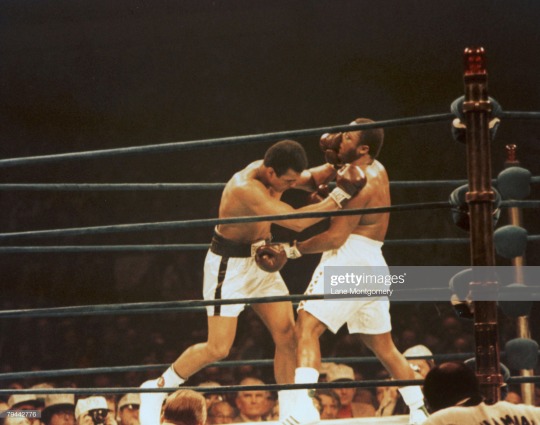
At the halfway point of the fight all 3 judges (2 judges, 1 ref) had Frazier winning just one of the opening six rounds. Ali was this time not taking any punishment from Frazier on the ropes, and he was engaging Frazier in a clinch time and again with Frazier either unable (due to the way Ali held his arms) or unwilling (trying to conserve energy for the later rounds) to fight out of the clinch by banging to the body. Frazier had been able to escape Ali’s clinch near every time in the first fight, being able to out manoeuvre him meant Frazier could continue his attacks up close and personal.
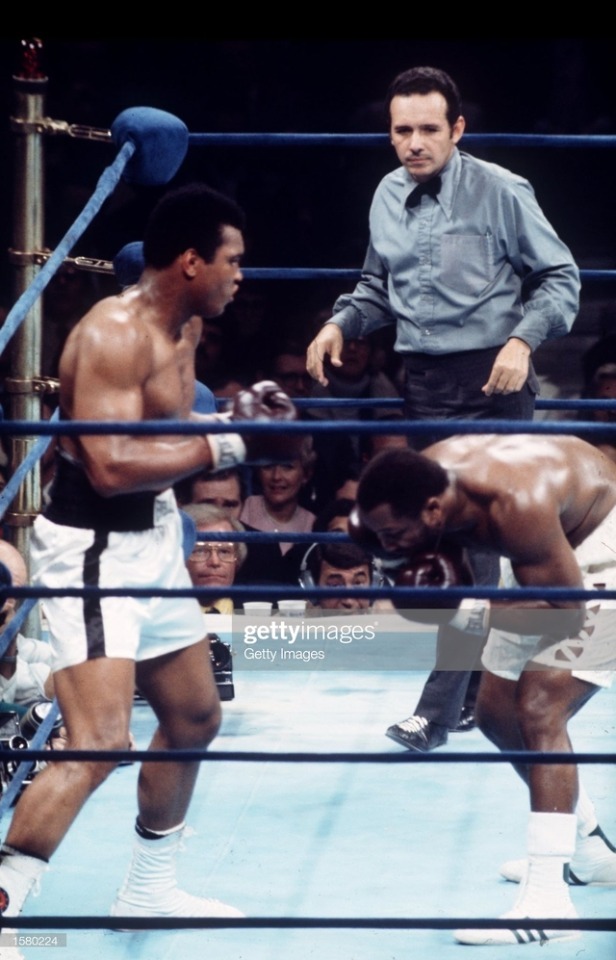
But instead this time Frazier waited for the referee to separate the fighters. Ali in the years since the first fight had been refining his grappling and had worked out a way to stifle Frazier in this position. Frazier was not hurting Ali as he had in the first fight with Ali dancing and moving rather than staying infront of Frazier as he had done for too much of the first fight. When Frazier did land, the shots didn’t seem to be nearly as impactful as in their first fight.
In the 6th round Frazier had begun to get frustrated and impatient. He neglected defence which allowed Ali to take full advantage hitting him at will and continuing to make an increasingly wild Frazier miss. In the 7th and 8th the tide seemed to be changing. Frazier had more success in landing on Ali who had slowed right down. Frazier had begun to time Ali much more successfully, in both landing and avoiding punches. Ali had begun to look sluggish again, throwing shots without much speed or force. Frazier seemed at this stage poised to take command of the fight and dominate its second half as Ali had the first. He had begun talking to and taunting Ali for his lack of power and more concerning for Ali was Frazier was now breaking out of a tired looking Ali’s holds. Right on the bell to end the 8th Frazier landed a huge overhand right which knocked Ali back.
Coming into the 9th round one judge had it 4-3 Ali with one even, the other had it dead even at four rounds apiece and the referee also had it 4-3 Ali with one even. Frazier had won the last two rounds on all three scorecards. Frazier was talking to Ali before the 9th round commenced (this was in the days fighters would stand long before their minute in the corner was up), laughing and mocking him seemingly convinced he had his man right where he wanted him and in truth all the momentum was with him.
Frazier was ecstatic looking, dancing, waving Ali forward, he could hardly wait for the bell to ring. Referee Perez pretty much had to push Frazier back to prevent him from getting to Ali before the bell. Ali on the other hand had to be concerned, 3 years of hard work to get back at Frazier was in danger of being wasted as victory and a meeting with Foreman for the title looked to be slipping out of reach.
The 9th round was key for Ali’s victory in this fight as he was able to stop Frazier coming back from a big deficit on the scorecards to lead on one and tie it up on the other two. Instead Ali won a round on all 3 scorecards for the first time since the Second Round. Ali no longer just allowed Frazier to push him back against the ropes, instead he pushed back, forcing Frazier back into the middle of the ring. Ali planted his feet and began boxing with Frazier, no longer willing to back off or dance away. Ali threw a 15-punch combo, hitting Frazier with a torrent of punches.
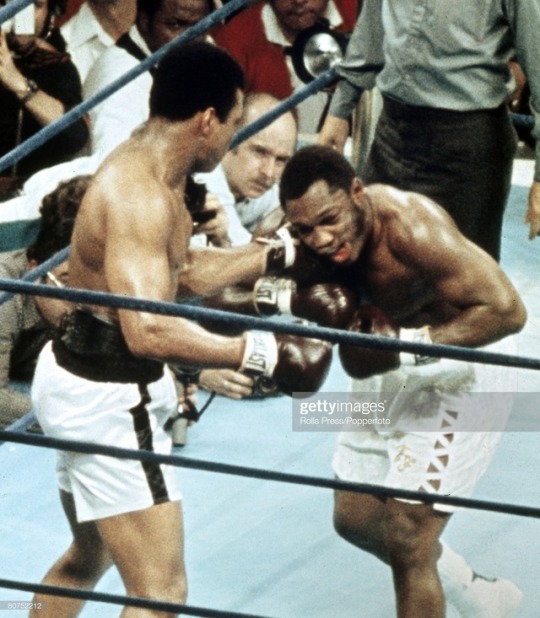
Ali sensed the urgent need to change as the gameplan was no longer working, and he accepted the need to take risks and he did, willingly going toe to toe against Frazier. This aggressive approach from Ali resulted in him taking some punches back, but he gave out far more and had wrestled (quite literally, by moving Frazier back into centre ring whenever he got close to the ropes) back momentum in the fight.
In the final 2 rounds Frazier searched desperately for the knockout, at times abandoning defence all together as he looked in vain to land the knockout blow. But it wasn’t to be for Frazier, as Ali moved, punched and held his way to the final bell.
In the same way Ali had cancelled out Norton’s split decision win by winning the rematch via split decision, he had now cancelled out Frazier’s unanimous decision win with a unanimous decision of his own taking this fight: 7-4-1, 7-5 and 6-5-1 on the cards.
It was certainly the weakest fight of the trilogy by far, but that is judging a good fight against two of the best fights of all time. Frazier still had some success, landing good hard shots and clearly winning some rounds but Ali appeared now to have a much better tactical understanding of how to beat him and the damage Frazier was able to inflict was certainly a lot more limited.
Round Ten- vs Larry Holmes October 2 1980
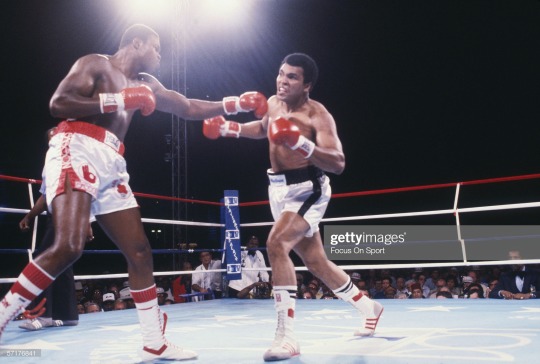
60s Ali was the fastest, most skillful, most beautiful fighter. 70s Ali was the most resilient, most intelligent, and still the most beautiful fighter. But 80s Ali just should just never have been in a boxing ring and the reasons why he was can be looked at now.
Ali had said that black people needed to see one of their own get out on top. Sugar Ray Robinson lost his last fight via unanimous decision being dropped by a man who’d only ever knocked one fighter down before, Joe Louis was brutally beaten up in 8 rounds by Rocky Marciano.
Ali seemed to have a chance to avoid that fate when he retired in 1979, a year after becoming the first 3-time World Heavyweight Champion in history, and oldest World Heavyweight Champion ever after winning back the belt he lost to Leon Spinks in a split decision by unanimous decision aged 36. He retired The Champ but two years later and a couple of months short of his 39th Birthday he was back trying to win the World Heavyweight title for an unprecedented 4th time against The Eastern Assassin, 35-0 Larry Holmes.
People have differing opinions on when the ideal time was to retire for Ali’s health. Some say as far back as after The Rumble In the Jungle, for other’s The Thrilla In Manila was the final straw, or after the third Norton fight or the Shavers fight. But what everyone can unanimously agree on is: The Spinks rematch should have been the curtain coming down on the most glorious of careers. But it wasn’t.
Ali had spoken for years about retirement, how the next fight would be his last but when it came time to step away he always seemed to want more. But then, it seemed as though Ali would finally be able to stay away from fighting when he retired after beating Spinks, he could retire as Champion, the only 3-time champion and aswell having avenged all 3 of his losses.
From a sporting sense there was absolutely no more to gain from fighting on. From a monetary sense there was- a comeback would earn Ali millions ofcourse and much of the money Ali had gained fighting had gone. Ali was always interested in how much money he could make from a fight, but then once he’d made it he wasn’t exactly a stickler with it and hustlers and hangers-on (and they weren’t exactly in short supply) easily sniffed out his naivety and took whatever they could.
There was also so much about boxing Ali loved. The adoring crowds, the competition. As Angelo Dundee puts it ‘It was in his blood-win or lose he loved boxing.” Boxing had made Ali the most famous man on Earth, it was the only thing that gave him a platform and stage big enough for what he required. This was emphasised by nearly 2 billion viewers tuning in for his comeback fight with Holmes. Ali loved fame, loved people and maybe feared without the boxing his fanfare would lessen as people moved on to new current athletes.
Larry Holmes didn’t begin boxing until he was 19 years old, he turned pro in 1973 and was soon sparring with Ali and Frazier, holding his own. By the time he was meeting Ali in a proper fight, he was established as the number one fighter in the world after beating Ken Norton in a close, high quality 15-rounder.
To get a license to fight Ali had a neurological evaluation to ensure he was healthy to fight as a slur in his speech had started to become noticeably apparent. Ali had tingling in his hands when he woke up in the morning and a hole in the membrane that could be enlarged with concussive blows to the head. The clinic’s evaluation was forwarded to the Nevada State Athletic Commission and Ali was granted a license with no follow up on the report.
During his two years out the ring Ali’s weight had gone up to 255 pounds, for this fight he weighed in at 217, his lightest since The Rumble In The Jungle. But it was an illusion. Ali had been improperly prescribed medication for a supposed hypothyroid condition. The drug sped up his metabolism and messed with his body’s self cooling mechanisms. Ali lost a lot of weight and felt fatigued and sluggish.
Ali was prescribed the drug Thyrolar and he took 3 a day believing the pills would be like vitamins. Thyrolar is a potentially lethal drug and noone taking it should engage in a professional fight. Ali was weak, fatigued and short of breath from round one on, he had strength only to lift his arms to protect himself, too fatigued to fight back. His body wasn’t able to cool itself properly and his temperature rose. This led to heat stroke with an intermediate period of slight stupor and maybe delirium.
The fight lasted 10 rounds, of which Holmes won every one on all three judges cards. It was the only time Ali lost a fight without hearing the final bell. Herbert Muhammad gave the signal to end the fight and Dundee pulled his fighter out. But why had the fight taken place in the first place?
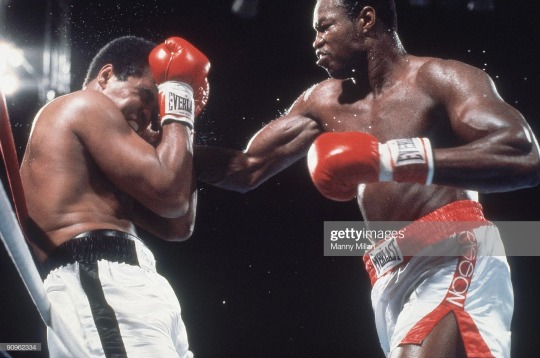
Anyone around Ali at the time could clearly have seen he wasn’t fit to fight anyone, let alone the Best Heavyweight on the planet at the time. Bernie Yuman, Ali’s friend and promotional manager explains: “Ali had a serenity about him before his fights, he’d be incredibly peaceful and serene. But this was different. He wasn’t peaceful, he was slow. He wasn’t serene, he was drugged out. He was a sick man.”
Not only were the drugs side effects potentially life threatening when paired with a boxing match, Dr. Charles Williams (who had previously been Elijah Muhammad’s doctor) diagnosis had also been speculative and incorrect.
Ferdie Pacheco, who had left Ali’s camp after his fight with Earnie Shavers in 1977 was no longer onhand to protect him from Dr. Williams’ questionable ability. Luckily he was in Zaire in 1974, as he tells it: “In Zaire, he announced Ali had hypoglycemia (which you couldn’t diagnose without a battery of tests which weren’t available in Africa). The one thing you cannot in any way, shape or form do is give someone with hypoglycemia more sugar because whatever additional sugar you put in, you’ll get that much more sugar proportionally. And if you put enough sugar in, the patient will go into an insulin coma. His cure for Ali was to for him to eat peach cobbler and ice cream right before the fight. So what I said was ‘he can’t eat peach cobbler right before the fight because he could get punched in the stomach. Let’s make a sort of orange syrup and give it Ali between rounds.. And that bottle is still out in the jungle somewhere between N’Sele and Kinshasa.”
“All the people involved in this fight should've been arrested. This fight was an abomination, a crime. Ali is lucky he lived through the Holmes fight. Ali was a walking time bomb that night. He could have had anything from a heart attack to a stroke to all kinds of bleeding in the head. That fight was a horrible end for a great champion and years later I’m still pissed off about it.”
-Ferdie Pacheco on Ali-Holmes.
Even without the effects of thyrolar, Ali was also fighting with early onset Parkinsons syndrome. His speech had deteriorated rapidly over the last few years with his words slowing and slurring. He blatantly should not have been fighting Larry Holmes but the reason he did becomes clearer with these two words: Don King.
Holmes was King’s fighter and a fight against Ali for his comeback fight meant money for Don. A win over Ali also cemented Holmes place as the The Man in the division, giving King a stranglehold over the Heavyweight Division. With King’s own money on the line this time rather than someone else’s it was essential for Don that the fight would take place and that Holmes should win.
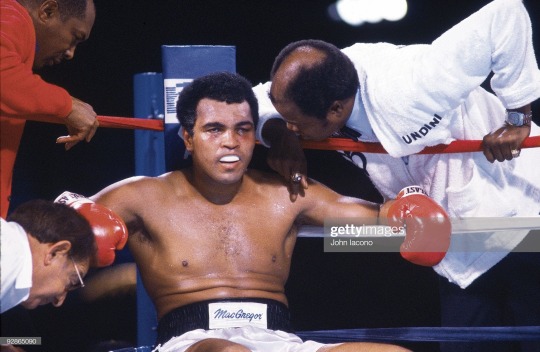
“They sacrificed Ali. That’s all it was, a human sacrifice for money and power. And it was more than a matter of Ali getting beaten up. One of the great symbols of our time was tarnished. So many people- blacks, whites, Muslims, Americans, Africans, Asians- believed in Ali. And he was destroyed because of people who didn’t care one bit about the things he’d stood for his entire life.”
-John Schulian, Writer.
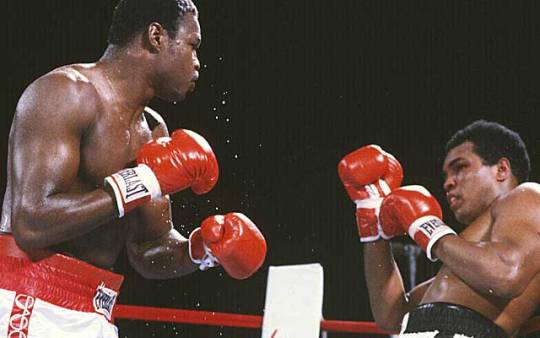
Holmes went into the fight knowing the same thing Ali knew all those years prior when he fought Cleveland Williams- he was fighting a man who had nothing left. Holmes cried after the fight in his dressing room and visited Ali’s hotel room telling him: “You’re still the greatest, I love you.”
“I want people to know I’m proud I learned my craft from Ali. I’m prouder of sparring with him when he was young than I am of beating him when he was old.” -Larry Holmes.
Holmes would rule the division until 1985, racking up a 48-0 record before fighting Michael Spinks. He’d already beaten his brother Leon in 3 rounds but he lost a unanimous decision then a split decision rematch to Michael and was therefore unable to match Rocky Marciano’s 49-0 record.
The day after the Ali-Holmes fight, Ali was called by Cus D’Amato who had watched the fight the night before with a 14-year old Mike Tyson. Cus introduced Mike to Ali as a ‘young black kid who is going to Heavyweight Champion of the world someday’. And he would be, just 5 years later. Over the phone Tyson vowed he would pay Holmes back for him when he grows up. He kept this promise knocking Holmes out in the 4th round in 1988.
Incredibly, the Holmes fight wouldn’t be Ali’s last. That would come over a year later and a month shy of his 40th Birthday. The Nevada State Athletic Commission had begun hearings to determine whether Ali should be able to fight again due to his health. So Ali voluntarily relinquished his license to fight in Nevada and pledged not to seek a new one. This left him the rest of the world to fight in.
The fight took place in an unfinished arena in Nassau, The Bahamas against Trevor Berbick. Less than 7,500 people attended the fight, many at a heavily discounted $5, down from $50. The last stand of Muhammad Ali was also only available in 3 million American homes on closed circuit television.
The boxing began late as people arriving to see the fight found they could not get in because the key to the main gate had been misplaced. When the key was found, it was discovered that there were no boxing gloves at the venue. There was also no bell to signal the end of a round; ultimately a hastily procured cowbell had to be used for this purpose. Because of the paucity of paying spectators Berbick refused to fight unless he was paid upfront. The fight started more than two hours behind schedule.
Ali, Berbick and Tommy Hearns (who was on the undercard) had their own dressing rooms atleast. The rest of the fighters were assigned to a sweltering locker room in which they shadowboxed side by side. So Ali fought for the final time in gloves that had already been boxed in 5 times that night by other men.
Against Berbick, a fighter much more limited than Holmes, Ali made the first 7 rounds competitive and was in the fight until he became exhausted at the end, comfortably losing the final rounds. But Ali did atleast go out on his feet rather than in his corner. He lost by unanimous decision for the first time since The Fight Of The Century a decade earlier.
Round Eleven- vs Leon Spinks I February 15 1978
The Thrilla In Manila had taken much of what Ali had left as a fighter, and what little he did have left after was taken in a extremely tough 15 rounder versus his old foe Ken Norton. But still, in those six successful post-Manila title defences, Ali whilst maybe being a mere shadow of what he was still- beat Chuck Wepner in a fight that inspired Sylvester Stallone to start writing a script for Rocky (Wepner knocked Ali down in the 9th round prompting him to go to his corner and tell his manager “Al, start the car. We're going to the bank. We are millionaires." To which Wepner's manager replied, "You better turn around. He's getting up and he looks pissed off."), knocked down British fighter Richard Dunn 5 times with Taekwondo Grandmaster Jhoon Rhee serving as his head coach (the punch Ali used to end the fight was called the ‘Acupunch’ and was taught to Rhee by Bruce Lee. Not a bad way to score the final knockout win of your career.), fought the ridiculously overmatched “Lion of Flanders”, the Heavyweight Champion of Belgium who drank plenty of champagne in his dressing room *before* the fight and won a 15-round unanimous decision against Earnie Shavers a man who coming into the fight had scored 52 of his 54 wins by knockout. Only Ali.
With George Foreman having fought his last fight for 10 years, Earnie Shavers was the hardest puncher in the division and is still one of the most revered punchers ever. He proved why in the 2nd round with a devastating overhand right which hurt Ali. “Next to Joe Frazier,” he would say “that was the hardest I ever got hit.” But Ali not for the first time used cunning successfully against a fighter. Shavers said “He wobbled, then he wobbled some more. He was so good at conning, I didn’t realise he was playing possum with me. I didn’t realise how bad off he was, when I watched the tape I saw it but at the time I was fooled.”
On this night Ali again showed unmatchable courage and built up a good lead on the cards but Shavers who usually gassed at the end of fights was pacing himself for a long fight and came on strong in the 13th. Sportswriter Pat Putnam said this about the final rounds of the fight: “The thirteenth round was Shaver’s best round to that point. The fourteenth was even better. Rocked by hard right hands, Ali survived but the legs that had carried him through 56 professional fights were beginning to fail. At the end of the fourteenth round, the champion had to dip into his reserve of strength just to get back to his corner. Wearily he slumped on his stool, his eyes glazed with fatigue. When the bell for the fifteenth round rang, Ali could barely stand...That fight with Shavers and particularly the last round sums up for me what Ali was about, even though he was long past his prime. Shavers could have taken him out. He had him hurt early but he suckered Earnie. He faked being more hurt than he was and conned him out of going for the kill. He fought through fourteen rounds. And people talk about Manila, they talk about Foreman, they talk about Liston. But to me the fifteenth round against Shavers was as magnificent as any round Ali ever fought. He was exhausted. I don’t know where he found the strength and stamina to go on, because when he went back to his corner after fourteen, there was nothing left in his body. But he came out for the last round and fought three minutes as good as any three minutes I’ve ever seen. Late in the round he even had Shavers in trouble. Only the ropes kept Shavers from going down.”
President of Madison Square Garden Boxing inc. Teddy Brenner implored Ali to retire after that fight, fearing he would end up punch drunk from the way he let his opponents hit him in order to tire them out. In a rare display of morality from a high ranking boxing official he said that “as long as I’m president, MSG will never make Ali an offer to fight again (bare in mind Ali had just filled MSG for his fight with Shavers). Ali is 35 with nothing more to prove. The trick in boxing is to get out at the right time and the fifteenth round last night was the right time for Ali.” Brenner would remain president until he was fired in 1978 after he refused to do business with Don King. Another fine decision.
Ali’s doctor and physician of 15 years Ferdie Pacheco also decided enough was enough: “the New York State Athletic Commission gave me a report that showed Ali's kidneys were falling apart. I wrote to Angelo Dundee, Herbert Muhammad (his manager), his wife and Ali himself. I got nothing back in response. That's when I decided enough is enough."
So Ali fought on in Vegas, where they had no such concerns. Knowing better than to give No.1 Contender Ken Norton a fourth fight, his opponent was Leon Spinks, a 1976 Olympic gold medallist in the Light Heavyweight category. This would be the fourth Olympic gold medallist Ali would face but the first to fight in the same weight category as him (Patterson fought in the Middleweight category, Frazier and Foreman at Heavyweight). But more revealing was the years in which they competed- Patterson back in 1952 and Ali, who won his gold in 1960 came along as the much younger man and pushed Patterson towards irrelevancy. But now he was fighting a young, fresh man who’d won gold 16 years after himself. A new and different era.
Spinks was only 24 years old and with only six professional wins on his resume, aswell as one defeat. He’d been watched by Ali and he and his team were happy- this guy wasn’t any good and would be an easy fight. A 55-2 Champion against a 6-0-1 challenger, it promised to be mismatch of the decade.
Ali was struggling to motivate himself for this fight and as often the case when fighting an opponent he didn’t rate, he trained very little. His opponent was struggling in the build-up for another reason. As his manager Butch Lewis puts it: “the biggest problem was psyching him up to be aggressive. All the time I gotta remind him ‘it’s not personal, you can love Ali but you gotta hit him to win the fight.” Spinks trained hard and was kept focused and disciplined by his team. They believed he could pull of an upset aslong as he gave everything to achieve his once in a lifetime shot to become the World Heavyweight Champion.
Spinks had only fought 33 professional rounds in his life when he stepped into face Muhammad Ali. He looked like a light heavyweight, weighing under 200 pounds. But he was young, fresh and hungry and that was enough.
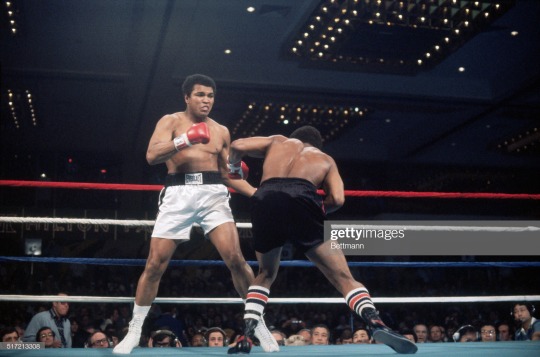
The 11th round was key in this fight as it was actually the first time Spinks had ever gone past the 10th round in his life, being that it was his first 15 round fight. Ali’s best moment came in the 10th when he rallied and wobbled Spinks but he was unable to keep up the charge. Ali was by this point a master of going the Championship distance and expected this to be around the time Spinks would tire for Ali to take over the fight. But Spinks didn’t tire. Instead Ali did. The fight came to an exciting conclusion when both men went hell for leather in the final round. 2 judges gave the fight to Spinks and for the first and only time ever Ali had his title taken from him in the ring losing a split decision to the 10-1 underdog.
“Of all the fights I lost in boxing, losing to Spinks hurt the most. That’s because it was my own fault. Leon did the best he could but it was embarrassing that someone with so little fighting skills could beat me. I didn’t train right, the last 3 rounds, when I tried to come on, I wasn’t in shape. After that I had to fight him again. I wanted to get my title back. What they paid me didn’t matter. I just couldn’t leave boxing that way.” -Ali on his loss to 10-1 underdog Leon Spinks.
It could hardly be claimed the victory went to Leon’s head, he remained humble saying: “I still love Ali, he’s my hero. Ali’s the greatest, I’m just the latest.” but he struggled with the leeches and hangers-on overnight success brings. Shortly after the fight he was arrested for having $1.50 worth of marijuana and cocaine on him. Rather than prepare for his first title defence, Spinks would do anything but train, partying away surrounded by hangers-on enjoying the ride, and disappearing all the time, away from all the attention which threatened to overwhelm him.
“It was time to start training seriously and I tracked him down in North Carolina in a little shack drinking moonshine whiskey. He’s smoking dope, groggier than hell, like this is a dream and he’s gonna enjoy it because any day he might wake up. At most he trained 10 days for the rematch.”
-Butch Lewis on Spinks’ less than ideal preparation for the rematch.
Ali to the contrary pushed himself harder than ever before. He ran 3 to 5 miles each morning before breakfast. He sparred around 200 rounds, more than he had in years.
“The day after the fight, sometime around 2am Ali was getting ready to go out the door saying to himself “gotta get my title back. Gotta get my title back.” He went out running down the damn freeway, punching, shouting “Gotta get my title back!” his hands were blazing real fast. Sweat was streaming down his face. He kept it up for almost an hour until he was exhausted.” -
Harold Smith, chairman of ‘Muhammad Ali Professional Sports’.
“All my life I knew the day would come when I’d have to kill myself. I always dreaded it and now it’s here. I’ve never suffered like I’m forcing myself to suffer now. I’ve worked this hard for fights but never for this long. All the time I’m in pain. I hurt all over, I hate it, but I know this is the last time I’ll have to do it. I don’t want to lose and look back saying ‘Damn I should have trained harder.”
-Muhammad Ali on his training for the Spinks rematch.
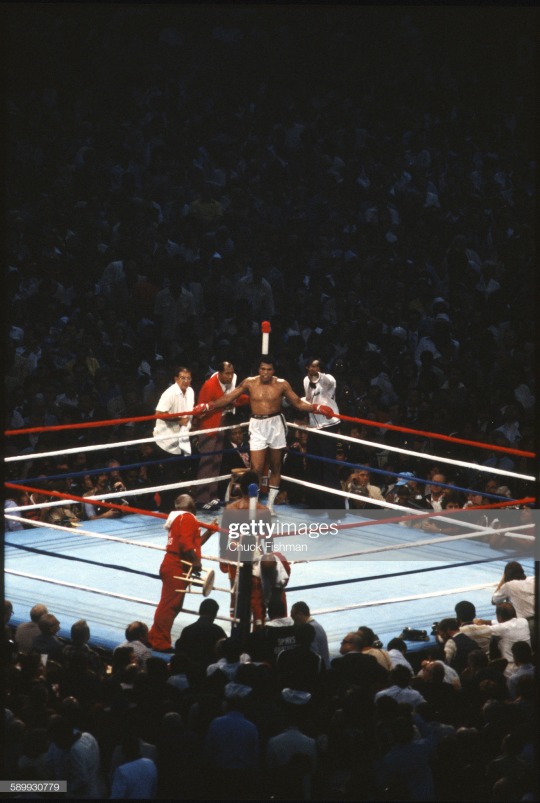
5,000 or so fans were in attendance the night Spinks dethroned Ali. 63,350 were in the New Orleans Superdome for the rematch. The place was packed and humming with excitement as Ali aimed to become the first 3 time World Heavyweight champion and the oldest aged 36. There was no interest in the first fight, no appetite amongst the public to see an over-the-hill Ali bore his way to a decision against a less than top contender. But now the narrative was interesting, people wanted to see if history could be made, if Ali could once again defy expectations. 7 months on from looking as old and finished as he ever had, could Ali defy all inevitability by somehow looking younger and better against the man 11 years his junior?
Yes is the answer to that and he did so on a night when Joe Frazier sang the American National Anthem and infront of a raucous crowd that often reached deafening decibels.
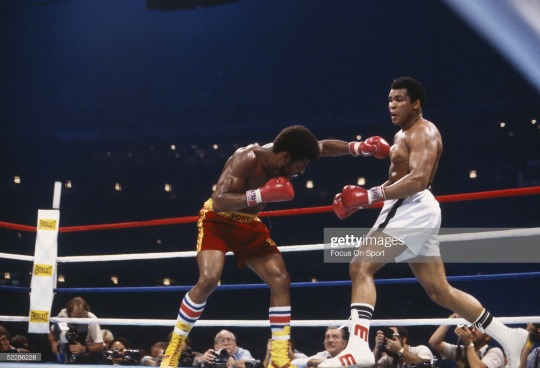
The early rounds were competitive, the big thing was Ali wasn’t doing any rope-a-doping, he wasn’t about to let Spinks build up a lead this time. Ali was commanding with his jab and his movement was the most surprising aspect of the fight, he moved like a man doing a pretty good imitation of the Ali of half a dozen years ago. Spinks was unable to ever change the momentum of the fight and Ali dominated the score cards winning atleast 10 rounds on all 3 cards to earn the final win of his career. He remains to this day the only 3-time Lineal Heavyweight Champion in history. Leon Spinks never reached such heights again and he retired with a record of 26 wins, 17 losses and 3 draws.
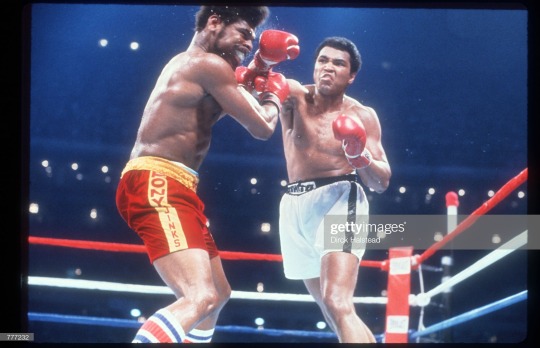
“May your song always be sung, may you stay forever young.”
-Howard Cosell on commentary quotes Dylan.
Round Twelve- vs Ken Norton I March 31 1973 & vs Ken Norton II September 10 1973
“The whole time I wasn’t allowed to fight, no matter what the authorities said, it felt like I was Heavyweight Champion of the world. Then I lost to Joe Frazier. And what hurt wasn’t the money that losing cost me. It wasn’t the punches I took. It was knowing that my title was gone. When I beat Sonny Liston I was too young to appreciate what I’d won. But when I lost to Frazier, I would have done anything except go against the will of Allah to get my title back again.”
-ALI.
On June 28th 1971, 50 months to the day Ali refused induction into the US Army, the United States supreme court unanimously reversed his conviction and all criminal charges against him were dropped. The justices initially had it 5 to 3 in favour of upholding Ali’s conviction, then one justice who was dying of cancer decided to shift his vote to make it 4 to 4. This would still have seen Ali go to prison.
Thankfully in the end, Justice Potter Stewart put forward an argument for Ali in such a way it meant that Ali’s conviction could be reversed without ruling that members of the Nation of Islam were entitled to conscientious objector status which was enough to appease everyone into overturning his conviction.
“It’s like a man’s been in chains all his life, and suddenly the chains are taken off. He don’t realise he’s free until he gets the circulation back into his arms and legs and starts to move his fingers. I don’t really think I’m going to know how that feels until I start to travel, go to foreign countries, see those strange people in the street. Then I’m gonna know I’m free.”
-Ali after the US supreme court vote to drop all charges against him.
Ali had his boxing license back, his passport back, but he did not have his titles back. That was one thing he was going to have to get back on his own.
After The Fight of The Century, Ali was taken straight to hospital but he left without spending the night, not wanting the world to think Frazier had hospitalised him. Frazier himself was in the hospital much longer, around a month due to hypertension and a kidney infection which were exacerbated by the brutal fight.
Ali would have to wait for another shot at Frazier, with Smokin’ Joe showing no sign of wanting to fight Ali anytime soon. Or indeed anyone else for that matter as the Champion did not fight for the remainder of 1971. Ali on the other hand fought three more times that year including against Jimmy Ellis, a former sparring partner whom he’d sparred over a thousand rounds with. Ellis, who was trained and managed by Ali’s own trainer Angelo Dundee also had Dundee train him for this fight with Ali’s consent, as it meant Dundee could pick up more money as both Ellis’ trainer and manager, rather than the much smaller fee he received from Ali as a trainer. Despite clearly being better prepared to fight Ali than anyone else in history, Ellis was still stopped in the 12th and final round.
One fight in this time that Ali didn’t have but almost had was against Wilt Chamberlain, a 7 feet 2 basketballer who really figured he could beat Ali due to his enormous height. He was trained by Cus D’Amato and thought by focusing his boxing solely on fighting Ali, he could learn enough to win the fight. Ali’s extreme confidence for this bout (given he was a world class boxer going against a basketball player making his pro debut) is thought to have scared Chamberlain off, and the thing was suddenly off on the day of contract signing.
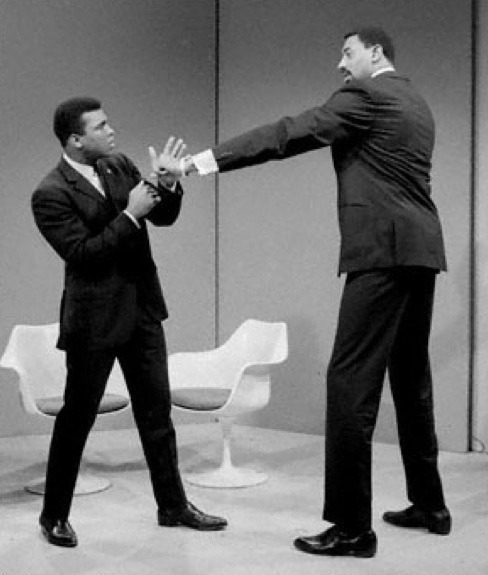
By the end of 1972, Ali had bounced back from the Frazier loss with 9 straight wins against occasionally decent, occasionally mediocre opposition. After years without his passport, he also got back on the road fighting in Switzerland, Japan, Canada and Ireland. Ali’s performances however were not highly praised, he was slacking off in training as he struggled to motivate himself for it, and counting on his superior skills in the ring to take him to victories over much less gifted fighters. There was doubts though as to whether this Ali was going to be good enough when it came to a fight for the title with Frazier who had fought just twice since beating Ali with 2 wins in a combined 7 and a half rounds.
Then came 1973, the year that shook up Heavyweight boxing and changed everything. First on the 22nd of January in Kingston, Jamaica, Joe Frazier was dethroned in devastating fashion by 1968 Olympic Gold Medallist and 4-1 underdog George Foreman. Big George was fighting his 38th bout despite only having turned 24 twelve days prior. He became the third youngest Heavyweight Champion in history with a vicious display of punching power.
Frazier was dropped six times in little over 5 minutes and despite gamely getting up and trying to carry on each time in the end Arthur Mercante, referee of the Ali-Frazier 1 fight had to stop it (which was a relief to Angelo Dundee who was ringside and pleading for the fight to be stopped) and Joe Frazier was beaten for the first time in his professional life.
“DOWN GOES FRAZIER! DOWN GOES FRAZIER! DOWN GOES FRAZIER! The heavyweight champion is taking the mandatory 8-count, and Foreman is as poised as can be! In a neutral corner, he is as poised as can be.”
-Howard Cosell as Frazier is knocked down for the first of six knockdowns.
Then on March 31st Ali faced Ken Norton, a fighter with a record of 29-1 but few respected names on his resume. Whereas in Ali’s prior bout against Joe Bugner in Vegas he’d enter the ring in a robe bearing the legend “The People’s Champion” gifted to him by the King Elvis Presley, Norton’s previous bout had been in front of 700 spectators for a $300 dollar purse.
Ali trained less than 3 weeks and was hampered by a sprained ankle, an injury he’d picked up whilst in his words ‘revolutionising the game of golf’. After Ali entered the ring Howard Cosell who was doing commentary for the bout even remarked that: “It seems to me that Ali has taken Kenny Norton more lightly in the pre-fight build-up than any opponent I have known him to fight.”
Ken Norton was an old sparring partner of Joe Frazier’s and Frazier’s trainer Eddie Futch also trained Norton. Here’s what he said of the bout: “The biggest mistake Ali’s people ever made was putting him in the first time with Ken Norton. He’d been sparring with Frazier for several months, he was very sharp, style-wise he was hard for Ali and he was coming into his own as a fighter. Norton had four more inches of height than Frazier and he had a good jab, not as good as Ali’s but pretty good. I told him to step toward Ali with his jab. Norton’s right hand being in the proper position would mean Ali’s jab would be blocked. And Norton’s jab would hit Ali in the middle of the face, because Ali kept his right hand out of position. Do that a couple of times and being Heavyweights, Ali would be back against the ropes.”
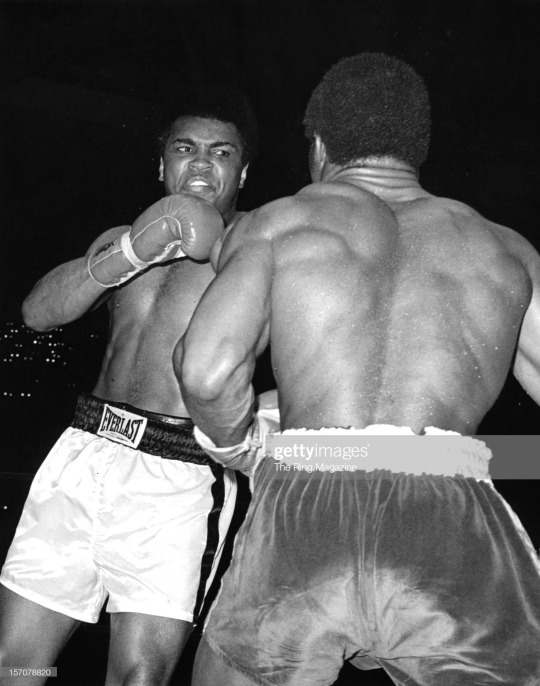
In the second round, Ali was back against the ropes when Norton threw a straight right, nailed him and broke his jaw. Ali’s mouthpiece which was taken out between each round and usually just had slobber in it, was now full of blood after each round to the point it turned his bucket in the corner, which was filled with ice and water, red.
“The jaw was broken in the 2nd round. He could move the bone with his tongue and I felt the separation with my fingertips at the end of the 2nd round. All of us and I have to include myself- were consumed by the idea of winning that fight. My whole thing was to keep Ali fighting. I should have said ‘stop the fight’ there’s no disgrace in having a broken jaw. It goes down as a TKO, you have a rematch six months later. And life goes on. But Ali was supposed to beat Norton, he couldn’t afford a loss. Also, if Ali lost it was more than a fight. There was always politics involved, you didn’t stop the fight as a white guy especially when Ali didn’t want it stopped. Ali knew his jaw was probably broken but he said he didn’t want it stopped, he’s an incredibly gritty son of a bitch. The pain must have been awful. Yet he still fought the 12 rounds. God Almighty, was that guy tough. Underneath his soft, generous ways, underneath all that beauty there was an ugly trucker at work.” -Ferdie Pacheco.
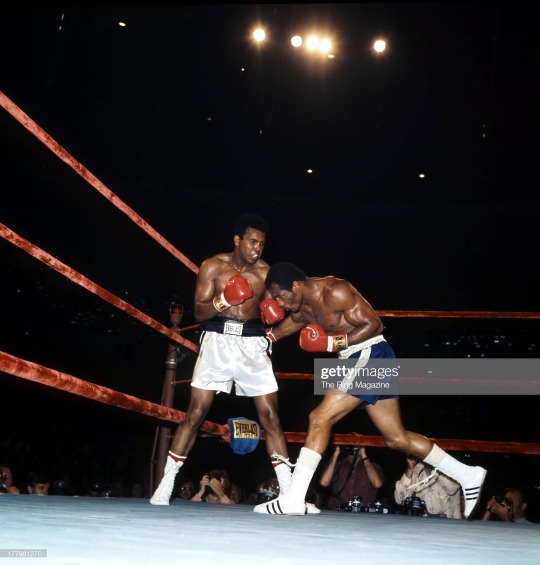
Ali looked slow and sluggish in the fight which was dull. He didn’t fight a good round until the 11th where he looked to come on strong as he often did to snatch the fight late. The 12th and final round was the decisive round of this fight. One judge had Ali 2 points ahead, one had Norton a point ahead and the third had the fight even. Norton won the final round and because of this he won the fight. Afterwards, Ali had 90 minutes of surgery with Dr. William Lundeen who performed the surgery saying of Ali’s jaw: “A clean break all the way through. I can’t fathom how he could go on the whole fight like that.”
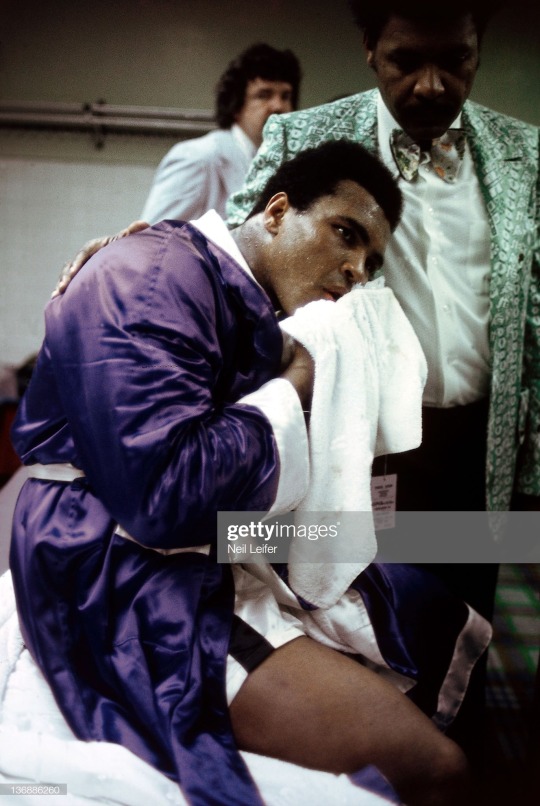
Losing to Frazier was one thing, but losing to a fighter like Ken Norton was something else and gleeful members of the press jumped all over it with one saying: “Ali has a big name and not much to defend it with. It isn’t a big achievement but a kid coming up can be made by knocking out Ali. He is the guy the hungry kids want to get their hands on. Ali is a loser now, and they match old losers with young winners.”
Sports Journalist and good friend of Ali Howard Cosell sums up the mood after Norton beat Ali. “It was the end of the road as far as I could see. Ken Norton, a former marine, in the ring against a Draft Dodger. Richard Nixon had just been reelected with a huge mandate. Construction workers were marching through the streets supporting the war in Vietnam, which showed no signs of winding down. It seemed as though Ali would never get his title back again.”
Where once one man stood between Ali and the Heavyweight title, there was now 3: Joe Frazier, Ken Norton (who had both already beaten Ali) and the Invincible looking George Foreman. Ali had been 3 and a half years out the ring, he was no longer the same fighter and he was now 31 years old. He had no chance.
“He is a beaten man and he is a broken fighter, what was once a very great fighter becomes now part of fistic history in all probability.”
-Howard Cosell live in the ring moments after Ali’s decision loss is announced.
Step one of getting the title back was winning a rematch with Ken Norton which took place six months after their first fight due to the length of time it took for Ali’s jaw to heal. This time Ali trained hard, he was no longer overlooking or underestimating Norton, he knew he’d be in for a tough fight.
Norton trained hard also and the outcome was a great fight, a much better spectacle than their first fight. This time both men looked like top Heavyweights, rather than one looking like a has been and the other looking like someone who’d just got Ali on the right night. Norton proved on this night he could give Ali a hell of a tough fight even when he’d trained hard, was prepared right and wasn’t fighting with a broken jaw.
Ali came in 9 pounds lighter than in their first fight, it was the lightest he’d come in since before the Frazier fight. He’d lost the flab around his gut as in training he’d focused on “whipping his Adonis-like physique back into shape.”
The lighter and fitter Ali was up on his toes constantly moving for the opening four rounds, Norton was unable to land much atall. Ali though establishing a lead on the cards through the first third of the fight had been unable to land a shot which made Norton respect his punching power.
This emboldened Norton and the 5th round signalled a change of direction for the fight. It was about to become a whole lot closer. Norton began to have some success in cutting down the ring on Ali and began landing some good shots.

The 6th round was close with both men having good success at times, the fight was at a frantic pace as it entered its second phase. The 7th was Norton’s best round of the fight, Ali seemed to be tiring and wanting a breather. He was forced to absorb a barrage of blows from Norton and at a point seemed to be summoning all his willpower just to cling on and remain on his feet.
As the fight built towards its climax, Norton began to time Ali excellently and the jaw that had been broken by Norton six months prior was forced to soak up more punishment. The final minute of the 9th round was a thriller, Ali tired of dancing stood and traded with Norton, no decisive blow either way was struck but the fans were being treated at this point.
Ali was forced to take a battering in the 11th with Norton clearly sensing blood and throwing with frequency and force desperately trying to take his man out. Ali was going nowhere but going into the final round the scorecards would be close.
Ali had boxed very well, it was his best performance for a long time but still Norton had been able to trap Ali in corners and Ali had been unable or unwilling to tie up his man to prevent the barrage. Norton was extremely confident with no fear of Ali’s power and having plenty of success landing on Ali either with big powerful shots or with his jab which was proving very effective too.
The hard miles Ali did in training for this bout made the telling difference in the fight as in the 12th round Ali came out still strong in the legs and he did the better work in this round, dominating the first minute before a more even final two. But Ali definitely won the round and he won a split decision with the deciding vote going to the referee who scored it 7-5 for Ali.
After the bout Ali looked absolutely exhausted, he’d certainly never before looked as tired after a fight. He rested both his arms on the ropes and looked out into the crowd, not speaking or even acknowledging anyone in his corner. Even as the scores were announced Ali remained motionless and in his post fight interview he was too tired to brag, or slate his critics, or call out Foreman or Frazier, he praised Norton and acknowledged the fact he was a little more tired than usual, because of his age.
Muhammad Ali had 9 rematches in his career, 11 if you include his 3rd fights v Frazier and Norton where he would go beyond avenging losses to take the lead in their head to heads. He won all 11. Nobody would beat Ali the second time around, regardless of whether they won the first fight or lost.
On a physical and mental level Joe Frazier was Ali’s toughest adversary in the ring but on a technical, tactical level it was Ken Norton. In 1976 they fought a third fight to decide the winner of their series. It was their only fight scheduled for 15 rounds and just like their two 12-rounders it went the distance, it was the only time they fought with the World Heavyweight Championship on the line.
George Foreman said of the Ali-Norton match-up “It was Norton’s style of keeping his right hand up in front of his own face. He would catch Muhammad’s left jab and he was tall enough with a long enough reach to jab back. Frazier did well against Ali in close, but he didn’t have the reach on the outside the way Norton did. Muhammad had a rough time with Norton.”
Ali won the final fight of the trilogy in a close, hotly disputed decision which was audibly booed by some in the crowd. The judges scored it unanimously for Ali 8-7, 8-7, 8-6-1. The fight was far too close and debatable to ever be reasonably called a robbery but it was by far the most controversial of all Ali’s 19 points decision victories.
As with the first two the fight was decided in the very last round, even more so this time. The fight was even on two scorecards and Norton trailed by a point on the other. As Norton sat down for his final pep talk of the night before going out to fight the final round his corner advised him to not take any chances, that the fight was won and to not give Ali the chance to steal it. So he fought the final round cautiously. Meanwhile in Ali’s corner Angelo Dundee told him: “Fight like hell this round, we need it.” That’s what Ali did and he won that last round and subsequently the fight.
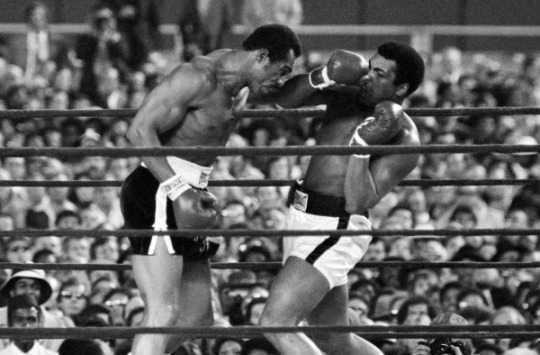
“The first time I fought Ali I felt it was an honour just to be in the same ring with him. I liked him before we fought, after we fought, just not during. I don’t want to be remembered as the man who broke Ali’s jaw, I just want to be remembered as the man who fought three close competitive fights with Ali and became his friend when the fighting was over.” -Ken Norton on the Ali-Norton Trilogy.
Round Thirteen & Round Fourteen- vs Joe Frazier III October 1 1975

"It will be a killa and a thrilla and a chilla when I get the Gorilla in Manila." -Muhammad Ali
Ali’s third title defence of his second reign was against Joe Bugner in Malaysia. Ali had already faced Bugner once before beating him by unanimous decision in a slow, dull fight. The same outcome was expected this time so there was very little hype and interest in the fight. To change this, it was suggested to Ali that he should tell the press he’s retiring and that this will be his last fight. And Ali was extremely convincing.. until the prospect of another fight against a certain someone came up. “What about Joe Frazier? Aren’t you going to fight Frazier again?” A reporter asked and Muhammad’s eyes lit up. “Joe Frazier! I want him bad. How much money do you think I can get if I go whup Joe Frazier?”
And so Muhammad Ali would face his old foe one last time in Manila, Philippines. In the build-up to the fight, Ali was more personal than ever before. He regularly called Joe a Gorilla, and would punch an action man sized Gorilla which he refereed to as Frazier. Former MLB player Reggie Jackson said this: “The one time Ali stepped over the line was with Joe Frazier. Joe’s a hard-working, decent, honest man with very little formal education. He’s a proud man with great honour about him. Muhammad ridiculed Joe. He humiliated him infront of the world. He took the English language and ripped him to shreds with it. Joe couldn’t match wits with Ali he didn’t have the verbal skills. So his response was to get more angry and bitter. It hurt Joe that black people loved Ali more than they loved him.” Whilst Ali explained his pre-fight antics as a deliberate tactic to get his man mad, because “if he’s mad, he cant think” he succeeded in getting Frazier so mad that just as in the first fight, Frazier was made so mad he was willing to die in the ring to hurt Ali.
Joe wasn’t the only person angry with Muhammad Ali in the build-up to the Thrilla in Manila, another was Muhammad’s wife Belinda Ali. Ali had been involved in an extramarital affair with a woman named Veronica Porsche since around the time of The Rumble In The Jungle. Belinda had been aware of the affair but not how serious it had become. She became aware when Muhammad brought Veronica along to meet the President of the Philippines, Ferdinand Marcos and his wife. Ferdinand told Ali how beautiful his wife was and infront of the assembled press Ali was too embarrassed to correct him. After this incident Ali decided to confront the issue and come clean to the world about the affair saying “I could see some controversy if she’s white but she’s not. The only person I answer to is Belinda Ali and I don’t worry about her.”
Well if he wasn’t worried about her, he was about to be because Belinda was on her way to the Philippines. She arrived in his hotel room where the two had a heated one hour shouting match where no doubt Belinda was the loudest. The last thing she said was “You tell that bitch if I see her, I’m gonna break her back. If I see her anywhere I’m gonna break her back.” Belinda then went straight back to the airport and flew back home. Ali and Belinda divorced two years later in 1977 and he also married Veronica that year.
With Ali vs Belinda out of the way, and Belinda vs Veronica thankfully (for Veronica’s sake) being narrowly avoided, the only fight left for Manilla was Ali vs Frazier 3. Though his infidelity coming out in the press was hardly ideal buildup to a huge and difficult fight, Ali had gone into fights before with even bigger strain, such as when he was fighting whilst the threat of death and prison loomed. Dave Wolf who was in Frazier’s camp believed in retrospect that this stuff actually helped Ali to thrive come fight night as it allowed him to not get tied in knots worrying about the fight itself. Whilst chaos raged as it so often did around Ali in the build-up to a fight, Frazier prepared outside of Manilla, in the mountains where he would ready himself for the bout by sitting for hours in a contemplative state.
The referee would be a Filipino as Frazier’s team worked to ensure the referee for the Ali-Foreman bout wouldn’t referee this one as they did not want Ali to be allowed to clinch on the inside unpenalised. Ali’s team however were worried about Frazier’s frequent shots below the belt, as he would pound Ali’s hips and legs to diminish Ali’s movement. And it was part of Frazier’s gameplan for this fight, as it had been for their previous bouts to hit him anywhere: “If you kill the body, the head will die.” so the old boxing axiom goes.
Ali’s strategy was to make a very fast start. Frazier was a notoriously slow starter and Ali wanted to knock him out in the early rounds, or atleast hurt him badly enough that Frazier wouldn’t be his most effective for the rest of the fight. Going into this fight Ali was a couple of months shy of his 34th birthday and Frazier though not yet 31 was considered to have less left than even Ali, who had not looked great since the Rumble In The Jungle. So with a lot less expected of them than in the Fight of The Century, the two men met for the deciding fight in their trilogy. They produced the Greatest Heavyweight Fight of all time, the greatest back-and-forth fight ever and one of, if not the, greatest fight ever.
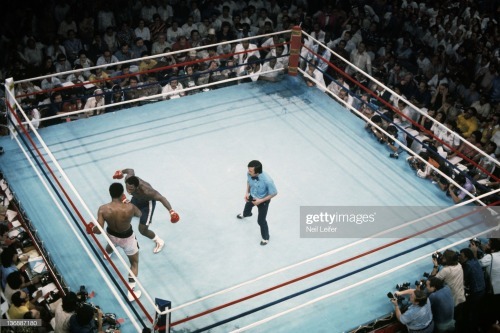
The bell for the first round sounded at 10.45am local time at the Araneta Coliseum, Quezon City in the Metro Manilla district of The Philippines. Ali started furiously fast, flat footed and infront of Joe, never backing off or looking to dance and move. Ali hit him with countless, blistering shots but Frazier was as hungry as he’d been for their first fight and he was not going to be deterred no matter what punishment Ali handed out.
The referee, as Frazier’s corner had hoped, constantly warned Ali not to hold the back of Frazier’s head. As this meant Ali could not smother Frazier’s attacks on the inside he instead employed an extended guard to block Joe’s vision and keep him at bay. As he could not smother he vowed to not let Frazier in close atall. Frazier in response upped the pace further and was able to close the distance, taking advantage of Ali’s extended guard by hooking at his exposed, vulnerable body. So with holding and clinching off the menu, there was no resting on the inside for either man, their only option was to exchange blows or in Ali’s case, cover up.
Frazier was beginning to have sustained success at getting on the inside, then staying there with Ali for a while. Frazier would continually march forward, as if oblivious to the shots Ali was landing on him and in the end Ali was forced to change tactic. Ali began to use the ‘rope-a-dope’ to conserve energy and get Joe to use up his, but the tactic was rarely less successful than here. Frazier was a great inside fighter, much better than Foreman for example, and was happy for the chance to pound Ali anywhere, on any unprotected area of Ali’s body he could find.
Ali regained control in the 4th, despite Frazier taking any opening he could find to pound Ali’s hips to limit his mobility in later rounds, this round clearly belonged to Ali who controlled distance with both hands, delivering crosses into Joe’s skull whilst ducking his hooks. In the 5th however Frazier started smokin’. He started getting through Ali’s defence. He would punch Ali’s arm aside then come up underneath to bypass his extended guard and he was also having success by punching against Ali’s highguard to activate it then digging into his ribs. Frazier expertly carried out his plan to crowd Ali, hurry him by accelerating the tempo and forcing him to fight at a quicker pace than he was comfortable with. All told Ali was trapped up against the ropes for two minutes of the 5th round.
In the 6th, Frazier staggered Ali with a leaping gazelle punch and seconds later he hit him with another whipping left hook. Ali again fell back into the ropes behind him, but seemed only slightly dazed. These punches would have KO’d most men but Ali remained on his feet and finished the round. Years later when re-watching the bout, Frazier would shake his head in disbelief at how Ali had withstood these punches.
“I’ve never seen two people give more, ever.”
-Ed Schuyler, boxing journalist on the Thrilla in Manila.
At the beginning of the 7th round Ali whispered in Frazier’s ear: “they told me you was washed up Joe.” to which he simply replied “they lied.” Ali recognised he’d lost the last rounds, in Dundee’s words ‘giving them away’ by attempting to rest on the ropes which you don’t do against Joe Frazier. Ali came out dancing in the 7th, throwing a multitude of different punches but Joe just continued to up the ante and Ali was again forced to rest on the ropes for the last minute, having punched himself out.
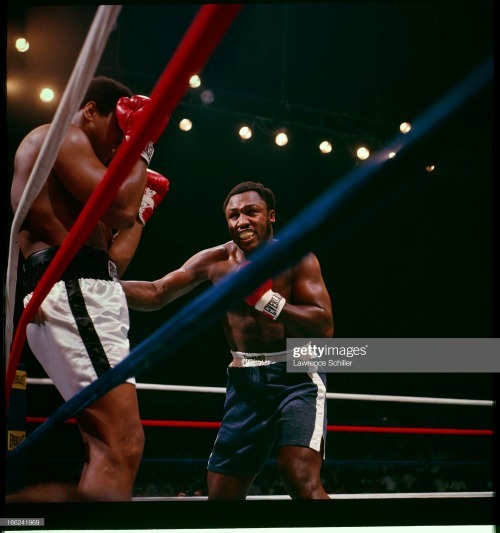
No longer able to dance, Ali had his wings clipped by Joe in the 7th but he could still sting like a bee. In the 8th he went toe to toe with Joe in a brutal round. Frazier like always when fighting Ali, was happy to take a few shots to land one of his own but these were not the light, flicking shots he was used to from Ali who was landing shots with full force. But Ali was once again forced to grab a breather before the end of the round and Frazier jumped on him pounding the body.
Ali took a lot of punishment in the middle rounds. Frazier was absolutely relentless, always on him. The air conditioning didn’t work so the heat in the arena was incredible, unforgiving and that’s just for people in the arena watching the fight. Let alone being in an intense, physical, non-stop war under the lights with their added heat. Ali was nearly 34, in his 51st fight, being put under extreme, constant pressure by a relentlessly aggressive, powerful fighter. Most men would have wilted, at a time it looked inevitable that even Ali would be forced to give in. He was having trouble just staying awake between rounds, such was his point of exhaustion. Ali spent these rounds in sluggish retreat, throwing little, clinching, covering up and dancing as best he could. The only consolation was Frazier’s emotions were now starting to get the better of him- he was constantly headhunting, even when those shots weren’t on, rather than continuing the assault on Ali’s body and battering his arms which could have stopped Ali’s ability to throw punches. After the 9th round, Ali went back to his corner and told his trainer “Man, this is the closest I've ever been to dying."
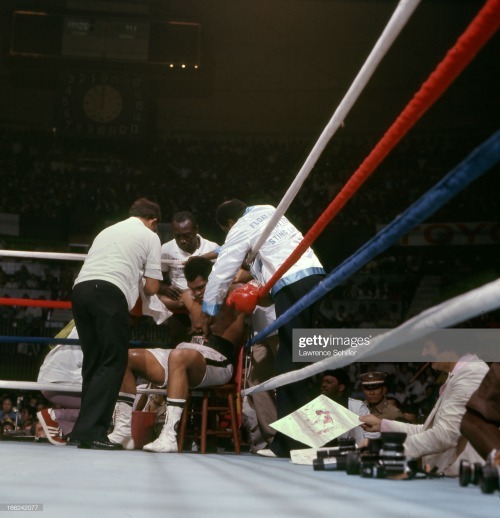
Ali began to turn the tide back in his favour, in the 11th round he began to unload a series of fast combinations. The round began with Frazier giving Ali a beating on the ropes but for the Champion this was a painful but necessary thing as even as he allowed his body to be used as a punching bag he stored up the strength required for a rally at the end, dragging Frazier into the centre of the ring where he paid him back for his punishment dishing out his own and swelling his opponents eyes. Whilst Frazier was a marathon runner, maintaining a constant, steady pace whilst gradually weakening, Ali was a sprinter, taking long intervals without much activity before exploding into life and throwing his all into it.
All fight long Ali had aimed exclusively for Frazier’s head and the accumulation of hundreds of punches had swelled Frazier’s face to the point he was fighting with tiny slits for eyes. Frazier now couldn’t see out of his left eye which had already been damaged in a training accident, years earlier. He could no longer see Ali’s rights coming and he was being hit with them over and over again. Frazier’s trainer Eddie Futch instructed his man to change his posture thinking this would allow him to atleast see the punches coming but it left him more open. Ali digging deeper than he ever had needed to before came out throwing everything at Frazier, giving him a sustained beating unlike any he’d dished out to his foe previously.
Futch considered pulling his man out after the 13th, seeing the damage Frazier and his eyes were taking, but he also saw the extent of Ali’s physical and mental fatigue and he knew Frazier still possessed the power in his fists and his mind to triumph in the fight. He decided to give Frazier one last round.
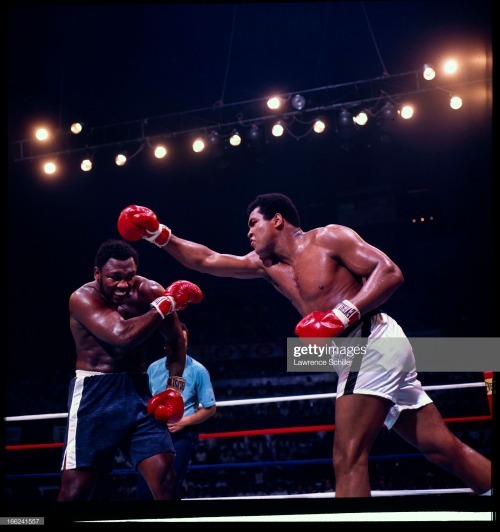
With both men’s legendary, extraordinary skill, physicality and willpower being stretched to the very end of their limits, the men fought on with failing bodies, will alone keeping them up and punching. Then Ali again found yet more resolve he didn’t know he had, launching yet more assaults on Joe but Frazier again as he always seemed to do against Ali, endured, remaining on his feet to the bewilderment of the Champion.
British Sportswriter Frank McGhee describes the final 2 rounds of the fight: “The main turning point of the fight came very late. It came midway through the thirteenth round when one of two tremendous right-hand smashes sent the gum shield sailing out of Frazier's mouth. The sight of this man actually moving backwards seemed to inspire Ali. I swear he hit Frazier with thirty tremendous punches—each one as hard as those which knocked out George Foreman in Zaire—during the fourteenth round. He was dredging up all his own last reserves of power to make sure there wouldn't have to be a fifteenth round.”
Unbeknownst to Frazier's corner, at the end of the 14th round Ali instructed his cornermen to cut his gloves off, but Dundee ignored him. Ali later said "Frazier quit just before I did. I didn't think I could fight anymore." With a round to go, Frazier’s trainer Eddie Futch decided it was a round too many, he’d seen enough. Frazier tried to prevent the stoppage telling Futch “I want him boss.” but his protests were unsuccessful with Futch replying “It's all over. No one will forget what you did here today." The Thrilla In Manilla therefore became the first and only Ali-Frazier fight not to go the distance after it was stopped after 14 of the scheduled 15 rounds. After the fight Ali declared Frazier the greatest fighter of all time except for himself.
“Ali and Frazier were fighting for something more important than the Heavyweight Championship of the World. They were fighting for the championship of each other. I don’t even think about who won in Manila, what matters most about that fight is how great it was. Both men gave it everything they had. They knew it was probably the last time they’d face each other.”
-Jerry Izenberg, sports journalist.
“It took about 24 hours for his brain to recuperate, for the thought processes to become complete. And the effects on the rest of the body lasted for weeks. It was the toughest fight I’ve seen in my life.”
-Ferdie Pacheco, Ali’s doctor and physician.
“We were gladiators. I didn’t ask no favours of him and he didn’t ask none of me. I don’t like him but I gotta say, in the ring he was a man. I hit him punches, those punches.. and he took ‘em. He took ‘em and he came back, and I got to respect that part of the man. He was a fighter. He shook me in Manila, he won.”
-Frazier on Ali.
“I don’t think two big men ever fought like me and Joe Frazier. One fight, maybe. But three times, we were the only ones. Of all the men I fought in boxing: Sonny Liston was the scariest, George Foreman was the most powerful, Floyd Patterson was the most skilled as a boxer. But the roughest and toughest was Joe Frazier. He brought out the best in me, and the best fight we fought was in Manila. I’m sorry I hurt him(with words, rather than punches). Joe Frazier is a good man. I couldn’t have done what I did without him and he couldn’t have done what he did without me. If God ever calls me to a holy war, I want Joe Frazier fighting beside me.”
-Ali on Frazier.
Ali and Frazier never faced each other again and after 3 fights, 41 rounds, thousands of punches and only one knockdown, the in-ring rivalry at least was over. Frazier fought only twice more, never winning again and losing a rematch with George Foreman in 5 rounds. Ali fought 10 more times but much of what Ali had left as a fighter left him that night in the Philippines.
That night only Ali attended the reception given by President Marcos. He was battered, bruised and hurting when he accepted the congratulations of Frazier’s wife with a smile and the extension of his fingers. Meanwhile Frazier lay on a bed in semidarkness. “His eyes are just about completely shut.” said Futch explaining his fighter’s absence.
A light was turned on as an old friend walked within two feet of Joe Frazier who lifted himself to look around but still could not see. Upon being informed of his visitors identity he said:
“Man, I hit him with punches that'd bring down the walls of a city. Lawdy, lawdy, he’s a great champion.”
Round Fifteen- vs Joe Frazier I March 8 1971
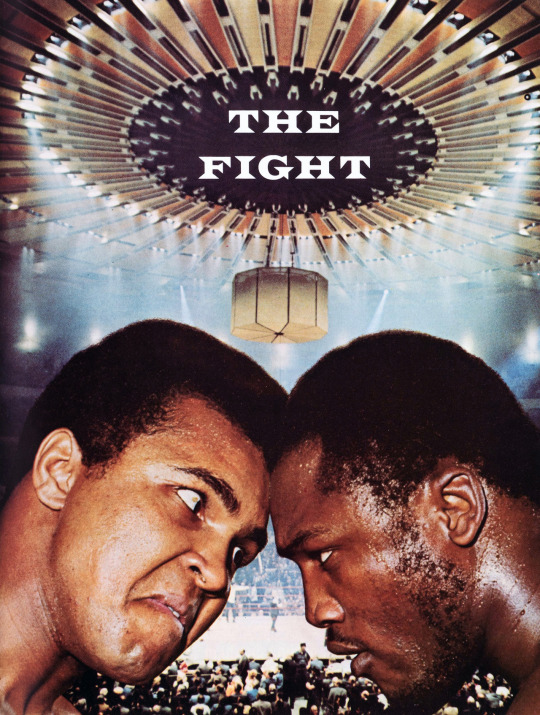
Smokin’ Joe Frazier won Gold for America in the ‘64 Olympics, four years after Cassius Clay. Just like Clay, he won the World Heavyweight title in his 20th fight, or a version of it atleast. The title was made vacant when Ali was stripped and 2 years later Joe unified the division beating Jimmy Ellis. Frazier was 26-0 with 23ko’s, a highly respected and rated fighter. But a question lingered in everyone’s mind: would this guy be world champ if Ali was still around?
Frazier wanted Ali back in boxing, he did not delude himself to think he would ever be accepted by the world as the rightful Heavyweight champion of the world unless he faced Ali in the ring and beat him.
During Ali’s exile from boxing the relationship between him and Joe had been cordial. Frazier helped Ali out financially whilst he was unable to box and took part in prearranged stunts with Ali to build hype for a potential fight between the pair if Ali was ever free to box again. He also supported Ali’s right not to serve in the army, testified before congress, lobbied President Nixon to reinstate Ali’s right to box and in solidarity with the banished former champion, refused to fight in the original eight-man tournament for the made vacant WBA title which Jimmy Ellis won.
But once this fight was announced their relationship completely changed. Ali insulted Frazier in a way that cut so deep the scars remained for a long, long time after Joe had retired. He was called dumb, ugly and an uncle Tom as Ali seemed determined to turn black people against Frazier. He branded him a dumb tool of the White establishment. “The only people rooting for Frazier are white people in suits, Alabama sheriffs and members of the Ku Klux Klan. I’m fighting for the little man in the ghetto.”
Frazier greatly resented the way Ali had manipulated the public into seeing Joe as some ‘Black White Hope’. He was darker than Ali and grew up much poorer and it deeply upset him the way Ali seemed able to take all the love and support of Black America.
In Ali’s mind he was just promoting the fight and aswell playing his psychological games which he always employed to gain an edge in ring warfare. But this was a fight that really needed no promotion atall. It was billed as the ‘Fight of The Century’ and it’s easy to see why: two undefeated heavyweight champions, both with a legitimate claim to the title. The title being the Undisputed Heavyweight Championship of the World. Because at that point, it was being greatly disputed by everyone from New York to New Zealand, with scarcely a soul without an opinion. The fight was a sporting event with no equal.
On March 8 1971 Ali stepped into the ring to attempt to win back what had been unjustly taken from him. He was just four and half months into his comeback and fighting his third fight.. Both men earned $2.5M dollars from the fight, a record at the time but they could have made far more. Another offer made to them was $1.25M guaranteed and 35% of the gross which would have made each fighter $9 million dollars each.
“I prayed ‘Lord, help me kill this guy, ‘cause he’s not righteous.’“
-Frazier on the prayer he made in his dressing room before coming to the ring.
The world held its breath as boxer met slugger, as Ali in the red trunks met Frazier in bright green for the first time. The pace of the first four rounds is frantic, the action non-stop. Ali landed lots of punches on Joe but he couldn’t deter him from coming forward. Frazier continued to walk Ali down, never allowing Ali to control distance and jab from safety. The ring was made to look very small, as Ali never used it. He didn’t move and didn’t dance instead choosing to stand toe to toe with Joe and try to beat him at his own game.
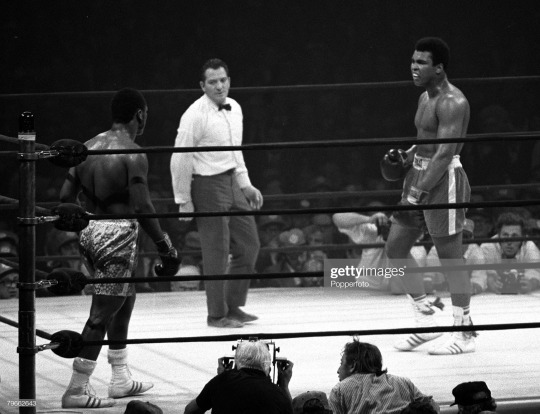
In the opening four rounds, Ali threw so many punches, landing alot, but when he did miss throwing over the top of Frazier’s crouching, erratic defensive movements, he was often punished with huge hooks. Ali won 3 of the 4 opening highly competitive rounds but it may have been a case of winning the battle but not the war, as he exerted lots of energy, having to throw so many punches because any time he stopped Frazier was right on him throwing hard shots to the head and the body.
In the 5th round, Frazier attempted to psyche out Ali. He was smiling, almost laughing whilst Ali missed him with shots, as Frazier ducked and moved his head out of the way. Then when Ali found his target, Frazier didn’t seem to care, he then began talking to Ali in between taking fistful’s of punches. This really showed just how fired up Joe was, it was quite a sight to see the master of in ring psychology Ali forced to taste his own medicine off Frazier.

In a couple of the middle rounds, Ali spent half the round trying to rest and recover some energy, as Frazier continued to pound him against the ropes, targeting his hips knowing it would harm his ability to move later. Ali also tried a few of his tricks to put Joe off such as hitting him with flurries of light pitter, patter punches and resting his fist in Joe’s face as he moved forward but these tricks did nothing to stop the relentlessly aggressive Joe Frazier.
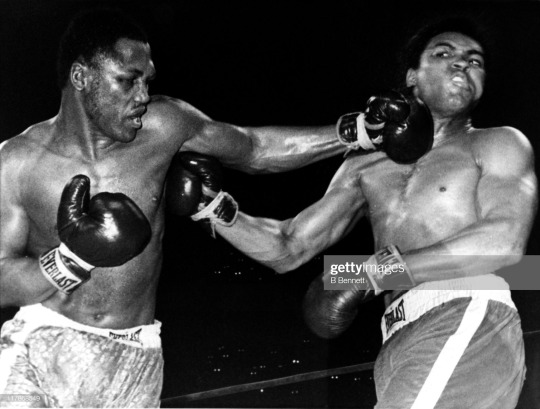
In the 11th round Frazier gave Ali a real battering, after a brutal left hook Ali was wobbling and stumbling all around the ring playing possum and Frazier appeared to buy it as he did not go all out for the finish. The rest of the world though, all the uninvolved participants in the fight, were not as fooled as Frazier seemingly was, it was clear Ali was in trouble at this point, it was the most one-sided round of the fight.
Ali showed enormous resolve to come back in the final rounds of the fight and regain a foothold in the fight. In the 12th though he was hit with a punch that seemed to almost knock his head clean off his shoulders, his head was forced way back but Ali just took it.
In the final round he was hit flush on the jaw with a punch he wasn’t able to take, and Ali was down. He was quickly up and Frazier didn’t have enough left in the tank to seriously come close to putting him down again or stopping Ali. The last 30 seconds both fighters were so worn out they held each other in a clinch for most of it, neither man with enough strength left to do any more. The fight went the championship distance and was a 15-round war which somehow lived up to and even surpassed it’s billing of ‘The Fight of The Century’.
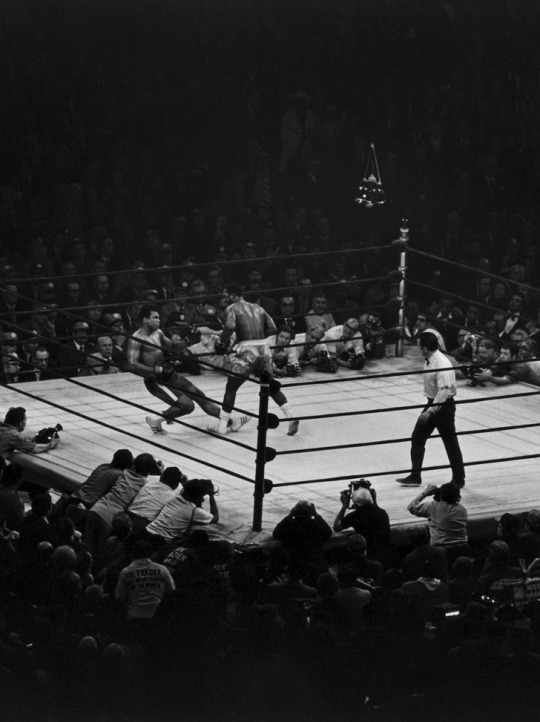
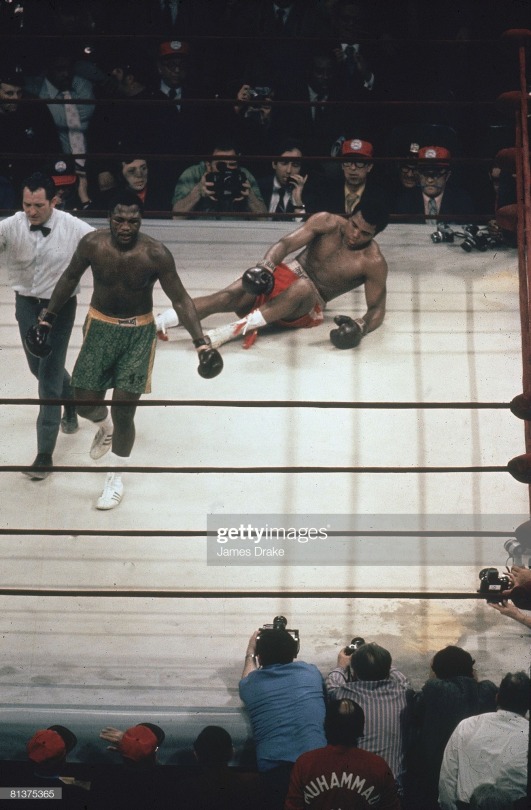
“Frazier hit him flush on the jaw with the hardest left hook he’d ever thrown. Ali went down, and it looked like he was out cold. I didn’t think he could possibly get up. And not only did he get up, he was up almost as fast he went down. Not only could he take a punch, that night he was the most courageous puncher that I’d ever seen. He was going to get up if he was dead. If Frazier had killed him, he’d have gotten up.” -Ferdie Pacheco on Frazier knocking down Ali, Round 15.

Ali showed tremendous will to get up from the punch that put him down, especially after already fighting for 14 absolutely gruelling rounds but in the end, the outcome was the same as Ali couldn’t prevent Frazier retaining the belt via unanimous decision.
22 of the 25 judging sport writers also gave the fight to Frazier but I think this fight was a lot closer than it is historically acknowledged as being and also than it was acknowledged at the time.
The referee scored 8 rounds for Frazier, 6 rounds for Ali and 1 even which highlights how close this fight really was. However one judge scored just four rounds for Ali which I find kind of ridiculous, as I personally had Ali winning 4 of the first 5 rounds. Though that said, then and now you will see many fights which look to be clearly close, but then one judge has it massively in favour of one of the fighters.
Alot of the rounds had to be considered close and it depends on what the judges and referee were looking for. Ali surely landed more punches in most of the rounds, but Frazier landed the bigger, more eye catching power punches. He was the aggressor taking the fight to Ali coming forward and it was Ali always initiating the clinches which may have gone against him. The fight was certainly in a style which benefited Frazier which could be put down to Frazier forcing Ali to fight his kind of fight, but in truth from the very start of the 1st round Ali seemed perfectly happy to fight that style of fight anyway. Also worth acknowledging is how Frazier seemed to finish every round strong, coming on at the end of the round which could have influenced how judges scored the particular close rounds, whereas Ali would often do his best work in the first half of the round.
It could hardly be claimed Ali’s punches had no effect on Joe, they rearranged his features, both his eyes were puffed up real bad. Both men fought a tremendous fight, showing incredible fitness to take such punishment and fight 15 rounds at such a pace.
Ali who always found an extra gear when it seemed both him and his opponent were blowing out, again did so here after taking a battering in the 11th but for the first time in his career, he was matched all the way through the fight, Frazier never fading away or tiring, so Ali was unable to press home his usual fitness advantage in the championship rounds. In the middle rounds when he went to the ropes he was likely hoping Frazier would punch himself out abit, giving Ali the chance to come on strong but Frazier never ever looked likely to give Ali that opportunity.
Frazier overall deserved to win the fight for the way he kept coming at Ali and never once got disheartened at the amount he was getting hit off Ali. He was willing to accept being hit 3 times off Ali if it meant he could hit him back once. He wanted to punish Ali for the things he’d said about him and he clearly didn’t care about what punishment he’d have to take back in order to dish it out.
The 11th round and the big knockdown punch in the 15th were for me enough to sway it in favour of Smokin’ Joe. Frazier was apparently so pissed off with Ali and therefore so determined to beat him, he would have been willing to die in the ring to get the win over his foe. Looking at the fight, that doesn’t seem farfetched to say, Frazier took so much punishment but he never altered from his gameplan, and in the end this faith in himself paid off in the ultimate way with a magnificent performance and victory over the great Muhammad Ali.
“Ali and Joe did a lot of damage to each other that night. In a way it was horrible watching their features change. But it was history in the making, an incredible fight. It was the last round I remember best. That round showed me Ali was the most valiant fighter I’ve ever seen. Frazier hit him as hard as a man can be hit. Ali was exhausted. He went down and he was up in 3 seconds. I didn’t ask if he wanted to continue, because if he’s any kind of fighter atall he’ll say yes. Ali wasn’t just any kind of fighter he was possibly the greatest and most courageous fighter who ever lived. In fact he fought better in that round after the knockdown than before it. Refereeing the fight meant a lot to me. I knew I had taken part in a very important historical event. At the time I was doing public relations work for a beer company. That was my regular job and the following morning I was at my desk at 8AM as usual.”
-Arthur Mercante, referee of The Fight of The Century.
“If Ali lost it was like everything I believed in was wrong. It’s very difficult to imagine being young and black in the sixties and not gravitating toward Ali. He seemed to think less of what the establishment thought of him than about the image he saw when he looked in the mirror. And to people who were young and black and interested in tweaking the establishment, and in some cases shoving it up the tail of the establishment, you had to identify with somebody like that. The fact that he won all the time made it better. For all our passion in those years, we didn’t have a lot of victories. More often than not we was on the losing side so the fact Ali won was... he was a heroic figure plain and simple. So what you had that night were two undefeated heavyweight champions. One guy was dead set against the war, the other didn’t seem to have much of a feeling about it, but was supported by those who backed the war. It’s hard to explain today how dominant Vietnam was in a young guy’s life then. Ali was somebody to hold onto, he was ours. And fairly or unfairly, because he was opposing Ali, Frazier became the symbol of our oppressors. When Ali lost, I was devastated. I felt as though everything I stood for had been beaten down and trampled. We’d seen the people with flags and hard hats beating up kids with long hair who were protesting Vietnam, now was our chance to get even in the ring. Which ever side won that fight was right, and there was no middle ground. It was a terrible night. It was worse than Nixon’s reelection mandate the following year as Ali losing was much more personal because we had the feeling on the political side that we were in the minority anyway. We knew we’d lose going in, we had the world figured out but the majority didn’t see it our way. That’s why Ali-Frazier was so important, it was a level playing field. One against one, man against man.”
-Bryant Gumbel, Sportscaster and Ali fan on the cultural significance of Ali v Frazier.
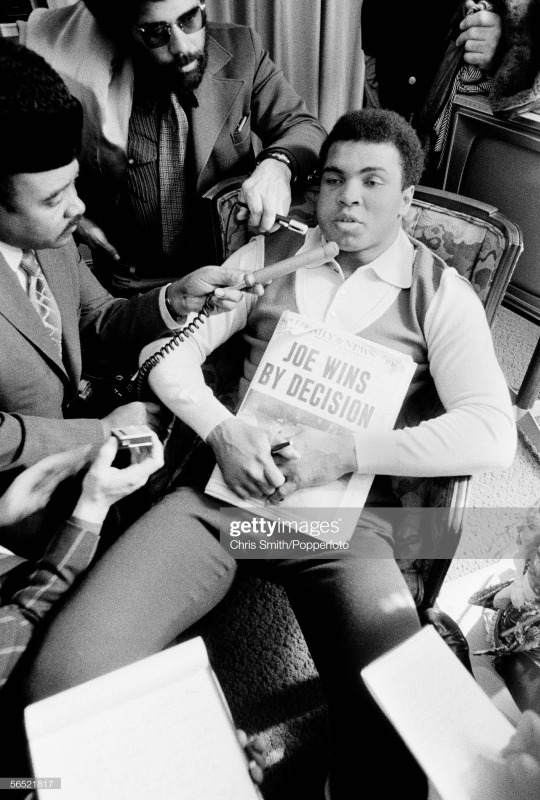
In the immediate aftermath Ali handled his first defeat with real grace: “Just lost a fight, that’s all. Probably be a better man for it. The world goes on. You’ll all be writing about something else soon. I had my day. You lose, you don’t shoot yourself.” When told however that Joe had said he thought Ali doesn’t want to fight him again, the warrior immediately came back out as Ali replied: “Oh, how wrong he is.” A potential rematch may have been a bit pointless though in one boxing writer’s eyes as he wrote: “If they fought a dozen times, Frazier would whup Ali a dozen times, and it would get easier along the way.”
“Of all the names joined forever in the annals of boxing—from Dempsey-Tunney to Louis-Schmeling, from Zale-Graziano to Leonard-Hearns—none are more fiercely bound by a hyphen than Ali-Frazier. Not Palmer-Nicklaus in golf nor Borg-McEnroe in tennis, as ardently competitive as these rivalries were, conjure up anything remotely close to the epic theatre of Ali-Frazier.”
-William Nack, journalist.
The Ali v Frazier rivalry was the greatest boxing rivalry ever and in all likelihood the best sporting rivalry ever too. It produced the greatest fight trilogy ever. It had everything: hatred, heart, skill, respect, dignity, envy. It was absolutely compelling, with both fighters having won atleast one of the fights and the final fight being the decider.
The Ali-Frazier rivalry ofcourse was never solely confined to the ring so when the fights ended and even when their careers had ended, sadly the rivalry did not stop there. The rivalry started from Ali’s portrayal of Joe as the white people’s champion and an Uncle Tom, a narrative which alot of Ali fans bought. Frazier saw it as a betrayal after his support for Ali during his exile and it was a betrayal he struggled to ever really get over.
Ali-Frazier 2 added to it notably with the infamous brawl on Howard Cosell’s set and then finally the Thrilla in Manila it reached its nastiest point yet with Ali mercilessly mocking Frazier’s speech for its lack of education. Ali always maintained at the time that he made such comments to generate publicity for a fight and to make his opponent angry.
Frazier is right to point out that Ali-Frazier fights hardly needed much publicising, but Ali has done this for all his fights including the one with Foreman. He has pointed out that it’s difficult for him to prepare for a fight without atleast building up some ‘pretend’ hatred for his opponent, or enough real hatred to get him through the fight. Ali reserved his worst pre-fight insults for Joe, and it was likely because he knew it got to Joe more than any of his other opponents.
No matter how personal or nasty, ‘trash-talking’ is seen as an acceptable and almost necessary part of hyping a fight and when the fight is over it’s usually all water under the bridge and forgotten about. But in this rivalry this sadly didn’t happen. Though the words used did undoubtedly add something to the rivalry along with the punches. Ali always had that something special inside him to dig deeper than anyone else, but I think Frazier got an extra few percent out of himself when fighting Ali that he couldn’t get against anyone else because of the hatred he felt for the man and because of his desperation to hurt him. So the war of words didn’t just build hype they also added to the quality of the fights by making Frazier even better.
That said, I think it’s fair to say Ali was wrong to call Frazier an Uncle Tom and to attempt to paint him so unfairly as something he most definitely wasn’t. Some degree of trash talking was always going to happen but with Frazier Ali did it in a way that hurt him so deeply that he responded in a way which was also so sad and wrong.
Many years later Frazier would publicly mock Ali for his Parkinson’s disease and say a few very ugly unpleasant things about him on more than one occasion. It should maybe be taken into account that at the time of saying these things Frazier was in a bad financial situation living in a one-room place above his gym having lost all his money earnt from fighting through failed business ventures and his own generosity. He also had a few not unserious health issues of his own. This no doubt impacted greatly on Frazier’s already existing bitterness toward Ali. He would have felt forgotten about whilst the world cherished Ali more than ever. In his final years of life he repeatedly said he no longer held any ill will towards Ali. Frazier died in 2011 with Ali attending his funeral and saying: “The world has lost a great champion. I will always remember Joe with respect and admiration."
In 1978, 3 years after the Thrilla in Manila, Joe Frazier appeared on Muhammad Ali’s edition of the British TV show ‘This Is Your Life.’ At the time both men were retired though Ali was to make an ill-fated comeback. Ali’s shock and delight at Frazier coming all that way to appear on a show dedicated to him was obvious and it was a great moment to see the two shaking hands, laughing and hugging.
sources: Muhammad Ali His Life and Times by Thomas Hauser, thefightcity.com, ringtv.com, boxrec.com, Wikipedia,The Modern Martial Artist.
#boxing#sport#sports#fighting#ali#muhammadali#cassiusclay#thegreatest#goat#joefrazier#georgeforeman#combatsport#heavyweights#heavyweightboxing
2 notes
·
View notes
Note
My fave Magnus crackship has been Magnus/Maia for a while, so if your up for it I'll love to read something for them ^^

Maia and Magnus could easily be best friends turned lovers because she’s tough and capable and honestly a better alpha than Luke and in another universe she is the Alpha and she and Magnus lead the warlocks and werewolves in some of the sickest downworld parties ever. Anyway, here’s Maia/Magnus:
“It’s not about being faster,” Magnus says, grinning. “It’s about the shortest distance between A and B.”
“I’m going to rip your pretty face off if you don’t shut up and just show me.”
“I’m pretty?” Magnus says, brightly.
“Ugh.”
They’re in wolf-run gymnasium about ten blocks from Magnus’ apartment building and it’s six in the fucking morning. So Maia is already on the ragged edge of cranky and hole-ridden boxing canvas beneath her sneakers smells like decades of old blood and sweat. It’s putting a heat in her, the scent of old fights, and Magnus smells faintly of sweat himself and she’s a little embarrassed to say she likes it. He smells good.
It’s surprising how many people don’t smell good actually.
“You’re a boxer,” Magnus is saying “You were taught to box and when you’re not doing that, you’re ground game is comprised mostly of mauling. Which is fair. Mauling is a good technique when you go down, but it won’t necessarily help if you’re fighting a shadowhunter or a vampire.”
“I’m stronger than a vampire,” she says, baring her teeth.
“But a vampire is faster than a werewolf,” says Magnus. “And a nephlim with a rune is almost as fast as a vampire and almost as strong as a werewolf. They win in the middle. If you’re fighting a shadowhunter, you’ll be a little stronger but they’ll be faster. So you need better technique.”
“All they do is learn to fight. They’re a bunch of military freaks.”
“Yes. And it tends to make them predicable. That’s why we’re learning this.”
Maia tends to notice people in scent profiles. Magnus is a warlock so he smells like his magic, which shouldn’t have a smell but it does, like people tend to smell like what they eat, Magnus tends to smell like heat, like cooling metal. When he does magic, he smells like fire, like liquid nickel, like a fucking forge. Right now though, he just smells like himself – skin and the lye in a ‘scentless’ soap. He tends to take off his cologne around her, around all werewolves actually. He doesn’t wear anything scented to the Jade Wolf. Thoughtful-like.
“Show me again.” She takes a boxing stance.
He mirrors her, taking a light angled position, his own fists raised.
“Okay, you do this.” He slowly winds up and lightly throws a slow motion right-fist jab to her jaw. His knuckles tap her chin. “Full-speed. This.” He throws the punch at normal speed, but Maia doesn’t flinch and his fist stops a breath from her jawline, a whisper of displaced air like a kiss to the skin. He smiles. “You saw it coming though. Right?”
“Sure. I –“
She feels the air at her lips hiss suddenly and flinches back, but his hand is already resting against her chin. He smiles.
“Motherfucker.” She squares up to him again, presenting her jaw. “Do it again.”
He does it again. His knuckles kiss her chin.
“Again.”
He does it again.
“It’s just a straight punch,” she complains.
“Sure. But you telegraph and I don’t.” Magnus shrugs. “I promise you. Learn a good straight punch, a truly good straight punch, and the rest of it will fall into place. Just do this one thing.”
Maia folds her arms. “Knocked out some nephilim in your time, Bane?”
He smiles, viciously, and lets his eyes show gold. Then it’s gone. “Maybe,” he says.
Maia takes up a boxer’s stance again and Magnus takes up a defense, two palms open to deflect her blows. He looks so normal in the gym overheads, still unnervingly pretty, jawline to cut yourself on, wearing guyliner at a six AM workout like a madman, but otherwise normal. Just this normal seeming Asian guy in a sleeveless hoodie and black joggers. Maia wonders what he looks like in a fight. She’s never seen him in a real fight.
“Okay,” she breathes.
She throws a punch at his face and he swats it away. She does it again and he swats it away. Again. Swat. Again. Swat. She steps left, swings, he circles to his left and still swats it away. She grins and keeps trying. Keeps trying, Magnus patiently juking and ducking her shots, saying things like:
“From the elbow. Just forward. Forward. Don’t open like that.” He taps her breast bone suddenly with two jabbing fingers. A dull point of pressure that sends a pulse of heat through her chest straight down her belly to a sudden tightness far lower than that. “Don’t open up,” he says, oblivious. “Just go from here.” He shows her his arm at the ready. “To here.” He straightens his arm. See?”
She jabs and this time Magnus has to jerk back, her fist brushing his collarbone.
“There you go,” he laughs. “Do it again. Just –”
She snaps forward, straight forward, grabs the collar of his hoodie and jerks Magnus toward her, her hand hooking the nape of his neck and yanking him into her. His mouth tastes a little like the sweat on his upper lip and faintly bitter, caught open in a surprised breath, but she doesn’t push it. Just fits her mouth, smiling, against his. Kisses him like a question and when she feels him kind of smile back, like braille read off the touching of lips, she opens her mouth against his.
He laughs a little, kissing her like he’s just very pleasantly surprised at where their gym session is going, but his voice is rough with something, rawer than usual and she kind of likes that. She pulls on his neck with one hand, pushes against his chest with the other. She backs him into the ropes, presses her body flush to his and feel him shiver. She likes that too, like how he nips a little at her lower lip, then kisses that place particularly.
“Did you see that one coming?” she whispers, when they finally stop to catch their breath. “Was I telegraphing?”
He kind of huffs, eyebrows rising and falling. “Oh no,” he says, “I… kind of didn’t see that one coming.”
And she kisses him again.
#shadowhunters fic#shadowhunters#magnus bane#maia roberts#crackship sh#MAIA AND MAGNUS C#COULD FUCK IT UP#rae writes#raewrites
14 notes
·
View notes
Text
Ich Heb Ab
Von Kaiser takes a moment to reflect in the midst of a tense situation.
This can also be read on Archive of Our Own
The train-ride over to the park had been quiet. That wasn't too abnormal, but every now and again you'd hear people chatting, or someone chuckling, or a child, or a fully-grown man fall asleep and begin snoring.
No, today's 'quiet' had just been somber silence.
Von Kaiser believed this to be both respectable and far too out-of-the-ordinary for his comfort. The reason he had decided to leave for the park in the first place was the hope that he would be able to relax and forget the worries he harboured, but it seemed they followed him wherever he went... Or perhaps that was too self-centered a thought. It wasn't that the worry followed him, it was that the whole of Germany (and many other nations) were encapsulated by it.
Kaiser could brood for hours on the train-ride alone, and it seemed as if his mind truly wanted to focus on that for as long as possible-- It was a better problem to think about than the one that caused it. It felt a bit awkward for the boxer to sit-back on his bench and tell himself, mentally, to get rid of those thoughts.
He tried, and tried again.
It wasn't working, so, he told himself out-loud this time.
That wasn't working, either.
Frustration bubbled-up in the man's chest, and that on-top of anxiety was a destructive combo.
Nothing was in his control. Something had gone wrong, and now everything followed. He couldn't even help himself, how would he fix anything else? What could he do to fix the problem in--
"Tag, Viktor."
The thoughts were dispelled immediately at the sound of a voice. It was an older gentleman, clad in only his trousers. He must have been sunbathing, noted Kaiser, which was not uncommon for many people, let alone this man in particular. "Guten Morgen, Herr Becker. Das Wetter ist Sonnig, ja?" Kaiser knew him since he was sixteen-- from the bakery that the boxer frequented. Now the old man was retired, but certainly no less present in his life.
This familiarity made it easy to start a conversation, though it was dull and dry as ever. Neither man seemed to have a problem with this.
They spoke back-and-forth for a while, and Von Kaiser had only realized how long that 'while' had been once the talking lulled and Mr. Becker brought-up the topic that had been at the forefront of Kaiser's mind since he'd awoken that morning. He wasn't much one for talking, but now he wished Mr. Becker would go back to prattling-on about playing frisbee with his friends in the Englischer Garten.
Kaiser listened, tense and silent as Mr. Becker continued-on about how much of a travesty it was, and how sad his family is, and how uneasy he is.
Easy-enough for him to say. He didn't have anyone he cared about near the travesty.
As if reading Kaiser's mind, the elderly man quieted-down, dim eyes analyzing the other's stance. "Du bist steif. Wie geht es deinem Freund?"
"Ich habe keine Ahnung, Herr Becker." "Ah... es tut mir Leid."
After that, another bout of silence. It was not helping. Mr. Becker appeared to be quite observant today, however, as he soon gave a small 'Tschuss' to Von Kaiser and left to leave the park for the day.
So once again, the Berliner was left to his thoughts. The harshness and self-deprecation within them had not left during that momentary distraction. They just resumed as if nothing happened.
'You are anxious and nervous, Kaiser. Men should not let stress get to them. It is pathetic.'
Pathetic? Was he pathetic? That could very-well be the case. He's been through so much, and yet, a man who's only talent is dancing had surpassed him within the WVBA. He's experienced so many things, and yet, a mere child who loads horseshoes into his boxing gloves is two circuits before him.
Sure, he could fight those two. The chances of winning weren't completely inconceivable, and yet, his rank and record pleaded otherwise.
The only person people would expect him to be able to beat is a malnourished, old French boxer.
...
Pathetic? Perhaps.
But what good is living if your only choices are that and apathetic?
"Ein Mann sein, verdammt sein. Verdammt sein." He muttered, allowing himself to finally sit-back against the wood bench. His head lowered, eyes staring at his rough, worn hands. Below them were dandelions, new and bright. And even below them was green and brown grass, and even further below was dirt, chock-full of more life than people could imagine.
Von Kaiser bent forwards, a finger and a thumb plucking a once-living dandelion from it's stem. He turned-over the pesky plant in his fingers, examining it though his thoughts were elsewhere.
It was far too easy for someone to take a life, he mused.
Before he could mull on that thought process for long, though, a quick vibration came from his hip. Dropping the dandelion to the ground, Kaiser straightened-out, patting either pocket to locate his phone before doing so and pulling it out. His brows had furrowed, and they furrowed deeper while he was reading the new message on the screen.
'[yes we are fine please do not worry. thank you for your voicemail im sorry i could not pick up. call me later please.]'
The message was brief and simple, but it gave Kaiser an immeasurable amount of relief. His stomach relaxed, and his shoulders lightened. He hadn't even realized how rigid his posture was or how tense he'd been. Considering his usual stance, that was saying something.
Kaiser melted back onto the bench, allowing himself the rest this one time. The phone was placed on his thigh, two hands reaching upwards to run their fingers through his hair. A hand remained over half of his face, as he looked up to the sky.
'We are fine'. Good, good. But what of the people who aren't? What of the people who did such a heinous thing? What of people in general?
How could 'fine' exist in a world where hate was so common?
Every year, something new. Another attack, another corrupt leader, another questionable law.
We've grown as a species. Yes, that can't be denied, but we still have far too much to fix.
Kaiser's hand ran it's fingers through his hair once again, before finally falling to his lap alongside the other. His chin remained up, however. Eyes were trained on the fluttering leaves of a tree mere metres away. His mind momentarily left him as he allowed himself a moment to watch the uncaring, peaceful display.
If such a thing can exist, how can it exist alongside us? Murderous, malicious beings. We were never meant to be here. The universe would neverintend for something as beautiful as nature to become tarnished by creatures that gained too much free will.
In the back of his mind, Von Kaiser remembered a certain field in France. It was now so dented and scarred that the once-flat ground had become permanently uneven.
But grass grew on that field, now. The mistakes from nearly a century ago had, in the end, provided life. The field's past was never forgotten, but the grass grew without care. The sheep grazed without a second thought. Life went on.
"Hm..." He hummed to himself, successfully breaking-out of his deep thought. While he'd been brooding, he'd leaned forward on the edge of the bench and had begun to examine that pulled dandelion once more. "C'est la vie..." He commented, bitterly. Kaiser wasn't sure who he was speaking to, either. Was it the dandelion, who would wither away and die? Or was it himself?
"C'est la vie." A corner of his moustache turned-up, and he gave a facetious chuckle before dropping the plant and placing both of his hands firmly on his knees, pushing himself off of the bench. Looking at the sky, he'd realized he'd been out here brooding for quite some time.
When had he gotten to the park? Around eighteen after twelve, and now it was nearly halfway to four. Dinner was always at five, and he still needed to buy groceries. He should be leaving now.
Just as he took a step, another vibration came from his pocket. Kaiser paused and grabbed-up the phone he'd replaced only a moment ago, squinting at the screen (the sun always made it so dark!) to find that a certain boxer had posted to a social media account. Upon further investigation, Von Kaiser found it was a bunch of well-wishes, thank-you's and 'be safe's. All of the other boxers were showing support in some shape or form. Even the horseshoe-toting child had changed his profile picture so it had the special 'filter' over it.
... Hm. Well, Kaiser supposed that was as good a show of support as anything. It wasn't like many people could do much else, at the moment.
The phone was pocketed again, and the boxer began the quiet walk back to the station. The train would be arriving soon.
There would be people on the train.
The bread at the bakery would still be fresh.
The tree's leaves would be rustling. The grass would grow in the fields, and the dandelion would regrow.
Von Kaiser sighed, and a small smile settled onto his face.
Life went on. C'est la vie.
5 notes
·
View notes
Text
Kwentong Barbero
It was too hot.
Yes, I know that every day has been uncomfortably so. But it’s definitely worse today. I tug at the mess I call my hair, slick with sweat, and decide to hijack every electric fan at the house.
By the time I had two electric fans, one in each hand, my mom calls my attention - she had a newspaper and a steaming cup of coffee in hers - and tells me to go head to the barbershop before it becomes too hot outside.
I check the clock: 12:02 pm. The sun has long pounded on the hard concrete, basically transforming them into burning charcoal. It wasn’t a pretty prospect.
But not unlike elementary school where the regulation haircut is part and parcel of the code of conduct, keeping one’s locks in check remains a prime directive. It is for that reason that I found myself pedaling my old, beat-up bike towards the nearby subdivision at 12 o clock in the afternoon.
Haircuts, Manny Pacquiao and Rocky Balboa
After 15 minutes of biking underneath the now-cancerous rays of the sun, I arrived at Roland’s barbershop. Set between a butcher’s shop and a burger joint, Roland’s has been my go-to for haircuts for almost a decade.
His shop looked nothing out of the ordinary for a barbershop: two barber’s chairs, a long, rectangular mirror and a desk containing enough scissors and blades to make Freddy Krueger giggle with delight. Lest I forget, there are the standard FHM posters and calendars plastered on walls featuring scantily clad women that everyone in the shop take turns looking at like an unspoken contract.
As I lay down my bike in front of the dingy shop, Roland calls me in and bids me to sit on one of the open chairs. It was a slow day, as the middle of the month isn’t peak season for barbers. I settled into my fugue state reserved for haircuts, boring class lectures and listening to Mike Enriquez over the radio at ten in the morning.
“Alam mo p’re, napanuod ko kanina yung Rocky. Ang lupit,” said one of the regulars, engrossed in a chess match with one of the other barbershop tambays. He was playing the white pieces, and his king was currently exposed with only a couple of pawns to keep it company. The end was nigh for thy royalty - probably what triggered this sudden verbal expression.
“Ayos diba? Idol ko yun. Lupit ng katawan ni Sylvester Stallone dun. Batak, parang si Pacquiao,” said Roland.
“Sino kaya mananalo dun,” said another fellow, smugly taking the white king off of play. “Checkmate, brad. Atsaka feeling ko si Rocky. Mas matangkad yun. Mas mahaba yung abot.”
“Pacquiao pa din. Madami nang nakalaban yun na mas matangkad sakanya, dinadaan lang sa bilis,” said Whitey, named for the chess pieces he played.
This particular debate went on for several more minutes. All the while my head resembling more and more a rather steamy siopao, for the shop only had one electric fan, and it was broken.
“Si Rocky mas mabilis gumalaw, p’re. Mas kaya niyang tumakbo. Puro yun ginawa niya sa pelikula. Hindi tulad ni Pacquiao, puro takbo sa pulitika nalang ang inaatupag,” said Roland, to everyone’s laughter.
As the last few snips chopped off what remained of my uneven hair, Whitey and Blacky chimed in on why Pacquiao have not won any of his recent matches: him losing himself completely in Duterte’s politics, his convoluted stances on religion and LGBT rights, and his race to build political capital.
In this manner, Pacquiao can learn a lot from what happened with Rocky. The first Rocky movie was good - it was an inspiring story of a boxer fighting for the underdog with his own sweat and blood. It stands today as one of the greatest boxing movies in history.
But the rest? The five sequels that had the misfortune of being produced? Utter crap. Convoluted plots, poorly written characters, ridiculous dialogue served as the perfect recipe to ruin a perfectly good movie.
From hometown hero to hated politician, the parallel runs deep in Pacquiao’s narrative. He should have learned to take the hint: quit while you’re ahead.
*cue in Gotta Fly Now*
Shaving, Duterte and Marawi
With my hair all butchered, Roland eased my head backwards for the shave - the final part of this monthly ritual. He pulled from his cabinet a bottle of shaving cream and a box of blades that put the fear of god in me. See I’ve never been a fan of blades, blood and gore, especially during my high school days when having watched the movies Saw and Final Destination marked your journey into “manhood.”
Snapping out of that particular trip down memory lane, the shop’s old, dusty radio piped up, delivering a news report in that perennial radio voice we’ve all come to hate - most likely one of the numerous Mike Enriquez clones clogging the AM airwaves. The news report was on Marawi and its liberation from the Maute fighters.
“Alam mo, pasalamat talaga kay Duterte patay na yang mga terorista na yan,” exclaimed Roland, with that patriotic fervor you only see in war movies where the good guys kick Nazi butt. “At dun sa drug war, ngayon wala nang drug addict sa subdivision. Buti nalang talaga binoto ko siya.”
I had a dilemma on my hands. On one hand, there were some corrections to be made about Duterte’s so-called “success” in Marawi. On the other, Roland had something extremely sharp gliding across my neck. I was - quite literally - on a razor’s edge.
As my budding double chin quivered in fear and indecision, I blurted out: “Paano po ang mga taga-Marawi? Yung mga binomba ang tirahan at nadamay sa crossfire na tinatawag nating collateral damage?”
The silence was deafening. I felt blood on my throat as Roland’s razor slipped. It was a small scratch, but it was all I needed.
“Hindi po mesiyas si Duterte.”
Marawi is in such a state of destruction that who knows when they’ll ever get some semblance of normalcy. Yolanda happened years ago, and yet things are still far from normal, why would Marawi be any different? Years in the future we’ll most likely see the same stories, the same news reports: backlogs in delivering relief aid, corruption in the selection of private contractors.
History repeats itself, nothing is ever new.
This self-inflicted catastrophe brought by gunfire and fusilade, through constant bombing operations over civilian spaces has left nothing but destruction. I see no victory here.
“Hindi po mesiyas si Duterte”
Thousands lay six feet under following Duterte’s massive war against drugs - his words - with the drug cartels still in force. Three months turned into six. It’s well over a year, and despite several high-profile deaths and cases of abuse by our national police, there remains no justice to be gained for all the victims.
Roland stared at the me plastered on the glass panel. There was confusion in his eyes, but somehow also measured understanding. He flashed that smug grin, and did something that caught me by surprise: he laughed.
“Ang laki mo na, Allan. Hindi ka na yung dating pumipikit kapag ginugupitan. Inom nga tayo minsan tapos dun natin ‘to pagusapan,” Roland said, brushing off the hair from my neck. “Yan okay na. Wala ka namang bigote o balbas eh.”
I handed him P70 for the haircut and the shave. He waved it away. “Sa susunod na. Ikaw na bahala sa pulutan,” he said. I said thank you and waved goodbye, picking up my bike from the pavement
It was still too hot.
But it wasn’t because of my hair. It was because for the first time after starting to work at corporate, I felt alive. Who knew that Roland’s would be a one-stop shop for all my existential crisis needs?
I pedal away.
2 notes
·
View notes
Text
Assassin’s Creed: Chapter 4
I was almost nervous... but I listened what he had to say... “Check it out and call me back...” his voice echoed in my head. I went to my laptop on my desk and went to the website he told me about... “B... w... n... video...” I mouthed as I typed the address. A disclaimer to enter the site came up across a very dark background with an animated, muscular black guy wearing speedos on the right-hand side. “I’m kinda like the face of the business...” his voice echoed. The cartoon man did look a lot like him... I wasn’t 21, but I sure as hell didn’t care. I clicked ‘Enter.’ My page was covered with muscular, sweaty, and quite good looking black men all wearing either spandex, speedos, or shorts fighting in what looked like an isolated room... more likely someone’s basement. “I wrestle...,” his voice echoed, “Though it’s not the normal type of wrestling you see on tv. There are two sides to it; the pure wrestling side and the more erotic side. I’m just there for the wrestling. And if you don’t believe me, go see for yourself...” I scrolled down the page to the username and password box. I looked over at the sheet of paper next to me and keyed in the username and password he gave me. From there, I had full access to ALL of the videos on the site. Though I was only interested in seeing his... There was one video in particular that caught my attention. A video where he was fighting a well-known pornstar named “Juice”: famously known for his PERFECT physique, but was a 2 in the face. Everything on him was swole including every part of his face. I jerked off to his video quite a few times, but I was intrigued to see what Jax would do against him... I pressed play. Juice entered the scene in a pair of speedos and so did Jax. Juice definitely brought a mood of “sexy” to the scene, but Jax was definitely not there to be turned on... About 20 minutes into the video, Jax had Juice balled up into a pretzel and was cracking jokes. “All that muscle and you can’t fight?” Jax laughed, “You should definitely stick to porn and not the ring.” By the end of the video, Juice was unconscious (or at least pretended to be). I wasn’t in the least bit aroused through the whole thing... In fact... I was QUITE entertained. I watched a few more videos before giving Jax a call back. “So...?” he asked. “I watched the videos. I can’t believe you did Juice like that lol...” I laughed. “Hahaha, yea... so you aren’t turned away by it?” he asked. “Not at all.” I answered, “Though the only thing I wonder is... do you ever have sex after the matches...?” “Nah,” Jax said, “It’s not even that type of party.” However, I didn’t quite believe him... However we continued chatting through February of 2008 until one night... I signed onto Yahoo! Messenger to see Jax online. “Hi!” I sent to him. I was unfortunately very horny... :’( “Hey sexy!” he said. I pressed the button to invite him to view my webcam. “Oh?” he typed. Once the viewing began, I stood up and took off my shirt. He sent a shocked face. I dropped my shorts and revealed my tight, fitting boxer trunks, turned to the side to reveal my side profile and showed the curvature of my ass that was a perfect mix of muscle and booty fat. I used one finger to pull down my underwear half way. “Stop.” he typed, “I’m coming to Orangeburg right now.” “Lol... it’s almost 9pm, Jax.” I responded. “And I’ll see you at 10pm and I’ll get a room when I get there.” he logged off. O_o... I guess it was time to put my money where my mouth was. I went to the communal showers and got fresh and clean only to return to find my roommate had arrived from band practice. He had just put his instrument case under the bed, but he looked at me and smiled... “Most people take showers before they go to bed...” he said, “But you... you don’t sleep...” I laughed: as this was our usual joke. We indeed had a curfew and would receive a fine if we got caught staying out... but anyone with a brain would know that you don’t return in the middle of the night, you won’t get caught. My roommate, Sam, was well aware that I broke that rule quite often, but I’d only tell him I was going “into the night...” “Yep, I don’t sleep,” I said, “And I probably won’t be getting much to night if I tried.” He laughed at me. I walked down stairs at quarter till and dialed Jax’s number. “Yo!” his voice picked up. “I didn’t ask but... do you know where you’re going?” I asked. “Come across the street...” he said. I held the phone down from my ear and looked across the street to the far left to see a beat-up, light-blue, Honda Civic parked with the lights on. I hung up and walked across the street to the passenger side and entered the car. “Hello.” I smiled. “Hello to you...” he returned. “I’m Black!” I reached out my hand to shake. “Negro please, come here!” he reached over and gave me a large hug. He smelled of alcohol. I put on the seat belt. “You been drinking?” I asked. “Just a little...” he replied. “To only have drank a little, you smell like a lot...” I shaded, “How many more seat belts am I going to need?” “That depends on how long you can hold onto me without letting go...” he joked. We pulled up to a Motel 8 and went inside. “I do need to take a shower...” Jax said. “Yea, it will help get the alcohol off...” I laughed. He pushed me playfully with one arm and I landed onto the bed. He disappeared into the bathroom. He was definitely more attractive in person... though there was one thing I wanted to do... I took off my jeans and shirt and left my underwear on. When the shower water stopped, he exited the bathroom wearing a pair of boxers. I stood up with a grappling stance. “What the hell?” he laughed. “I wanted to wrestle!” I smiled. He lunged towards me, grabbed me by the waist, lifted me above his head, and threw me across the room onto the bed. I bounced almost halfway to the ceiling. “NO MORE!” I shouted. We both nearly died laughing. I wiped my laughing tears from my eyes and realized he was over me. He grabbed my neck and pulled me in to kiss. He definitely washed off the alcohol pretty well. I backed up towards the pillows, but he kept his body locked onto mind and followed with his hands around my waist. He pulled down my underwear and nearly devoured my dick. My eyes rolled back much further than my back arched. I was in disbelief at how solid every part of his body was. Arms, thighs, chest; everything was nearly hard to the touch. He opened my legs and slid between them. His boxers had somehow vanished revealing an 8 inch dick that was quite thick... but not as large as mine. In his hand he held a condom. His other hand disappeared under me and his fingers tickled my hole with lube. He was indeed a magician. He slid the magnum on his dick and pulled my waist towards him. I grabbed the bed uncomfortably as he leaned over me again with dick pressing against my hole gently. He kissed me again as he gradually pushed a little harder. He was at the “WAIT!” moment... that moment where there’s a temporary pain of being penetrated before any of the pleasure... my mouth wanted to say “Wait...” but my body told me to keep kissing and take the pain out by squeezing his solid biceps. He slowed for a moment and moved his lips down to my neck. I leaned my head back into the pillows. We were definitely out of the waiting room... He pulled back slightly and pushed again and I released a quick moan. He kept pumping faster and my moans quickened. My dick was fully erect and the more I pumped it, the tighter my ass gripped his dick. His pounding got faster and much harder until he moaned finally and landed his heavy, muscular body on top of me. We fell asleep that way...
5 notes
·
View notes
Text
Lessons learnt from the top sports crises of 2019
Another year, more drama both on and off the field of play.
It seems that the lessons of previous years have not been heeded by those at the top of professional sport.
Sport continues to be one of life’s most high-profile soap operas and it’s inevitable that mistakes will be made, judgements affected and controversies dramatised over the back pages.
This was a year where the lines between sport and politics blurred regularly.
There’s always plenty to learn from the crises that take place and the opportunities for individuals and organisations to observe to avoid similar fates to those affected below.
Racism in football
New ‘Kick It Out’ chairmen Sanjay Bhandari says that discrimination in football may “get worse before it gets better.” And that certainly seems to be the case.
England players were again racially abused in Bulgaria during their Euro 2020 qualifying campaign while Italy striker Mario Balotelli was abused by Verona fans while playing for Brescia.
Perhaps the saddest incident saw Shakhtar Donetsk midfielder Taison sent off after he reacted to racist abuse by fans by gesturing and kicking a ball at Dynamo Kiev fans on November 10.
Rather than Kiev being punished, the Brazilian received a one-game ban from the Ukrainian FA for his reaction.
As if that was not bad enough, Serie A in Italy used images of monkeys in an anti-racism campaign less than three weeks after its clubs pledged to combat Italian football's "serious problem". https://www.bbc.co.uk/sport/football/50814275
There is certainly much to do…
https://www.bbc.co.uk/sport/football/50399048
https://www.bbc.co.uk/sport/football/50212951
https://edition.cnn.com/2019/11/11/football/taison-shakhtar-donetsk-racist-abuse-dynamo-dyiv-spt-intl/index.html
https://edition.cnn.com/2019/11/04/football/balotelli-racist-chants-football-serie-a-intl-spt/index.html
Learning
Until the governing bodies come up with consistent and harsh fines for clubs or players guilty of racist abuse, the issues will continue. Token stadium bans and fines for those who react to the abuse do not send out the message that any form of racism or discrimination is simply unacceptable.
Ulster and Diageo – Paddy hire
We have written and spoken a lot about Paddy Jackson, the former Irish international who was found not guilty of rape but mired in controversy related to his treatment of women. LINK
In June, Diageo, one of the world’s largest producers of spirits and beers, ended their sponsorship of London Irish after Jackson was signed from Perpignan.
“Their (London Irish) recent decision is not consistent with our values and so we have ended our sponsorship,” Diageo said in a statement.
Learnings
The severance brought to an end a partnership that had lasted almost 30 years and underlined how important it is to take account the values you and your partners want to transmit.
Most sports clubs want to be seen as inclusive and family-friendly and so signing a player whose behaviour was misogynistic at best and abhorrent at worst is not going to be seen to fit in with values organisations want to associate with.
https://www.bbc.co.uk/news/uk-northern-ireland-48629949
https://www.independent.co.uk/sport/rugby/rugby-union/paddy-jackson-london-irish-sponsorship-guinness-owners-diageo-les-kiss-declan-kidney-a8958336.html
https://www.thedrinksbusiness.com/2019/06/diageo-ends-london-irish-sponsorship/
Diageo - https://www.diageo.com
Paddy Jackson Twitter - https://twitter.com/paddyjackson10?lang=en
Ulster - https://www.ulsterrugby.com
London Irish - https://www.london-irish.com
https://www.irishexaminer.com/breakingnews/ireland/diageo-pulls-sponsorship-as-london-irish-signs-paddy-jackson-930703.html
El Clasico Spain
El Clasico between Barcelona and Real Madrid is one of the highest-profile derby matches in world football.
The game stirs emotions throughout Spain, with Barcelona using it to assert their claims for independence and Madrid to underline the importance of Spanish nationalism.
With weekly protests by Catalans in Barcelona after nine Catalan separatist leaders were jailed, the authorities decided to move the game after neither club accepted the suggestion to switch the game to Madrid.
https://www.bbc.co.uk/sport/football/50096390
https://www.thesun.co.uk/sport/football/10210698/barcelona-real-madrid-postponed-el-clasico-rescheduled-played/
https://www.businessinsider.com/real-madrid-barcelona-el-clasico-postponed-2019-10?r=US&IR=T
Barcelona FC - https://www.fcbarcelona.com/en/
Real Madrid - https://www.realmadrid.com/en
Learnings
There were multiple stakeholders involved in the decision to change the game including the clubs, La Liga, broadcasters and the RFER (Spanish Football Federation) who ultimately made the decision to move the game from October to December.
A lot of the debate, particularly from La Liga, went on in public rather than behind closed doors, tainting the prestige Spanish football has built up to make it one of the world’s most foremost football competitions.
Where possible, holding discussions behind closed doors until a resolution is reached is better for all stakeholders and their reputations.
MESUT OZIL
Arsenal playmaker Mesut Ozil is no stranger to controversy.
He lashed out at the German Football Federation and media after being criticised for the team’s poor performances, highlighting his experiences as a footballer of Turkish descent and outrage at him being photographed with Turkish President Recep Tayyip Erdogan.
He claimed that he was quitting the national team after being treated with “racism and disrespect” set off political uproar in the country last year.
To add fuel to the fire, President Erdogan was Ozil’s best man when he got married earlier this year.
But that controversy paled into insignificance after posting a tweet criticising Muslims of staying silent over the mistreatment of the Uighur community in China.
“Korans are burned. Mosques are closed. Their schools are banned, but the Muslim community is silent.”
https://twitter.com/MesutOzil1088/status/1205439723302469632
Arsenal immediately distanced themselves from the tweet and underlined their apolitical stance on Weibo, the Chinese social media platform, but that did not stop CCTV, the Chinese state broadcaster, from switching from the Gunners’ match against Manchester City to another match on that Sunday afternoon.
https://www.bloomberg.com/news/articles/2019-12-14/arsenal-takes-nba-approach-by-distancing-from-player-s-china-jab
https://edition.cnn.com/2019/12/16/football/ozil-arsenal-china-football-intl-spt/index.html
https://www.nytimes.com/2019/12/15/world/asia/mesut-ozil-muslims.html
Chinese politicians claim that Ozil had been deceived by fake news and the tweet prompted Chinese fans to burn his shirt, while his social media channels in China have all been shut down.
And as relations between the United States and china cooled, Secretary of State Mike Pompeo said: “China’s Communist Party propaganda outlets can censor @MesutOzil1088 and @Arsenal games all season long, but the truth will prevail. The CCP can’t hide its gross #HumanRights violations perpetrated against Uighurs and other religious faiths from the world.”
https://twitter.com/SecPompeo/status/1206953951653969921
https://www.theguardian.com/world/2019/dec/16/mesut-ozil-row-chinas-arsenal-fans-burn-shirts-in-anger-at-xinjiang-post
Deceived by fake news https://www.bbc.co.uk/sport/football/50807043
https://www.bbc.co.uk/sport/football/50795173 distanced from
Pompeo https://news.sky.com/story/mike-pompeo-backs-arsenals-mesut-ozil-after-criticism-of-chinas-treatment-of-uighurs-11889220
Learnings
Some say sport and politics should never mix, but international boycotts and diplomatic incidents can always spill over into the sporting world.
Ozil has clearly got to the stage of his career, having won the World Cup and numerous other trophies, when he feels it is right to use his profile and platform to highlight issues that matter to him.
There has been speculation that his tweet will have a negative effect on both Arsenal and the Premier League’s commercial partnerships with China in future.
Some may argue that it will damage his global reputation and certainly his earnings from sponsorship deals linked to China will cease, but Ozil knew exactly what he was doing, and with such a huge global platform, decided to take a stand.
AIBA and IOC
AIBA, the International Boxing Association, has gone through troubled times in recent years, following the Executive Committee’s decision to remove President CK Wu, after concerns about finances and management and doubts about judges.
Interim Presidents came and went and eventually the International Olympic Committee (IOC) took away AIBA’s right to run the amateur boxing competition at the upcoming 2020 Tokyo Olympic games.
AIBA now says that the decision could bankrupt the organisation while it attempts to appoint a new permanent President and review its constitution.
https://www.insidethegames.biz/articles/1080855/virgets-admits-aiba-facing-bankruptcy-and-accuses-ioc-of-orchestrating-crisis
https://www.independent.co.uk/sport/olympics/tokyo-2020-olympics-games-boxing-aiba-banned-latest-news-a8975326.html
https://www.insidethegames.biz/articles/1084189/fiacco-resigns-aiba-executive-committee
https://www.aiba.org/blog/aiba-executive-committee-lifts-provisional-suspension-vice-president-mr-franco-falcinelli/
https://www.hindustantimes.com/other-sports/boxing-body-aiba-to-discover-olympic-fate-in-may/story-Fv8PIGpk7cu1f9aQsbRykJ.html
https://sports.inquirer.net/343958/boxers-in-limbo-say-aiba-as-ioc-mull-tokyo-2020-exclusion
https://www.insidethegames.biz/articles/1082405/wsb-on-brink-of-collapse
https://www.insidethegames.biz/articles/1080470/exclusive-aiba-warned-it-is-on-verge-of-collapse-without-radical-reform-as-attacks-on-interim-president-intensify
https://www.irishtimes.com/sport/other-sports/kellie-harrington-may-not-get-the-chance-to-defend-her-world-title-1.3932410
AIBA - https://www.aiba.org
IOC - https://www.olympic.org/the-ioc
Learnings
Good governance is fundamental for the successful running of any organisation.
When internal struggles play out in the media and good governance is not robust, it raises doubts among other stakeholders.
And, of course, saying you are working to address your issues and challenges is pointless unless you can show tangible evidence of the positive changes you are undertaking.
PEP and Silva
Manchester City midfielder Bernardo Silva was banned for one game and fined £50,000 for a controversial tweet sent to Manchester City team-mate Benjamin Mendy.
The tweet had racist connotations and while the player deleted it and joked about it to lighten the mood, it prompted criticism from anti-racism campaigners Kick It Out.
This wasn’t helped by the club’s decision not to release an official statement which left an unprepared Pep Guardiola to speak about the subject in press conferences, giving an impassioned plea as to the impeccable character of Silva.
His passionate defence was well-intended but clumsy and with no apology for any offence caused, he made the situation worse rather than better.
https://www.mirror.co.uk/sport/football/news/breaking-bernardo-silva-banned-racist-20874250
https://www.bbc.co.uk/sport/football/50404855
https://bleacherreport.com/articles/2855546-pep-guardiola-bernardo-silva-critics-are-completely-wrong-after-racist-tweet
Bernado Silva twitter- https://twitter.com/BernardoCSilva?ref_src=twsrc%5Egoogle%7Ctwcamp%5Eserp%7Ctwgr%5Eauthor
Learnings
Organisations should always make a statement declaring their position on an issue that arises and any media-facing spokespeople should be prepped to follow company messaging.
Failing to recognise how actions might have an adverse impact on reputation or cause offence also undermines any defence where reputation or a disciplinary commission is concerned.
Cycling and Richard Freeman
In November 2019, Dr Richard Freeman, the former Team Sky (now INEOS) and British Cycling doctor, faced a tribunal after concerns of doping of elite cyclists in recent years.
Freeman has admitted 18 of 22 charges against him, made by the GMC, but denies a key claim of ordering testosterone to British Cycling headquarters in 2011 knowing or believing it was intended for an athlete.
He claims he was bullied by British Cycling’s Shane Sutton to order 30 sachets of Testogel for the coach's erectile dysfunction, an allegation which Sutton denies.
https://www.bbc.co.uk/sport/cycling/50343959
https://www.theguardian.com/sport/2019/nov/08/dr-richard-freeman-steve-sutton-affidavit-british-cycling-daily-mail
https://www.cyclingweekly.com/news/latest-news/dr-richard-freeman-claims-bullied-shane-sutton-ordering-testosterone-442162
Learnings
Organisations like British Cycling and Team Sky who claim to be whiter than white have to ensure every single system and process is in place to make sure that happens.
When the first doubts arose about mystery packages and treatments, supremo Sir Dave Brailsford was far from convincing in his responses to media questions and nothing that has been communicated since has inspired confidence that the team has practiced what it preached.
Again, ensuring what you declare publicly must go in hand with what you do behind closed doors to promote best practice and set an example.
James Maddison at casino
In October 2019, Leicester City player James Maddison withdrew from the England squad with illness and was pictured in a Leicester casino on the night he was supposed to have been playing for England in their Euro 2020 qualifier game against Czech Republic.
Having already been criticised after being photographed with a very expensive bag, it led to accusations that Maddison was hitting the high life rather than focusing on his football.
https://www.thesun.co.uk/sport/10123425/james-maddison-casino-england/
https://www.theguardian.com/football/2019/nov/06/james-maddison-euro-2020-england-chance-montenegro-kosovo-casino-controversy
James Maddison Twitter - https://twitter.com/Madders10?ref_src=twsrc%5Egoogle%7Ctwcamp%5Eserp%7Ctwgr%5Eauthor
Learnings
We live in a social media age where everyone has a smartphone and images can circulate around the world in seconds.
Footballers are living in a goldfish bowl where their every public move can be filmed and broadcast.
Anything that can be misconstrued must be avoided and Maddison has probably now realised that he has to keep a low profile if he is not to get a bad reputation which will affect his commercial value and team selection.
Saracens wage cap
In November, Saracens rugby club were fined over £5million and handed a 35-point deduction for breaching salary cap regulations.
The punishment followed a seven-month investigation and left the Premiership winners for four out of the last five years on minus 26 points, battling to avoid relegation.
Saracens’ main sponsor, Allianz, also said that there was no guarantee it will extend its backing in light of the controversy.
https://www.mirror.co.uk/sport/rugby-union/breaking-saracens-docked-35-points-20814722
https://www.theguardian.com/sport/2019/apr/10/saracens-investigation-potential-salary-cap-breach
https://www.ft.com/content/81225398-ffd0-11e9-b7bc-f3fa4e77dd47
Saracens website - https://www.saracens.com
Learnings
Saracens owner Nigel Wray dropped his appeal and admitted that he had made mistakes, which was the right thing to do even if some of the rules had been broken for some time.
He also revealed that Saracens would organise independent governance and work with Premiership Rugby to ensure everything was in order in future.
All these actions and words were absolutely the right thing to do, but Saracens still face a huge battle to avoid relegation after receiving the maximum fine.
VAR
The Premier League is rightly considered to be one of the best leagues in the world, attracting top players and being watched by huge global audiences.
But it was one of the last countries to involve video assistant referees (VAR) and its implementation has been terrible for the game as a spectacle.
Inconsistent decisions, poor communication with the fans and long delays have rightly been criticised for spoiling the game.
Even the
UEFA president Aleksander Ceferin said that “VAR is a disaster.”
https://www.theguardian.com/football/2019/nov/12/var-pause-technology-damage-sheffield-united-tottenham
https://www.irishtimes.com/sport/soccer/english-soccer/james-milner-var-is-ruining-the-atmosphere-i-m-not-a-fan-of-it-1.4065094
https://www.thestar.co.uk/sport/football/sheffield-united/latest-blades-news/var-its-absurd-worst-everything-big-name-pundits-said-about-sheffield-uniteds-disallowed-goal-920997
https://www.thesun.co.uk/sport/football/10349570/premier-league-var-mike-riley-crisis-talks/
http://www.insideworldfootball.com/2019/12/06/clearer-faster-less-invasive-uefas-ceferin-demands-shake-var-disaster/
Learnings
More an issue than a crisis, the PGMOL (Premier League and Professional Game Match Officials) chief Mike Riley has defended VAR rather than accept the problems caused by teething problems and decisions being made incorrectly, further undermining its credibility as the overseers of match officiating.
While there have been admissions that the system needs to improve to give more speed, consistency and quality of communication, the refusal to allow referees to use pitch side monitors suggests a focus on doctrine over spectacle.
As England legend and football pundit Gary Lineker put it, “they couldn’t be getting it more wrong than they currently are.”
https://twitter.com/GaryLineker/status/1191067461124284418?s=19
Salazar
In October, following a four-year investigation, athletics coach Alberto Salazar was banned from coaching after the US Anti-Doping Agency found that he had been “orchestrating and facilitating prohibited doping conduct.”
The Nike Oregon Project, which was set up to help endurance athletes and could count four-time Olympic champion Mo Farah amongst its stable, was shut down as a consequence.
He was found guilty of administering testosterone and trying to tamper with the doping control process but Nike said it would support his appeal.
https://www.runnersworld.com/uk/news/a29314581/alberto-salazar-banned-doping/
https://www.theguardian.com/sport/2019/oct/11/nike-oregon-project-shut-down-after-alberto-salazars-four-year-ban
https://www.theguardian.com/sport/2019/oct/01/athletics-coach-alberto-salazar-receives-four-year-ban-for-doping-violations
Learnings
Nike may be one of the biggest suppliers of sports apparel in the world, but its reputation continues to take a battering in light of doping scandals.
As well as the Oregon Project, in recent years it also sponsored sprinters Justin Gatlin and Tyson Gay, both found guilty of doping offences in a move which some prominent athletes criticised.
The Oregon Project case has sullied the reputation of Farah, one of the heroes of Team GB, whose loyalty to Salazar in the past has called his own judgement into question.
Organisations and individuals have to think about the bigger picture when aligning themselves to those whose reputations have been tarnished and understand that by association, they too can be drawn into scandals that have nothing to do with them.
0 notes
Text
Daniel Dubois vs Nathan Gorman fight date, time, channel, tickets, undercard and more
By Daniel Olsen for Mailonline
Daniel Dubois against Nathan Gorman: When is it, where is it and how should I look plus availability of the ticket, undercard, last chances and more
Published: 15:08 BST, June 9, 2019 | Get ready for the long-awaited British heavyweight clash between Daniel Dubois and Nathan Gorman.
Dubois versus Gorman undercard will see Joe Joyce confronted with American boxer Bryant Jennings.
Sportsmail provides you with everything you need to know for Daniel Dubois versus Nathan Gorman, including combat time, date, location and channel plus tickets, statistics, opportunities and more.
<img id = "i-b98229a20dcf0bd1" src = "https://dailym.ai/2X3aWmg -17_1560082179520.jpg "height =" 381 "width =" 634 "alt =" [Daniel] [Daniel] [Daniel] [Daniel] [Daniel] [Daniel] [Daniel] [Daniel] [Daniel] [Daniel] Nathan Gorman for British heavyweight title on July 13
Daniel Dubois faced Nathan Gorman for British heavyweight title on July 13
When is it?
The British heavyweight clash between Daniel Dubois and Nathan Gorman takes place on Saturday, July 13.
What time is it?
The Dubois vs Gorman ring walk is expected to take place around 10 am BST.
How to watch
British viewers can watch Daniel Dubois versus Nathan Gorman at BT Sport Box Office with coverage starting at 6 AM BST.
Where is it?
British heavyweight title clash takes place at the O2 Arena in London. Fight between Daniel Dubois and Nathan Gorman takes place at The O2 Arena in London "
<img id =" i-7c544c79d04b4955 "src =" https://dailym.ai/2WPmxkZ /2019/06/09/13/14563686-7120945-image-a-18_1560082450038.jpg "height =" 425 "width =" 634 "alt =" Fight between Daniel Dubois and Nathan Gorman takes place at The O2 Arena in London place at The O2 Arena in London
Fight between Daniel Dubois and Nathan Gorman takes place at The O2 Arena in London
Are there tickets available and how many?
Yes, tickets are still available.
Profile of Daniel Dubois and Nathan Gorman and mentions
Daniel Dubois
Range: 78in ( 198cm) 11
Proverbs: [19WinsbyKO:
Richard Lartey – 4th round TKO
]
Nathan Gorman's cousin is Tyson Fury "class =" blkBorder img-share "/> Nathan Gorman's cousin is Tyson Fury
Nationality:
Division: Heavyweight
[1 9459031] Stance: Orthodox
Height: 6ft 4.5 in (194cm)
] Wins by KO:
Randy Cojanu – 12th round UD
Kevin Johnson – 10th round PTS
Daniel Dubois vs.. Nathan Gorman – 12×3 British Heavyweight Title
Joe Joyce vs. Bryant Jennings – Archie Sharp vs.. Jordan McCorry – 10×3 WBO European super-featherweight Dubois vs Gorman Winner
Last listings
Share or comment on this article:
Source link
0 notes
Text
Kyoji Horiguchi's Impossible Task
When Fightland profiled Kyoji Horiguchi in 2014, the young Japanese fighter was just beginning his run in the UFC. Asked about his motivation to begin fighting, Horiguchi replied that he had begun watching mixed martial arts when he was at high school and had been drawn to the fights of Norifumi ‘Kid’ Yamamoto. Horiguchi remarked: “He was knocking out guys much bigger than him. I’m not so big myself and wanted to do the same. That’s how it started.”
Kyoji had begun his martial arts training the same way that many Japanese children do, in traditional karate. Horiguchi learned under the instruction of Mr. Hirou Nihei. Beginning his MMA career as a sort of Kid Yamamoto knock-off, the more Kyoji allowed that karate training to show through in his fights, the better he performed. The influences of Yamamoto and Nihei, and of American Top Team combined to make Horiguchi something truly unique in mixed martial arts and in 2017 he was able to do exactly what Yamamoto had: he went up a weightclass and stopped three men over two nights to be crowned the Rizin bantamweight champion.
At this point it is no exaggeration to say that Kyoji Horiguchi is the finest mixed martial artist that Japan has ever produced and the gulf between Horiguchi and the remaining talent outside of the UFC is substantial. The move to bantamweight was for a challenge. After Horiguchi made it look a doss, Rizin dug out Ian McCall as a respected flyweight name and Horiguchi stopped him with the first punch thrown. Everything Rizin lines up for Horiguchi seems to be just to keep him busy, and Horiguchi has been able to knock opponents down faster than Rizin can line them up. Finally, Rizin pulled the trigger and booked the fantasy match that fans have been dreaming of since the first Rizin events: Kyoji Horiguchi would take his first professional kickboxing match, against perhaps the best kickboxer in Japan, the undefeated Tenshin Nasukawa.
Horiguchi has that same presence as Yamamoto in the ring—he is simply electric—but outside of the ring he has always been understated and cheerful: the most harmless knockout artist you will ever meet. Yet as he navigated a course through the finest stretch of his career there was much more happening below the surface. Explaining his decision to leave the UFC and return to Japan, Horiguchi revealed that it was partly influenced by Hirou Nihei being diagnosed with cancer. What wasn’t revealed to the public is that during almost the same space of time, Kid Yamamoto was also battling cancer.
And so at Rizin 13, as Horiguchi strides into the greatest test of his career, tasked with besting an unbeaten fighting prodigy in a completely different combat sport, he does so having laid to rest both his teacher and his idol in a few short months.
A Brief Introduction to Tenshin
We have written about Tenshin Nasukawa at length before—both a stylistic study and then a reflection on his toughest match—so we will keep it brief here. Nasukawa, like Horiguchi, is at his best out in space and has little desire to place opponents on the ropes most of the time. What Nasukawa does very well is counter punch—both up the center of kicks and over the top of his opponents punches when he can drawn them into over-extension. The style of drawing the opponent’s rear hand, angling off on the retreat, and firing one’s own power hand over the open side has been around for a hundred years or more (below is Benny Leonard doing it in the 1920s), but it has suddenly found new prominence between fighters like Conor McGregor, Stephen Thompson, and Tenshin Nasukawa.
Here is a great example of Nasukawa drawing out the right hand and countering through the open side, twice in quick succession. It is a pretty unique clip because the majority of the time Nasukawa’s opponent will crumble when he lands it, but Rodtang’s head might actually be full of concrete.
And the same can be seen here. Notice how Nasukawa draws Rodtang’s right hand into extension and throws his left hand in from that slight angle. Attacks from the open side can not be rolled off on the lead shoulder and back with a well-timed turn of the body, making them considerably more dangerous than if you tried to fire a straight from a similar angle on the closed side.
Nasukawa also has a brilliant check hook and a solid southpaw kicking game—pounding the opponent’s right arm with the round kick and looking to drive stepping knees in when he can. With that out of the way, let us talk match up specifics.
The issues Nasukawa has faced have come as opponents have pressed him to the ropes. He needs space to retreat and angle for that left hand counter to work at its best, so when he hits the ropes he will either try to check hook and duck out the side door, or simply run to get off them. Doing this over and over again left him exhausted in the fourth and fifth rounds against both the aggressive Rodtang and the cautious Suakim. This led to many occasions where Nasukawa performed a rolling thunder, or even double legged his opponent in order to take breathers on the mat.
Points Karate in a Nutshell
From the moment that this match was announced, it seemed something like Mayweather vs. McGregor for the fight fan who considered himself too good for that circus. Granted, kickboxing is considerably closer to MMA than boxing but the idea of a fighter taking up a new sport and immediately jumping in with a great will always seem like a stretch too far. Though there is some precedent to offset a fight fan’s usual pessimism: Gegard Mousasi beat Kyotaro Fujimoto in a kickboxing match on New Years Eve (albeit ten days after Kyotaro went the distance with Semmy Schilt), and Alistair Overeem famously upset Badr Hari after years away from kickboxing, previously only having competed at a fairly low level.
But outside of a matchup between Japan’s two most promising young fighters, this fight might also tell us something more about the kickboxing game at large. The kickboxing meta has always favored a closer range and combination work. The threat of a takedown in MMA necessitated striking from a greater range and points style karate found tremendous success within MMA where you never really saw it in kickboxing. Horiguchi is one of the best examples of long distance karate in MMA and that style is always built on two ideas: drawing the opponent into overreaching through the exaggerated distance, or bursting in through that distance with alarming speed.
When “The Machida Riddle” was still unsolved, Lyoto Machida would establish an extended distance, control it perfectly, and then step in to intercept his opponent when they committed to chasing him. This style of counter punching created perfect sen-no-sen or intercepting counters, and by timing his step in as his opponent was advancing, Machida could appear considerably faster than he actually was.
Kyoji Horiguchi is best at the other portion of competition karate—he actually is exceptionally fast and he makes his money fighting from beyond his opponent’s reach and then bursting in before they know what is happening. He does all that Machida stuff, but it is probably safe to assume that the best kickboxer in Japan isn’t going to run face first onto a counter like Horiguchi’s MMA opponents often have.
The Bounce
When a boxer steps in to lead, it is typically with the jab and he drives from his back foot to extend his stance. Boxing is about economy of motion and a good percentage of fighters, a good percentage of the time, want to use that first attack to get into range to either follow up or draw counters they can continue working against. Points karate isn’t that—the man who gets there first, wins. When you watch a man like Horiguchi or Michael Page burst in on his strikes, know that there’s more going on than just extending into it as a boxer does with his jab. Attention is paid to drawing the opponent around the ring and trying to catch them stepping onto the strike, and often the strike itself is hidden in bouncing—which in turn can be used to cover more distance than leading straight out of the stance.
Converse with a couple of decent point fighters and you will quickly learn that everyone has their own philosophy on bouncing, but most good point fighters use some variant on the idea for a couple of reasons. Firstly, bouncing is a tremendous means of complicating the action. Strikers get good at reading tells and these are even easier to pick up on if the opponent comes in straight off a static base—watch any UFC event from the previous decade to see a ton of that. Add in the bouncing and suddenly you are trying to pick up on a dropping of the hands or a shuffling of the feet while everything in your vision is moving up and down.
Most importantly though, bouncing is a marvellous means of hiding what the feet are doing and moving the fighter into a closer range before he has performed that fencing-like lunge into a longer stance. You can watch any number of clips of Christophe Pinna demonstrating this idea on YouTube—the feet go together so that you can perform your thrust after an initial bounce in. You might not make double the distance of a fighter just lunging straight from his stance, but perhaps you can add an extra fifty or sixty percent range to your advance and that is more than enough to catch a man out.
Pretty much any Horiguchi blitz is preceded by a bounce in, maintaining his stance and then a movement into the actual movement.
In fact the current TKO heavyweight, Ciryl Gane uses a very similar bouncing to get in on right hands and establish clinches. As did the late and underappreciated Ryan Jimmo. Gane’s speed is glacial compared to Horiguchi’s but the attacks still flow so nicely out of the bounce that Gane’s opponent is caught completely unprepared.
Bouncing effectively makes fighting from a longer range more viable. Lyoto Machida didn’t do a lot of bouncing to lead but his opponents were so woefully out of their depth at his extended range that they often simply sprinted at him as Ryan Bader did. Do that against Tenshin Nasukawa and you will get murdered with a counter ten times out of ten. But with convincing bouncing and feinting from that uncomfortable range well, as Nasukawa put it in one of Rizin’s pre-fight packages:
The Hypothetical Gameplan
In terms of what Horiguchi can do against Nasukawa—this could be an uphill battle. The thing about the bouncing, bursting, long range style of fighting is that it gets very energy consuming. As fights go on, Horiguchi abandons his bounce and strides around the ring, returning to it when he wants to hide his burst. More than ten or 12 bursts a round is going to get tiring.
A good fight for Horiguchi is one where not much is happening, which is interesting because normally that is what we would say about Nasukawa—the power hitting counter puncher. For most fighters, pushing the pace against Nasukawa would probably be their best chance, but Horiguchi’s style has just never been about that. Furthermore, where Nasukawa looked slow and sloppy in the late rounds against Rodtang and Suakim, those were five-round fights and this one is just three rounds. Horiguchi has three minutes to work each round and he would do best to do as little as possible and punctuate rounds with bursts of offense.
In terms of avoiding the counter strikes, keeping his bursts unpredictable is the priority. The bursts are longer than a standard lead from kickboxing range, which means if you aren’t keeping the opponent confused you are giving them a long distance space in which to counter you.
In writing notes for this bout, my thoughts were that Horiguchi should use low calf kicks to skip up and knock the long-stanced (for a kickboxer) and often backward moving Nasukawa off balance momentarily and make advancing on him less dangerous. Furthermore long straight kicks would be the best method of getting in single strikes with the least chance of retaliation. And for Horiguchi’s bursts, you would want to see him do what he has always done in MMA—make himself hard to hit in the aftermath. Where Machida was always a sitting duck after his big reverse punch, Horiguchi will always weave into a left hook, push the opponent away, or grab a clinch—these are the things that make a fighter harder to hit after he has dashed forward with uncontrollable speed.
Watching the absurdly well put together Rizin Confessions web series revealed that Horiguchi and Nasukawa had in fact sparred in 2015. Sparring footage is not something to be taken too seriously—these McGregor-Mayweather parallels are getting spooky—but it did show each of those above mentioned ideas that might improve Horiguchi’s chances. In addition to the skip-up calf kick, the front kick to the body and the punch-and-shove, notice the beautiful contrast between Horiguchi’s bounce and Nasukawa’s more kickboxing/Muay Thai style of transitioning weight back and forth between the feet within the stance. That’s the great thing about fighting: there’s a hundred different ways to do it.
The skip-up calf tap (albeit with no follow up):
A nice front kick to the body (again out of the bounce) and a pull away from the counter.
The clip Rizin repeated over and over was a good right hand which was immediately pushed through to the wall. The right hand itself isn’t hugely interesting, the shove is. This is the thing Horiguchi should be doing in the fight above all else: denying the open side counter. Horiguchi’s game is bursting into his right hand and Nasukawa’s game is countering through the open side as that hand is drawn back. Often when facing that counter the better thing to do is to push through and fold behind the right elbow or shoulder, driving into the opponent and smothering him rather than trying to retreat into the stance.
One of the great things about kickboxing, compared to boxing, is that a good degree of physicality is permitted. A push or pull might not seem like much but Giorgio Petrosyan has built a career out of it as we examined in Giorgio Petrosyan and The Counter to All Strikes. Every strike or combination ends with a little shove—it is re-establishing range but rather than stepping back, one forces the opponent out of their stance and out of their opportunity to come back with a counter.
Petrosyan mixes this in with ducks into clinches after his strikes and this—the more familiar “punch and clutch” should also be a staple of Horiguchi’s game here. Hiding the burst and staying safe after the burst are paramount. Other tactics that allow Horiguchi to score points with the least chance of retaliation—long front kicks/low-line side kicks if they are permitted—or complicate counter punching—the skip-up calf kick—should be thrown in liberally throughout.
The excitement here is not so much whether Kyoji Horiguchi can beat Tenshin Nasukawa: you wouldn't expect him to, given his complete inexperience in kickboxing competition. The intrigue is in seeing whether Horiguchi can effectively apply the point fighting game to kickboxing, where it hasn’t really been proven at all. A few seconds of sparring recorded on a phone in 2015 doesn’t mean anything to the outcome of the fight, but the teaser of that point fighting style flummoxing Nasukawa for even a few moments has definitely got this writer intrigued.
If Horiguchi can perform even respectably here the world opens up for him. An Alistair Overeem style staggering of combat sports would be remarkable and an excellent way for Horiguchi to establish himself as Japan’s fighting superstar: something he was unable to do while being hidden away on UFC undercards.
Jack Slack wrote the biography Notorious: The Life and Fights of Conor McGregor, and hosts the Fights Gone By podcast.
Kyoji Horiguchi's Impossible Task published first on https://footballhighlightseurope.tumblr.com/
0 notes
Text
Style Mistakes Guaranteed To Repel Women
Is it possible that what you consider to be just fine fashion finds have caused you to miss out on meeting Miss Right? Let’s hope not. Yes men, it’s what’s on the inside that really counts, but before she decides if she would like to get to know you any better, she’s sizing you up on the outside. Even if you’ve set your sights on hooking up with Miss Right-Now, pulling a great look together will get you more second glances and swipe rights. Whether it’s your online dating profile, your official first date or a chance meeting on the street, your wardrobe should be relationship-ready. After all, she’s taking the time to look good, so you should too. Need help getting started?
When it comes down to men’s style, we know all you men want to look your best regardless of your mission -- looking to attract women ready for a relationship or just feel attractive having fun out there on your own. Maybe your closet is already peacocking with a wardrobe on a whole other level with countless suits, a strong shoe game, and not a fashion faux pas in sight -- but chances are it's probably not. If you're starting from scratch, use the KISS Principle . Remember, you’re wearing the clothes, they should never be wearing you. Whether you’re known to be decked in a fine Italian suit or a t-shirt and jeans is your outfit of choice, when you finish getting dressed, your outfit should look effortlessly cool. So before going tri-hard with your #OOTD, ask yourself if maybe you need to dial it back a bit. Looking pulled together isn’t about being painstakingly curated or entirely overdone, it’s about confidence. However, roll up for a date disheveled, and the ladies will absolutely notice your lack of effort. You can’t usually make it on body language alone. Will your wardrobe seduce women? No, of course not, but it may give you the confidence boost you need in order to do it yourself.
Related: I Tested Out MeUndies For A Month -- The Results Are In
Here’s What You Should Be Doing:
Invest In Your Wardrobe
Don’t cheap out on closet staples. Men and women typically approach this very differently. A lot more women know it’s okay to spend on shoes, belts and classic pieces like trench coats, leather jackets, and premium denim. So men, skip the one season wonders and start building a quality wardrobe of clothing that will stand the test of time. When it comes to personal style, you should try to think quality over quantity. Knowing you have on clothes that look good on you give a confidence that has no price tag.
Cole Haan Grandevoluton Shortwing Oxford
$200.00 at Amazon.com
Learn To Do Laundry
It’s easy, since you’re a grown-up, right? Separate your lights and darks. Wash bright colors and your dark clothing in cold water and your whites in hot. Keep your whites bright. Dingy t-shirts and gray underwear are a dead give away that you’re domestically challenged. Hate to iron? It doesn’t mean you get a free pass to walk around looking like a wrinkled mess. Get yourself a pro-grade travel steamer and de-crease with ease. Want to know to know a secret to a woman's heart? Don’t expect her to do your laundry.
Jiffy Portable Electric Garment Steamer
$75.99 at Walmart.com
Find A Good Tailor
A good tailor is worth their weight in gold, and should be a relationship much like your barber or doctor. No matter what, clothes that fit properly can show off the best parts of your bod while also helping camouflage any areas that aren’t your favorite. Don’t skip alterations to your off-the-rack clothing. Tailors know what they’re doing, but be sure to speak up if he or she suggests an alteration you are not completely comfortable with. This is a conversation you’re allowed to be a part of too. There’s no reason to pull your favorite pants out of the rotation just because they need a new hem or need to be let out at the waist. The same goes for items in need of repair . Spend a few extra dollars on a tailor, and you'll be set for a hefty return on investment.
Replenish Your Basics Regularly
Freshen up that sock and underwear drawer. Nobody wants to cuddle up to a pit-stained undershirt or play footsie with a blown out sock. Should the situation arise, you’ll want to be prepared to get confidently close. Subscription services like MeUndies, Nice Laundry and Stance are super convenient and make it easy to replenish your supply without breaking the bank.
MeUndies Classic Membership
$16.00 at MeUndies.com
Own It
Do you. Women are attracted to men with what? Confidence. Going to extreme lengths to hide your flaws can backfire and call even more attention to your insecurities. For example, if you’re putting lifts in your Jordan’s or shoulder pads in your jackets, eventually she’s going to find out. Own your shit and enhance your best qualities without going overboard. Seriously, there’s nothing sexier than confidence and a guy that keeps it real.
The Subtle Art Of Not Giving A F*ck
$12.99 at Amazon.com
Related: Top 10 Ways To Show Confidence With Body Language
Now Here’s What To Avoid At All Costs:
Not Dressing Your Age
No matter what your clothing budget, there’s a way to dress age-appropriately. That doesn’t mean you have to commit to a grandpa shawl collar sweater if you’re over 30. However, dressing like a teenage skateboarder just doesn't work for a forty-year-old guy. Are you a grown ass man that still loves to shred? There’s a look for that. Forget the skinny jeans and go for a pair of fitted dark stretch jeans that allow you the freedom to ollie. And no, you’re never too old for a pair of Vans as long as the rest of your look doesn’t scream middle schooler.
Vans' Old Skool Sneaker
$59.95 at Nordstrom.com
Showing Up In Uniform
It’s one thing to be a fan and another to show up for the game in full uniform when you don’t even play the sport. If you want to support the team, go ahead and wear a jersey and quit while you’re ahead. She’s going to put you in the penalty box if you sport the whole kit. Don’t show up wearing the authentic shorts, socks, and jacket of the guys on the field. Resist the urge to swing for the fashion fences. Unless you’re a football fan, in which case, you do you.
You’re Rocking The Wrong Size
One of the most important rules of style is making sure you duds fit properly. Again, make friends with your tailor. In case you didn’t know, tailors can work on a lot more than just suits, but it is up to you to make the effort. If you’re swimming in extra fabric or had to pour yourself into skinny jeans, that’s all she’ll see. Got a great ass? Then don’t hide it under a blousy shirttail.
UNTUCKit Blue Selvedge Chambray Barbera Shirt
$88.00 at UNTUCKit.com
Unbuttoning Your Shirt To Your Belly Button
Do not unbutton your shirt to the waist. Just don’t. This is a signature look for some and seems to start trending after a few too many cocktails. You’ll lose even more points for exposing a hairy chest and gold jewelry. Yep, it worked for Travolta back in the day, but like disco, this look is dead. So for now, she’ll appreciate you much more if you just fuhgeddaboudit and don’t unbutton more than two buttons, even at night.
You’re Way Too Extra
There you are in your perfectly tailored suit. Well done! Don’t repel her by blowing it with your underpinnings. When selecting the right dress shirt and tie combinations, look for subtle patterns and texture. Next, add tasteful accessories. Remember the KISS principle from earlier? It certainly applies here too. In other words, less is more. Add a watch, bracelet, loud tie and pocket square, tie bar, lapel pin, novelty sock, and finish with too much pungent cologne and bam! Just like that, you're over the edge. See how fast that can happen? When in doubt, less is more, but that doesn’t mean you have to smell bad.
Synthesized Musk Perfume Oil
$52.00 at malinandgoetz.com
Big Logos And Knockoffs
There’s absolutely nothing wrong with designer labels or even tastefully sized logos. Who doesn’t love a good polo player on their polo shirt? But remember, you’re not a walking billboard. You’re also the real deal. So, skip the knockoffs. And that goes for cologne, sunglasses, and wallets as well. Us gals can usually spot a fake with ease. Keep it authentic and tasteful, and you should be good-to-go.
Displaying Denim Discord
Dad jeans, skinny jeans, bootleg jeans -- the ladies love them all. But with so many styles, where do you begin? Start by getting the fit right, even if that means spending a little bit more time searching and money at checkout. Your butt will look better . And if you’re squatting in the weight room, find a pair that allows for your bulging thigh and calf muscles. The opposite goes for you marathon runners. Skip the relaxed denim and go for a straighter, slimmer fit.
Levi's 541 Athletic Fit Stretch Jeans
$48.99 at levis.com
Traveling Like A Slob
There’s nothing to do but people watch on a long haul flight. Which is good news if you're hoping to be seen. Remember the skies will be a whole lot friendlier if you show up looking first class. That doesn’t mean giving up on comfort, but it does mean leaving your pajamas at home. Invest in a pair of denim with stretch or a hip athleisure situation. Never go to the bathroom on the plane in just your socks, or worse, barefoot. It’s gross, and you know it. Pack a pair of slides in your carry-on to slip into after take off.
Showing Your Underwear
It’s time to move on. If you’re a grown ass man quit showing the waistband of your underwear and enough with the childish underoo prints and cartoon characters. When it comes time to drop trou, she’ll expect to see grownup skivvies. Keep it clean, charming and classic. Want to go ahead and upgrade? These will do the trick.
Nice Laundry All-American Boxer Briefs
$24.00 at NiceLaundry.com
You Might Also Dig
How To Pack A Carry On Bag
What To Know To Buy The Perfect Pair Jeans
The AskMen Guide to Guy Brows
from Style channel http://www.askmen.com/style/fashion_advice/style-mistakes-guaranteed-to-repel-women.html
0 notes
Text
Takeru: The Paradoxical Fighting Style of Kickboxing’s Bantamweight King
The name Tenshin Nasukawa is already easy traffic in the MMA world. The Japanese schoolboy knocks out great Thai stylists in between crushing soup cans in Rizin, but Tenshin is simply the latest in a great crop of Japanese-trained kickboxers out there with an array of exciting styles. We have sung the praises of the featherweight knee-master, Masaaki Noiri on several occasions, we have also acknowledged the less flashy but equally successful Yuta Kubo, but today we are going to give some shine to the man sitting atop kickboxing’s bantamweight division at the moment and a K-1 grand prix champion at three different weights, Takeru Segawa.
Parts That Don’t Quite Match
Kickboxing is a pretty simple sport in terms of rules but the entertainment is in the variety of approaches a fighter might use to get his job done. If you were forced to watch a blurry outline of Peter Aerts, Andy Hug, or Jerome Le Banner fight through a translucent surface, you wouldn’t have any trouble identifying them. Takeru is another unique assemblage of seemingly clashing elements and it makes him firstly tremendous fun to watch, and secondly far from defensively perfect. Take a moment to watch this highlight of Takeru in action and you will understand why he is so beloved: fighting from 121 pounds to 132 pounds, he is still a top notch finisher and looks for a knockout at every stage of the fight.
That highlight shows most of Takeru’s best stoppages and flurries, but it skips over a huge chunk of his game. If you saw that highlight and didn’t know Takeru, you would expect a frantic combination puncher. In actuality, around 80-90 percent of Takeru’s output in the ring is simply harassment with his lead leg and this means that he is forced to try to gel the awkward rear-foot-lead stepping of a front kicking game, with the wider stance needed to box well in combination.
Watch the first minute or two of Takeru’s recent fight with Kosuke Komiyama and then know that he doesn’t slow down, he just keeps flicking out kicks. The bout was a peculiar one because Komiyama’s continuous running out to Takeru’s left made it more difficult for Takeru to front kick him onto the ropes. Yet as the push kicks and snap kicks became less effective Takeru was able to threaten Komiyama far more with high round kicks.
Dealing with a dexterous lead leg kicker can be a nightmare and even more so when takedowns are forbidden. As he is a Japanese kickboxer it will not surprise anyone to learn that Takeru was a karateka in his youth, but he has carried a staple of knockdown karate through to his kickboxing career: the lead leg triple attack. The front snap kick, the round kick, and the triangle kick make up this triple threat. As traditionally taught, the variation comes from the angle of the knee; straight up: front kick, turned all the way over: round kick, on a forty-five degree slant: triangle kick. There aren’t a whole heap of examples of men operating this lead leg triple attack in kickboxing and MMA, but Semmy Schilt was able to utilize the same triple attack in both sports, and before Katsunori Kikuno decided to drop his hands to his thighs and fight in the dumbest way humanly possible, he was a fearsome lead leg triple kicker too.
When you compare Takeru to Schilt or Buakaw Banchamek—K-1’s other great lead leg harassers—it becomes apparent that Takeru has a very different purpose. For Buakaw the kick was often the objective, he remained in a shorter stance with a light lead foot and threw stiff jabs from this position, always waiting to switch step and power kick or teep.
http://giant.gfycat.com/SharpEdibleItalianbrownbear.gif
Meanwhile Semmy Schilt wanted to exaggerate his enormous reach. The lead leg front snap kick allowed him to do this, and it set up the occasional high kick. The lead knee was a barrier for Schilt and when opponents pressed in he physically blocked them with it.
Or Schilt would step his lead foot down, throw his right foot back far behind him and jab as he retreated. If you run straight onto the jab of a seven foot tall, 300 pound man you’re going to have a bad time of it even if it’s just an arm punch.
But Takeru isn’t out to keep distance or kick for the sake of kicking. Takeru is a combination puncher, something that seems completely contrary to his kicking style and yet gels with it beautifully. When we examined Francis Ngannou’s footwork ahead of his fight with Stipe Miocic we noted:
When he came into the UFC he didn’t even have the fundamentals of footwork down, shortening his stance and advancing with his rear foot first—a method which is only really useful if you have an excellent lead-leg kicking game you want to show off, which Ngannou Taekwondon’t.
To box well, a fighter should be in position to evade punches and fire back at all times. That is why, in boxing, the stance is the first thing learned and everything a fighter does comes out of it. All of the head movement and level changing that allows fighters to slip and counter, and to get to the body as Takeru loves to, comes from having the feet staggered and passing the weight of the upper body between them. You don’t see good boxers moving the back foot first when they advance. And yet with the lead leg kicking game, finding a way to either switch the feet or draw the rear foot underneath you is a necessity.
The Disadvantages of Lead Leg Kicking
When watching Takeru fight it is enlightening to focus on his rear foot. It is constantly being drawn up underneath his center of gravity to enable the lead leg kicking. There is a misconception in martial arts that lead leg kicks are longer range weapons than rear leg ones. While this is true with straight punches and a fundamental principle of boxing, kicking range is governed by the pivoting leg and not the one which is hitting the target. The closer the pivot leg is to the opponent, the longer the kick. To make any kind of distance with a lead leg kick, a step up of some kind is required. To get power into lead leg kicks it is also necessary to square the body to a degree.
That step up has its hazards. The moment the front foot comes up off the floor, and the rear foot is underneath the fighter, he has no retreat—he is locked in place until he can get his lead foot back to the floor. When kicking with the rear leg the fighter is locked on one leg momentarily, but there is no preliminary step up or extra step to return to distance. Secondly, the lead knee is all that prevents an opponent from stepping straight down the center. If a straight kick is deflected or a round kick blocked, the opponent has a great opportunity to step in and catch the kicker before he can recover distance and his stance.
One high profile example of this point is Badr Hari’s first fight against Semmy Schilt. Hari used his lead leg to cross check Schilt’s lead leg kicks. A high cross check can be a bit of an effort compared to catching kicks on the forearms but when the front snap kick or push kick is at play in a triple attack, it nicely shuts down all three angles. When Schilt kicked, he had to get his left foot back to the mat, and then move his right foot to start retreating. From his check, Hari just had to step as deep as he could with his left foot and he could swarm surge in on Schilt with his right straight. Provided Hari could move inside and stuff Schilt’s kick on the check, he stood a great chance of running Semmy down in the aftermath.
Takeru suffered a very similar issue in his first fight against fellow Japanese star, Taiga. Taiga is a southpaw so Takeru’s lead leg was kicking into the closed side rather than the open one. Simply put, the body of the opponent will always be facing one side more than the other, the side that it is facing is called the open side and rule one of kicking is to aim most of your offense into that. Against orthodox opponents the left leg kicks into the open side, meaning that dexterous lead leg kickers are a nightmare. Against southpaw opponents the lead leg round kick goes into their back—largely pointless compared to a good kick into the front of the body—and lead leg front kicks tend to be easily knocked off line by the opponent’s lead elbow or knee just as the jab is inconvenienced by a southpaw opponent’s lead arm. Against Taiga, Takeru’s straight kick was batted off line and he was brushed with a counter straight which could have been disastrous, then caught hard with a follow up hook.
Takeru won that fight by catching Taiga off exactly the same parry. As Taiga redirected Takeru’s kick and got set to blast the champ with the same counter now that he was off balance, Takeru spun all the way through with a backfist for the knockout. Since that first Taiga bout, however, Takeru has stuck to step up low kicks with his lead leg, and attacked the body with front kicks and stepping knees off his rear leg instead when facing southpaws.
But this is where Takeru’s strange blend of styles works so well. Unlike Schilt, Takeru isn’t using the lead leg kicks to maintain range and sharp shoot. All of Takeru’s best work comes on the inside or along the ropes. The front snap kicks and push kicks facilitate this by actively pushing the opponent backwards. Static, cover-up style kickboxers are easily forced onto the ropes in this way. Once Takeru has his man on the ropes his two money strikes—the right hook to the body and the stepping right knee—come into play.
The right hook to the body is criminally underused in most combat sports because it leaves the fighter feeling vulnerable and fight anatomy 101 tells us that the liver is the switch which puts grizzled veterans into the fetal position and is located on the opposite side. Takeru limits some of his vulnerability with the classic right hook to the body, left hook to the head pairing. Done rapidly, this keeps an opponent honest and in his shell. This in turn plays off flurries of body shots—with the threat of the left hook to the jaw keeping them honest, Takeru can throw a right and a left to the body. The opponent’s defenses are constantly playing catch up. These simple one-two hooking patterns were a staple of the great Roberto Duran, whose right hook to the body landed more frequently and effectively than almost any boxer you care to name.
In addition to placing the right hook to the midriff in his flurries along the ropes, Takeru looks for it on the counter.
And this brings us to the second way in which Takeru’s lead leg kicking game plays into his infighting. Many of his opponents choose to either check or to stand and fight, both of them allowing him to step in and box in flurries. The danger, however, is in being on one leg and too close to an opponent who is wanting to throw hands. The quantity of step up kicks that Takeru throws allows him to get legitimate reactions out of the step up itself, without having to kick. Often Takeru will be able to use this to simply fall straight out of the lead leg chamber and into a boxing stance where he can hit with power.
Just as often, though, you will see Takeru have to perform that difficult action of dropping his foot from the chamber and getting into defensive position to continue hitting. There are several footwork variations to make return to stance and start hitting on the counter from the lead leg chamber, but they mean nothing if the fighter doesn’t have great instincts and anticipation of his opponent. Here, Takeru gets the lead foot down and retreats with the right foot almost simultaneously, dropping down behind a leverage guard with his lead arm as he does so.
This, in a nutshell, is what makes Takeru such a novelty: he consistently forces boxing engagements with his flicking lead leg kicks and gets the better of them anyway.
Don’t let that distract from the lead leg kicks as a weapon in their own right though. They don’t make it into the highlights, but a dozen—even glancing—connections to the body with the shin or the ball of the foot each round quickly pays dividends. Most of the best offensive finishers in the history of the fight game have recognized the value of body work and whether it is in close with his hands and knees or out at range with his kicks, there isn’t a moment of the fight where Takeru isn’t trying to touch his opponent’s midriff.
There is more to Takeru than we have examined here (a love of the counter back kick, the use of the lead leg chamber to jam in on his opponents and so on) but our purpose was mainly to shine a light on a fighter who is seemingly a contradiction of styles. Takeru’s light lead foot and lead leg kicking game should make it more difficult to do the boxing in flurries and body hitting that he loves, and yet he has created a beautiful synergy between the two. His movement isn’t the most economical as a result, and he does get cracked clean as he steps up towards his opponent in almost every fight, but he’s the scourge of K-1’s lighter divisions and the top bantamweight fighter on the planet: he certainly didn’t get there by doing the same thing as everyone else.
Jack wrote the hit biography Notorious: The Life and Fights of Conor McGregor and podcasts at The Fight Primer .
Takeru: The Paradoxical Fighting Style of Kickboxing’s Bantamweight King syndicated from https://australiahoverboards.wordpress.com
0 notes
Text
Dana White says potential Mayweather-McGregor bout not close

UFC president Dana White (L) says that lightweight champion Conor McGregor (R) may still wind up fighting boxer Floyd Mayweather. (Getty Images)
A day after appearing on “Conan,” UFC president Dana White told Yahoo Sports on Thursday that while he believes a boxing match between lightweight champion Conor McGregor and boxing superstar Floyd Mayweather is possible, no progress has been made toward consummating a deal.
On Wednesday, White told host Conan O’Brien that because of the large amount of money the potential bout could generate that it’s possible the bout happens.
“There’s a lot of egos involved in this deal, but on the flip side there’s so much money involved, I just don’t see how it doesn’t happen.”
Yahoo Sports spoke with White on Thursday and asked about his comments on the television show.
“Is this thing possible?” White rhetorically asked. “Yeah, I think it’s possible. Do I think it can happen? I do, because there’s so much involved. But it’s a long, long way away from happening. We’re no closer today than we were when we were talking two months ago.”
White also did a brief interview with TMZ on Wednesday in which he explained why he’d try to put the McGregor-Mayweather fight together, even though it wasn’t in the best interest of the UFC.
“It doesn’t make a lot of sense for my business, but I would never keep Conor from making that kind of money.”
One of the issues that would have to be overcome is for a state athletic commission to sanction the fight, though Mayweather told reporters in Russia on Thursday that he wants to fight McGregor in Moscow.
Mayweather, the now-retired superstar, won an Olympic bronze medal in 1996 and then compiled a 49-0 professional record with world titles at 130, 135, 140, 147 and 154 pounds. When he announced his retirement, he was considered the greatest boxer of his era and one of the best of all-time.
In November, McGregor became the first fighter in UFC history to hold titles in two weight classes simultaneously when he added the lightweight belt to the featherweight title he’d won in 2014. But he has never boxed, amateur or pro, and that would make it difficult for an athletic commission to sanction it.
White said he hadn’t even turned his attention to that issue yet.
“We’re so far away from this thing, the athletic commission hasn’t even crossed my mind yet,” White said.
Talks for a fight between Mayweather and McGregor have been ongoing for more than a year. Last May, McGregor coach John Kavanagh joked about the “really fine May weather,” in a post on Twitter that led to speculation a deal was done between the two superstar fighters.
It's really fine mayweather we're having here pic.twitter.com/gUF73OUOer
— Coach Kavanagh (@John_Kavanagh) May 6, 2016
Mayweather has been all over the map on whether or not he’s interested in the bout. On Valentine’s Day, he tweeted that he is happy in retirement and enjoying his life.
pic.twitter.com/r0QhGkg76b
— Floyd Mayweather (@FloydMayweather) February 14, 2017
The next day, he did a 180 and changed course, urging McGregor to fight.
pic.twitter.com/NPBMeem6HT
— Floyd Mayweather (@FloydMayweather) February 15, 2017
On Thursday, Bloody Elbow editor Karim Zadin tweeted photos of Mayweather in Chechnya with Chechen president Ramzan Kadyrov.
Kadyrov has an unsavory reputation, as was detailed in a 2016 profile of him in the Wall Street Journal:
Since coming into power in 2007, Mr. Kadyrov has tried to silence critics and opponents through killings and kidnappings, human rights analysts said. He has denied the accusations.
Zidan tweeted several photos and a video of Mayweather in Chechnya, including photos of Mayweather eating at what apparently is Kadyrov’s residence.
More pictures surfacing of Floyd Mayweather w/ dictator Kadyrov at his palace in Chechnya. pic.twitter.com/GEvdTttkVt
— Karim Zidan (@ZidanSports) March 16, 2017
It’s difficult to know what Mayweather’s stance is given his frequently changing positions. Last week, he was in England and told visitors to a gym that he was coming out of retirement only to fight McGregor.
Leonard Ellerbe, the CEO of Mayweather Promotions, referred Yahoo Sports to Mayweather’s remarks in England.
“Floyd’s words were concise and to the point, and beyond that, I don’t have any comment,” Ellerbe told Yahoo Sports.
The bout would do massive pay-per-view business, and would likely exceed two million buys and could go as high as three million. Only one fight ever did more than three million, which was the Mayweather-Pacquiao fight, which sold a staggering 4.6 million pay-per-views.
This, sadly, seems as if it is going to continue to drag on for several more months. Stay tuned.
youtube
#_category:yct:001000844#_uuid:8a1c5105-f011-3836-b1a1-bc2b74cda79a#_lmsid:a077000000CFoGyAAL#_author:Kevin Iole#_revsp:8ebf071c-e69d-4a02-9c96-01e4e6940ef8
0 notes
Text
Takeru: The Paradoxical Fighting Style of Kickboxing's Bantamweight King
The name Tenshin Nasukawa is already easy traffic in the MMA world. The Japanese schoolboy knocks out great Thai stylists in between crushing soup cans in Rizin, but Tenshin is simply the latest in a great crop of Japanese-trained kickboxers out there with an array of exciting styles. We have sung the praises of the featherweight knee-master, Masaaki Noiri on several occasions, we have also acknowledged the less flashy but equally successful Yuta Kubo, but today we are going to give some shine to the man sitting atop kickboxing’s bantamweight division at the moment and a K-1 grand prix champion at three different weights, Takeru Segawa.
Parts That Don’t Quite Match
Kickboxing is a pretty simple sport in terms of rules but the entertainment is in the variety of approaches a fighter might use to get his job done. If you were forced to watch a blurry outline of Peter Aerts, Andy Hug, or Jerome Le Banner fight through a translucent surface, you wouldn’t have any trouble identifying them. Takeru is another unique assemblage of seemingly clashing elements and it makes him firstly tremendous fun to watch, and secondly far from defensively perfect. Take a moment to watch this highlight of Takeru in action and you will understand why he is so beloved: fighting from 121 pounds to 132 pounds, he is still a top notch finisher and looks for a knockout at every stage of the fight.
That highlight shows most of Takeru’s best stoppages and flurries, but it skips over a huge chunk of his game. If you saw that highlight and didn’t know Takeru, you would expect a frantic combination puncher. In actuality, around 80-90 percent of Takeru’s output in the ring is simply harassment with his lead leg and this means that he is forced to try to gel the awkward rear-foot-lead stepping of a front kicking game, with the wider stance needed to box well in combination.
Watch the first minute or two of Takeru’s recent fight with Kosuke Komiyama and then know that he doesn’t slow down, he just keeps flicking out kicks. The bout was a peculiar one because Komiyama’s continuous running out to Takeru’s left made it more difficult for Takeru to front kick him onto the ropes. Yet as the push kicks and snap kicks became less effective Takeru was able to threaten Komiyama far more with high round kicks.
Dealing with a dexterous lead leg kicker can be a nightmare and even more so when takedowns are forbidden. As he is a Japanese kickboxer it will not surprise anyone to learn that Takeru was a karateka in his youth, but he has carried a staple of knockdown karate through to his kickboxing career: the lead leg triple attack. The front snap kick, the round kick, and the triangle kick make up this triple threat. As traditionally taught, the variation comes from the angle of the knee; straight up: front kick, turned all the way over: round kick, on a forty-five degree slant: triangle kick. There aren’t a whole heap of examples of men operating this lead leg triple attack in kickboxing and MMA, but Semmy Schilt was able to utilize the same triple attack in both sports, and before Katsunori Kikuno decided to drop his hands to his thighs and fight in the dumbest way humanly possible, he was a fearsome lead leg triple kicker too.
When you compare Takeru to Schilt or Buakaw Banchamek—K-1’s other great lead leg harassers—it becomes apparent that Takeru has a very different purpose. For Buakaw the kick was often the objective, he remained in a shorter stance with a light lead foot and threw stiff jabs from this position, always waiting to switch step and power kick or teep.
http://giant.gfycat.com/SharpEdibleItalianbrownbear.gif
Meanwhile Semmy Schilt wanted to exaggerate his enormous reach. The lead leg front snap kick allowed him to do this, and it set up the occasional high kick. The lead knee was a barrier for Schilt and when opponents pressed in he physically blocked them with it.
Or Schilt would step his lead foot down, throw his right foot back far behind him and jab as he retreated. If you run straight onto the jab of a seven foot tall, 300 pound man you’re going to have a bad time of it even if it’s just an arm punch.
But Takeru isn’t out to keep distance or kick for the sake of kicking. Takeru is a combination puncher, something that seems completely contrary to his kicking style and yet gels with it beautifully. When we examined Francis Ngannou’s footwork ahead of his fight with Stipe Miocic we noted:
When he came into the UFC he didn’t even have the fundamentals of footwork down, shortening his stance and advancing with his rear foot first—a method which is only really useful if you have an excellent lead-leg kicking game you want to show off, which Ngannou Taekwondon’t.
To box well, a fighter should be in position to evade punches and fire back at all times. That is why, in boxing, the stance is the first thing learned and everything a fighter does comes out of it. All of the head movement and level changing that allows fighters to slip and counter, and to get to the body as Takeru loves to, comes from having the feet staggered and passing the weight of the upper body between them. You don’t see good boxers moving the back foot first when they advance. And yet with the lead leg kicking game, finding a way to either switch the feet or draw the rear foot underneath you is a necessity.
The Disadvantages of Lead Leg Kicking
When watching Takeru fight it is enlightening to focus on his rear foot. It is constantly being drawn up underneath his center of gravity to enable the lead leg kicking. There is a misconception in martial arts that lead leg kicks are longer range weapons than rear leg ones. While this is true with straight punches and a fundamental principle of boxing, kicking range is governed by the pivoting leg and not the one which is hitting the target. The closer the pivot leg is to the opponent, the longer the kick. To make any kind of distance with a lead leg kick, a step up of some kind is required. To get power into lead leg kicks it is also necessary to square the body to a degree.
That step up has its hazards. The moment the front foot comes up off the floor, and the rear foot is underneath the fighter, he has no retreat—he is locked in place until he can get his lead foot back to the floor. When kicking with the rear leg the fighter is locked on one leg momentarily, but there is no preliminary step up or extra step to return to distance. Secondly, the lead knee is all that prevents an opponent from stepping straight down the center. If a straight kick is deflected or a round kick blocked, the opponent has a great opportunity to step in and catch the kicker before he can recover distance and his stance.
One high profile example of this point is Badr Hari’s first fight against Semmy Schilt. Hari used his lead leg to cross check Schilt’s lead leg kicks. A high cross check can be a bit of an effort compared to catching kicks on the forearms but when the front snap kick or push kick is at play in a triple attack, it nicely shuts down all three angles. When Schilt kicked, he had to get his left foot back to the mat, and then move his right foot to start retreating. From his check, Hari just had to step as deep as he could with his left foot and he could swarm surge in on Schilt with his right straight. Provided Hari could move inside and stuff Schilt’s kick on the check, he stood a great chance of running Semmy down in the aftermath.
Takeru suffered a very similar issue in his first fight against fellow Japanese star, Taiga. Taiga is a southpaw so Takeru’s lead leg was kicking into the closed side rather than the open one. Simply put, the body of the opponent will always be facing one side more than the other, the side that it is facing is called the open side and rule one of kicking is to aim most of your offense into that. Against orthodox opponents the left leg kicks into the open side, meaning that dexterous lead leg kickers are a nightmare. Against southpaw opponents the lead leg round kick goes into their back—largely pointless compared to a good kick into the front of the body—and lead leg front kicks tend to be easily knocked off line by the opponent’s lead elbow or knee just as the jab is inconvenienced by a southpaw opponent’s lead arm. Against Taiga, Takeru’s straight kick was batted off line and he was brushed with a counter straight which could have been disastrous, then caught hard with a follow up hook.
Takeru won that fight by catching Taiga off exactly the same parry. As Taiga redirected Takeru’s kick and got set to blast the champ with the same counter now that he was off balance, Takeru spun all the way through with a backfist for the knockout. Since that first Taiga bout, however, Takeru has stuck to step up low kicks with his lead leg, and attacked the body with front kicks and stepping knees off his rear leg instead when facing southpaws.
But this is where Takeru’s strange blend of styles works so well. Unlike Schilt, Takeru isn’t using the lead leg kicks to maintain range and sharp shoot. All of Takeru’s best work comes on the inside or along the ropes. The front snap kicks and push kicks facilitate this by actively pushing the opponent backwards. Static, cover-up style kickboxers are easily forced onto the ropes in this way. Once Takeru has his man on the ropes his two money strikes—the right hook to the body and the stepping right knee—come into play.
The right hook to the body is criminally underused in most combat sports because it leaves the fighter feeling vulnerable and fight anatomy 101 tells us that the liver is the switch which puts grizzled veterans into the fetal position and is located on the opposite side. Takeru limits some of his vulnerability with the classic right hook to the body, left hook to the head pairing. Done rapidly, this keeps an opponent honest and in his shell. This in turn plays off flurries of body shots—with the threat of the left hook to the jaw keeping them honest, Takeru can throw a right and a left to the body. The opponent’s defenses are constantly playing catch up. These simple one-two hooking patterns were a staple of the great Roberto Duran, whose right hook to the body landed more frequently and effectively than almost any boxer you care to name.
In addition to placing the right hook to the midriff in his flurries along the ropes, Takeru looks for it on the counter.
And this brings us to the second way in which Takeru’s lead leg kicking game plays into his infighting. Many of his opponents choose to either check or to stand and fight, both of them allowing him to step in and box in flurries. The danger, however, is in being on one leg and too close to an opponent who is wanting to throw hands. The quantity of step up kicks that Takeru throws allows him to get legitimate reactions out of the step up itself, without having to kick. Often Takeru will be able to use this to simply fall straight out of the lead leg chamber and into a boxing stance where he can hit with power.
Just as often, though, you will see Takeru have to perform that difficult action of dropping his foot from the chamber and getting into defensive position to continue hitting. There are several footwork variations to make return to stance and start hitting on the counter from the lead leg chamber, but they mean nothing if the fighter doesn’t have great instincts and anticipation of his opponent. Here, Takeru gets the lead foot down and retreats with the right foot almost simultaneously, dropping down behind a leverage guard with his lead arm as he does so.
This, in a nutshell, is what makes Takeru such a novelty: he consistently forces boxing engagements with his flicking lead leg kicks and gets the better of them anyway.
Don’t let that distract from the lead leg kicks as a weapon in their own right though. They don’t make it into the highlights, but a dozen—even glancing—connections to the body with the shin or the ball of the foot each round quickly pays dividends. Most of the best offensive finishers in the history of the fight game have recognized the value of body work and whether it is in close with his hands and knees or out at range with his kicks, there isn’t a moment of the fight where Takeru isn’t trying to touch his opponent’s midriff.
There is more to Takeru than we have examined here (a love of the counter back kick, the use of the lead leg chamber to jam in on his opponents and so on) but our purpose was mainly to shine a light on a fighter who is seemingly a contradiction of styles. Takeru’s light lead foot and lead leg kicking game should make it more difficult to do the boxing in flurries and body hitting that he loves, and yet he has created a beautiful synergy between the two. His movement isn’t the most economical as a result, and he does get cracked clean as he steps up towards his opponent in almost every fight, but he’s the scourge of K-1’s lighter divisions and the top bantamweight fighter on the planet: he certainly didn’t get there by doing the same thing as everyone else.
Jack wrote the hit biography Notorious: The Life and Fights of Conor McGregor and podcasts at The Fight Primer .
Takeru: The Paradoxical Fighting Style of Kickboxing's Bantamweight King published first on https://footballhighlightseurope.tumblr.com/
0 notes